|
The material on this website is intended for educational use only and may not be reproduced for commercial purposes without express permission from the appropriate copyright holder.
Le contenu de ce site Web est destiné à des fins pédagogiques seulement et ne peut être reproduit à des fins commerciales à moins d'en avoir obtenu la permission du titulaire du droit d'auteur approprié.
"Columbus did not discover a new world, he established contact between two worlds, both already old."
J. H. Perry
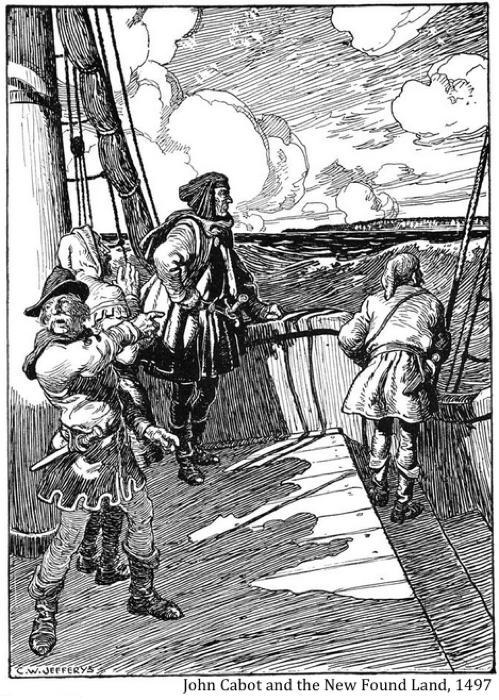
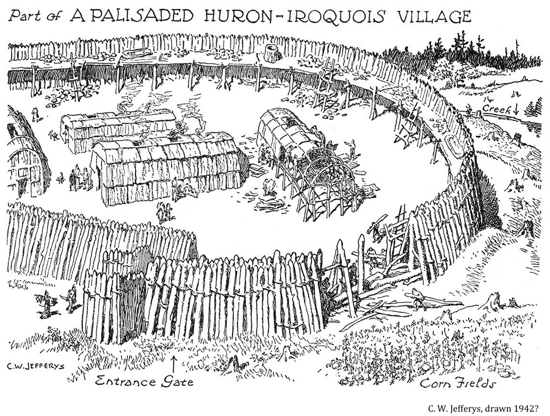
"The French had come to evangelize, the English to trade. The mission of the French Canadians in North America was guided by providence and our historical figures had acquired angelic proportions."
Marcel Trudel, Memoirs of a Less Travelled Road , p. 160
"[Quebec] nationalist historians . . . portrayed French Canadians either as swashbuckling heroes, virtuous missionaries in black robes, or victims crushed under the boot of British conquerors."
George Thombs, preface, Canada's Forgotten Slaves Two Centuries of Bondage
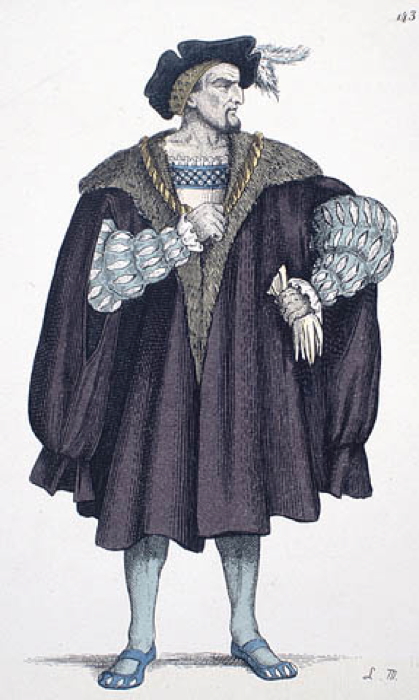
Jacques Cartier, 1534. LAC, Acc. No. 1970-188-27 W.H. Coverdale Collection of Canadiana, C-041570, Léopold Massard 1836
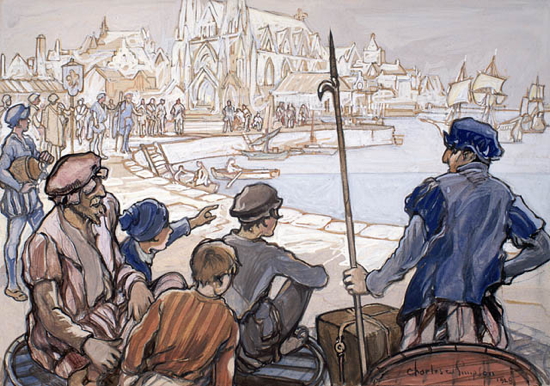
1534 04 00 Saint-Malo, avril 1534. LAC, Acc. No. 1990-324-8, Charles Walter Simpson 1928
"In the seaport of Saint Malo, 'twas a
smiling morn in May,
When the Commodore Jacques Cartier
to the westward sail'd away,
In the crowded old cathedral all
Town were on their knees,
For the safe return of kinsmen from the
Undiscovered seas."
Thomas D'Arcy McGee

1534 Jacques Cartier, 1534-1934 [document philatélique]. Jacques Cartier, 1534-1934 [philatelic record]. Copyright: Canada Post Corporation
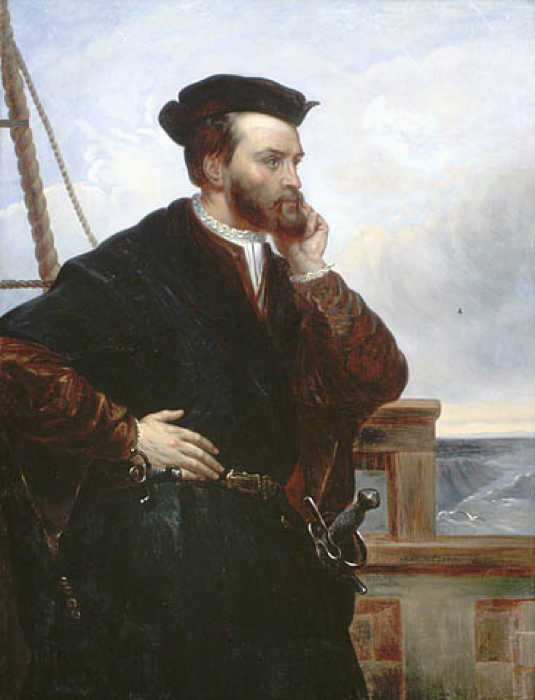
Imaginary portrait of Jacques Cartier. Portrait imaginaire de Jacques Cartier. [Please note that there are no known authenticated portraits of Jacques Cartier.
This portrait by Hamel is copied from a painting done in 1839 by Francois Riss for the town of St. Malo in France. Riss apparently based his portrait on an old sketch in the Bibliotheque nationale (Paris). Just what this sketch was is not known.] ca. 1844, LAC Acc. No. 1997-218-1
"In 1534 the Frenchman Jacques Cartier 'discovered' the mouth of the St. Lawrence, west of Newfoundland, where he was confronted by 'the presence of 1,000 Basque fishing vessels."
Mark Kulansky, Cod: A Biography of the Fish that Changed the World
"[Jacques Cartier's men] had a cross made thirty feet high, which was put in the presence of a number of the Indians on the point at the entrance to this harbour, under the cross-bar of which we fixed a shield with three fleurs-de-lys in relief, and above it a wooden board, engraved in large Gothic characters, where was written, LONG LIVE THE KING OF FRANCE. We erected this cross on the point in their presence and they watched it bring put together and set up. When we had returned to the ships, the chief. . . arrived in a canoe. And pointing to the cross he made us a long harangue, making the sign of the cross with two of his fingers; and then he pointed to the land all around about, as if he wished to say that all this region belonged to him, and that we ought not to have set up the cross without his permission."
Jacques Cartier, 24 July 1534
"[Jacques Cartier's men] had a cross made thirty feet high, which was put in the presence of a number of the Indians on the point at the entrance to this harbour, under the cross-bar of which we fixed a shield with three fleurs-de-lys in relief, and above it a wooden board, engraved in large Gothic characters, where was written, LONG LIVE THE KING OF FRANCE. We erected this cross on the point in their presence and they watched it bring put together and set up. When we had returned to the ships, the chief. . . arrived in a canoe. And pointing to the cross he made us a long harangue, making the sign of the cross with two of his fingers; and then he pointed to the land all around about, as if he wished to say that all this region belonged to him, and that we ought not to have set up the cross without his permission."
Jacques Cartier, 24 July 1534
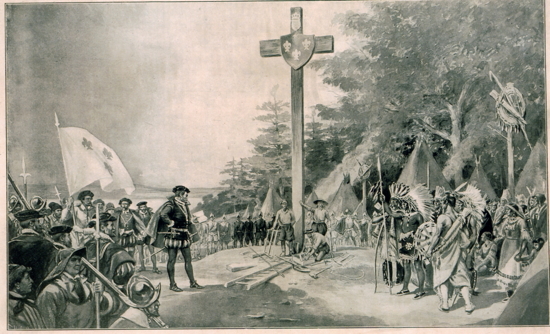
1534 Jacques Cartier Planting the Cross on Canadian Soil, 1534. LAC, C-003278, published in The Standard, Montreal, Henri Julien 25 July 1908
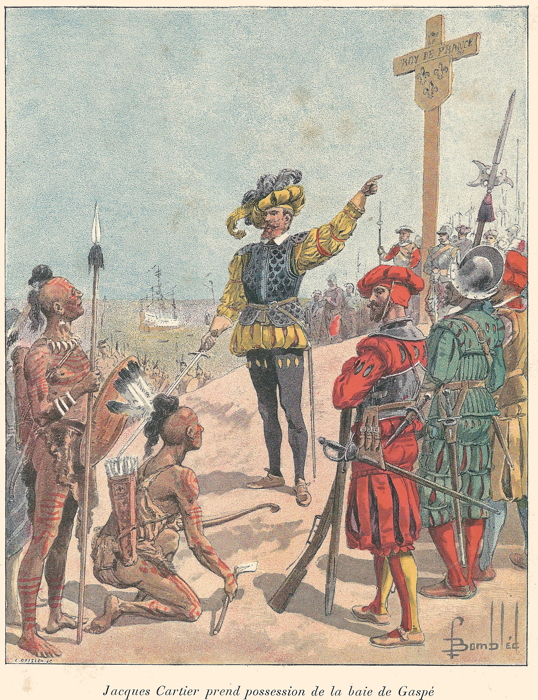
Histoire de la Nouvelle France, Euge`ne Gue´nin, 1900, Public domain, via Wikimedia Commons
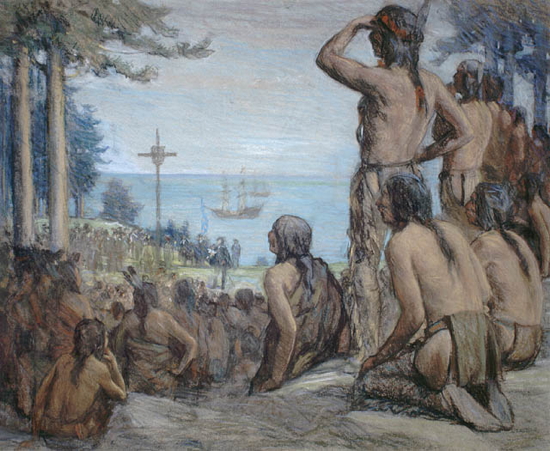
1534 Jacques Cartier dresse une croix, Québec, 1534. Jacques Cartier Erects a Cross, 1534. LAC, Acc. No. 1990-329-4, George Agnew Reid 1916
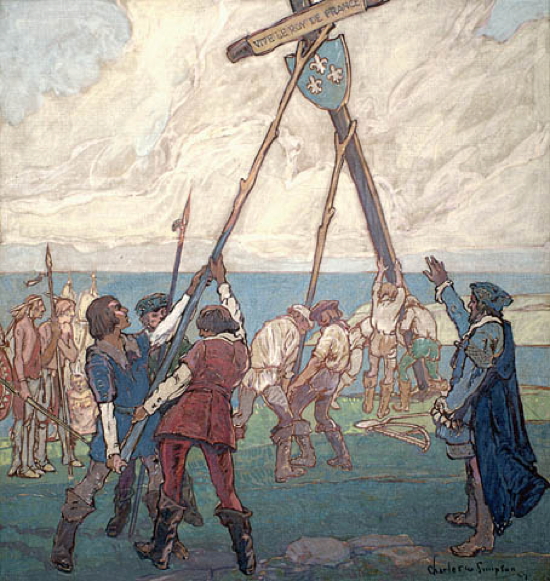
1534 Jacques Cartier à Gaspé, 1534. Jacques Cartier at Gaspé, 1534. LAC, Acc. No. 1991-35-3, Charles Walter Simpson 1927
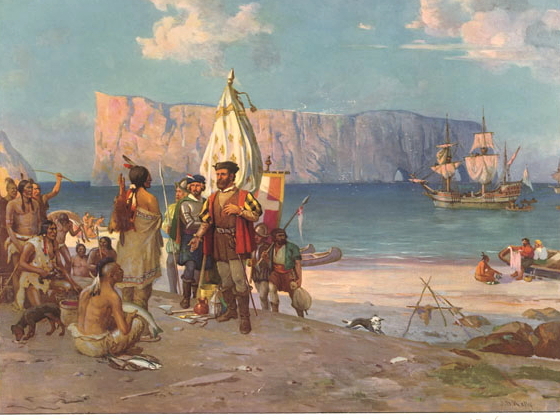
Jacques Cartier at Percé Rock, Gaspé, 1534. Confederation Life Association collection. LAC. painting by John David Kelly, 1932
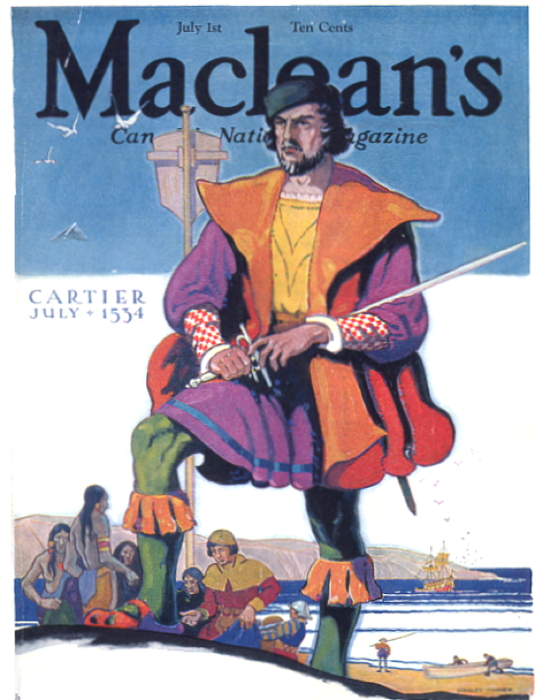
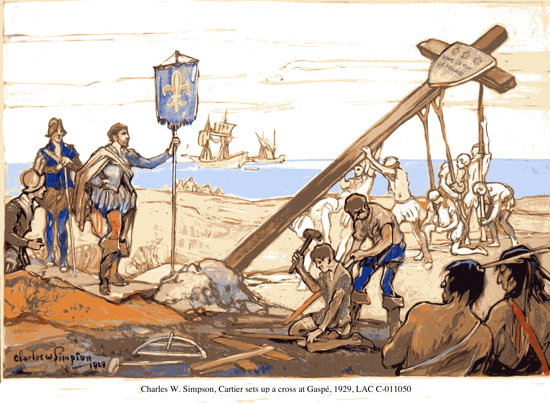
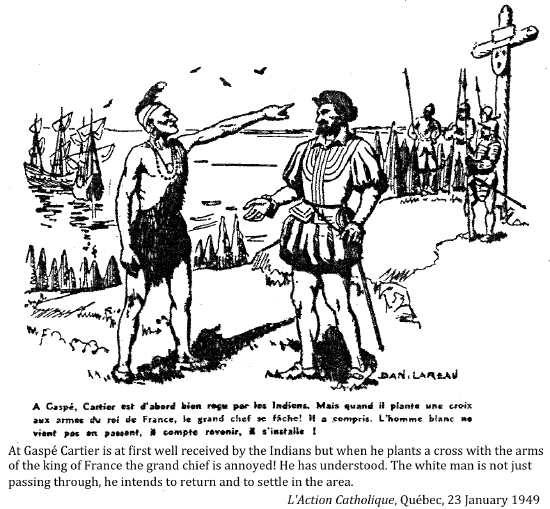

Courtesy of New York Power Authority, Thomas Hart Barton, 1960
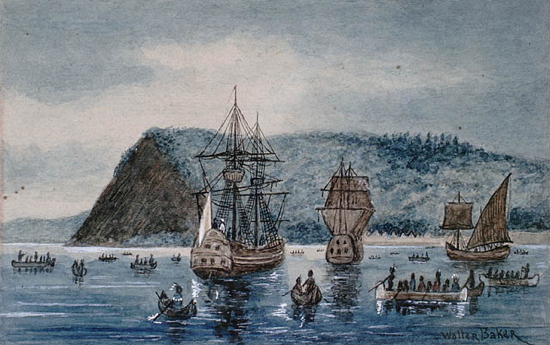
1535 L'arrivée de Jacques Cartier à Stadaconé, 1535. Arrival of Jacques Cartier at Stadacona, 1535. LAC, Acc. No. 1989-606-20, Walter Baker 1890-1912
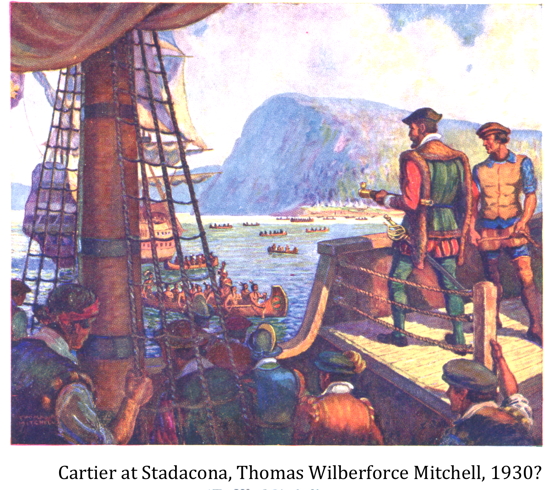
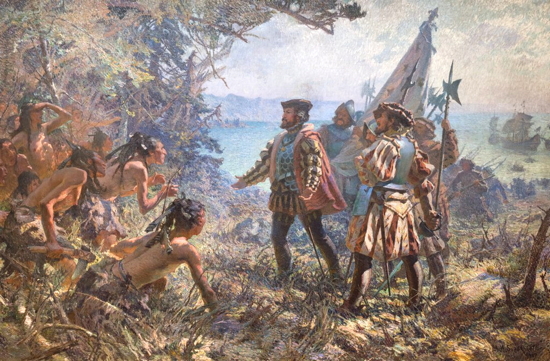
1535 Jacques Cartier Meeting the Indians at Stadacona, Jacques Cartier rencontre les Indiens a` Stadacone 1535, Marc-Aure`le de Foy Suzor-Cote´ artist, 1907, Musée national des beaux-arts du Québec, Public domain, via Wikimedia Commons
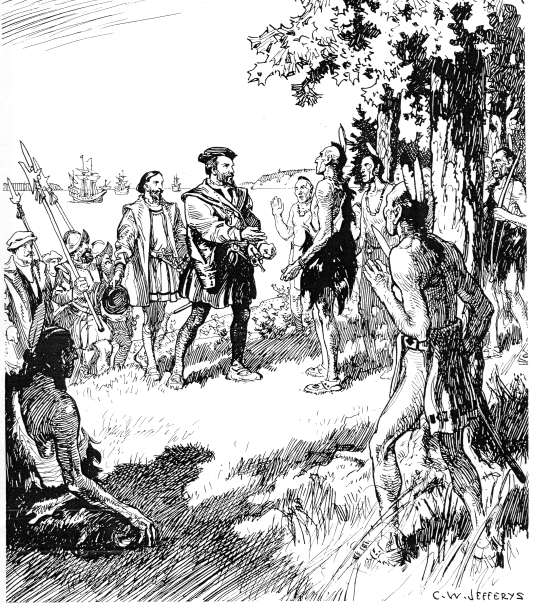
Cartier meets the Indians of the St. Lawrence, 1535. LAC, Acc. No. 1972-26-1394, Charles W. Jefferys, 1920s or 1930s?
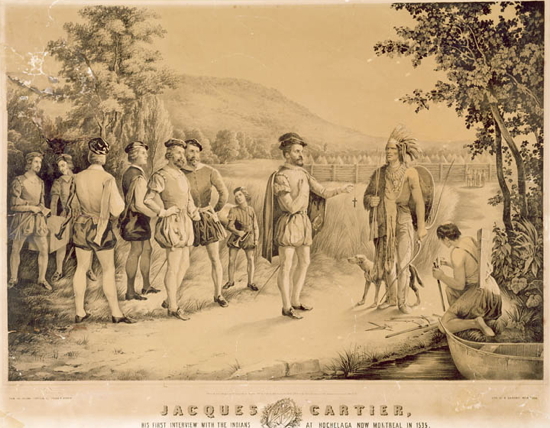
1535 Première rencontre de Cartier avec les Amérindiens à Hochelaga. Cartier's first interview with the Indians at Hochelaga. LAC, Acc. No. 1970-188-681 Collection de Canadiana W.H. Coverdale, Andrew Morris 1850
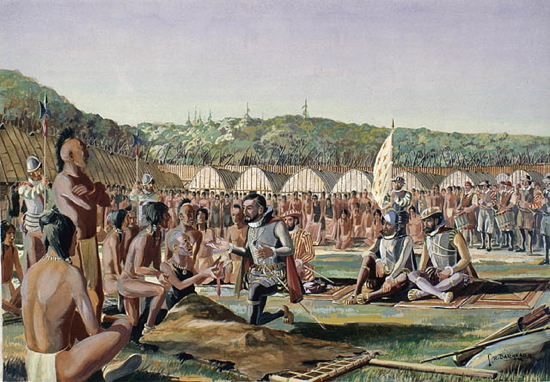
1535 Cartier à Hochelaga (Montréal). Jacques Cartier at Hochelaga (Montreal). LAC, 1983-45-7 / C-010522, Lawrene R. Batchelor ca. 1933
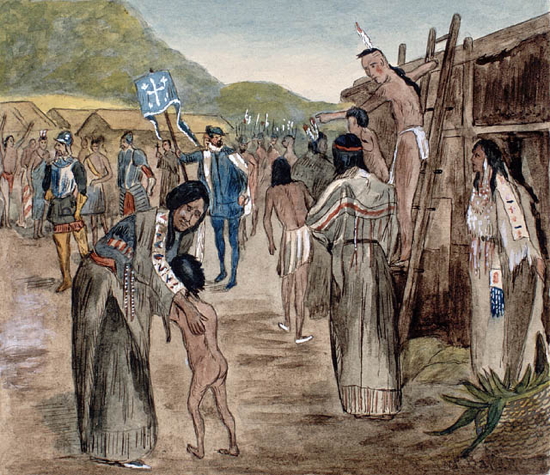
Arrival of Jacques Cartier at Hochelaga, 1535. L'arrivée de Jacques Cartier à Hochelaga, 1535. LAC Acc. No. 1989-603-3, Walter Baker, 1890-1912
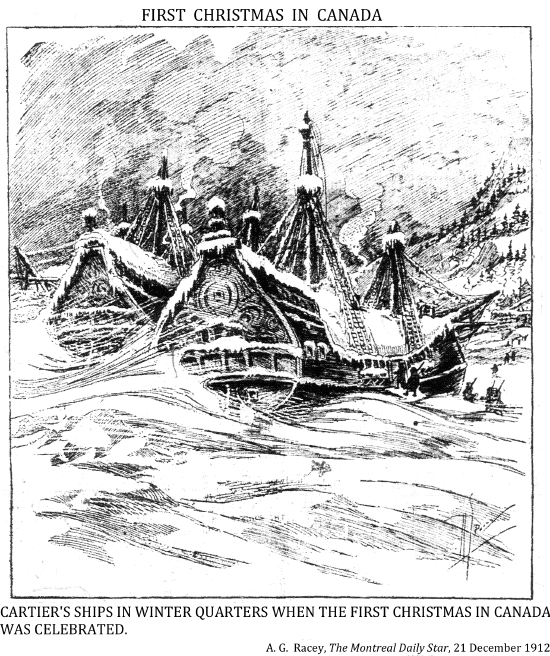
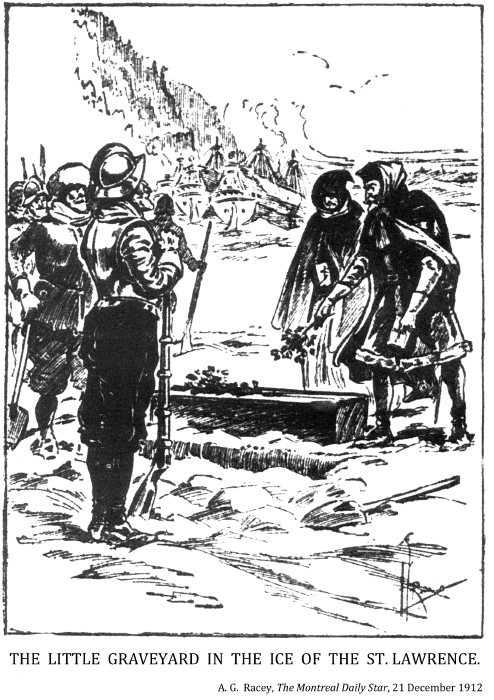
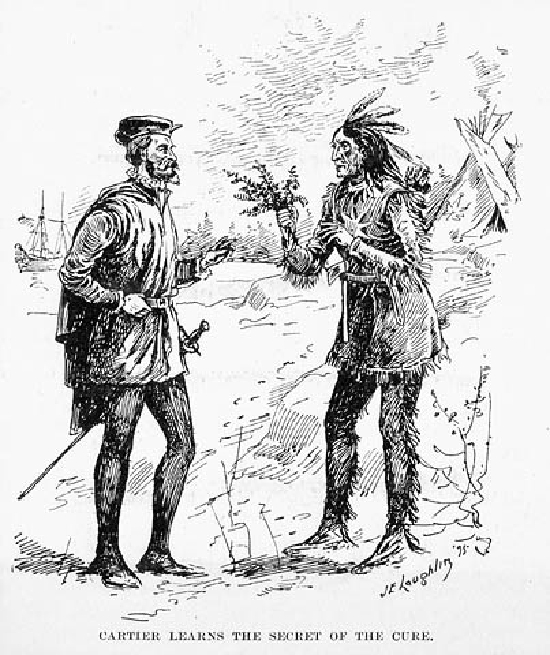
1535 Cartier learns the secret of the Cure. LAC, C-120844, Published in The Standard Montreal, J. E. Laughlin after 1895
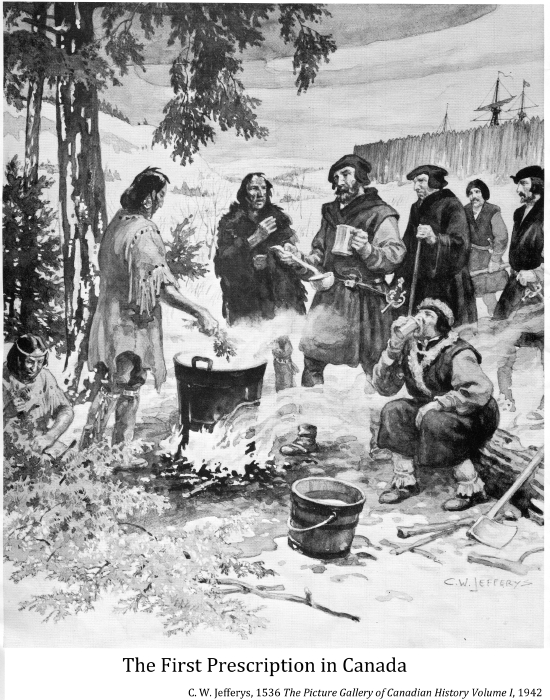
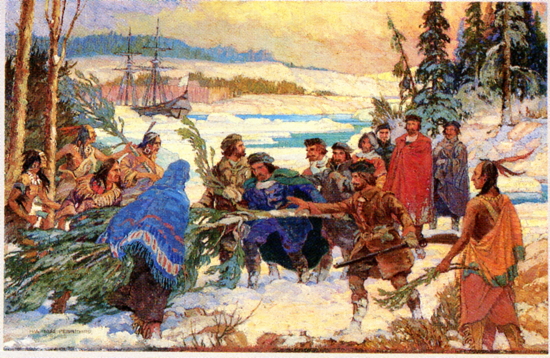
Les vertus de l'annedda (Indiens donnant à Jacques Cartier le remède au scorbut, 1534). The Virtue of the Tree Annedda (Indians showing Jacques Cartier the Cure for Scurvy, 1534). LAC Acc. No. 1990-324-5, Hal Ross Perrigard, 1928
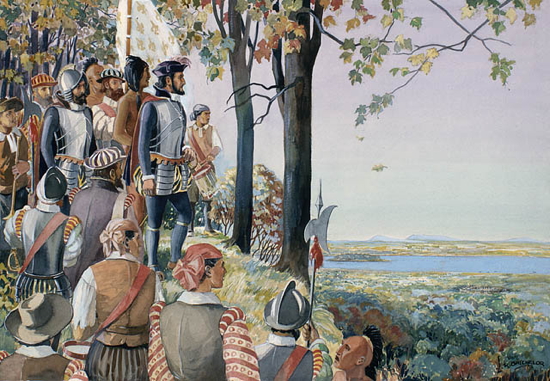
Jacques Cartier Sur le Mount Royal en Octobre 1535, La Voix Nationale , Montréal, Octobre 1935
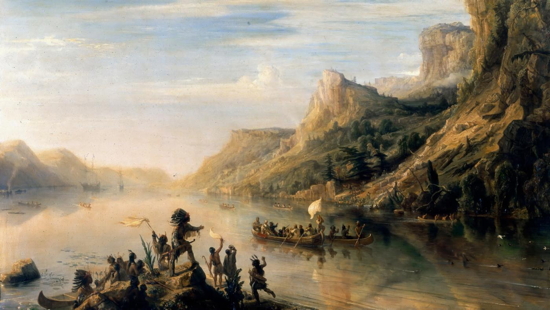
Jacques Cartier découvre et remonte le fleuve Saint-Laurent au Canada en 1535, LAC, Acc. No. 1970-188-691, Jean Antoine Théodore de Gudin, 1850
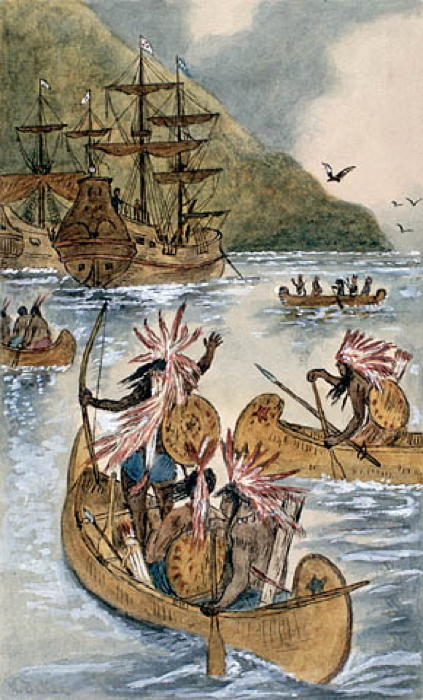
1541 Le retour de Jacques Cartier à Stadaconé, 1541. Jacques Cartier's Return to Stadacona, 1541. LAC, Acc. No. 1989-603-4, Walter Baker 1890-1912
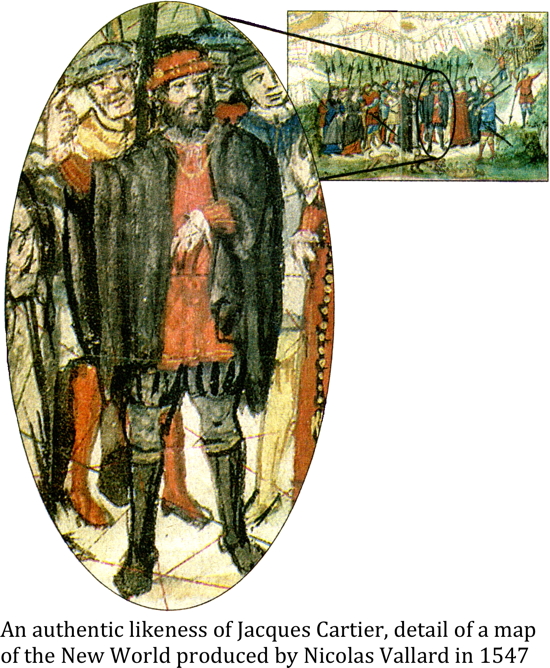
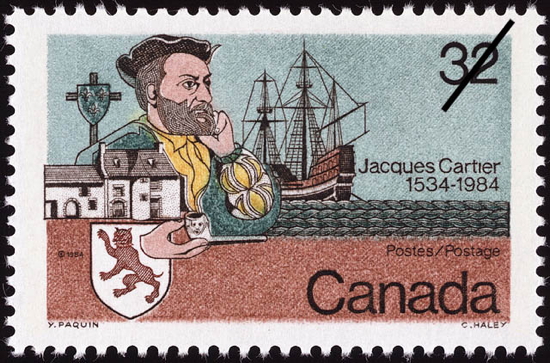
1541 Jacques Cartier, 1534-1984, LAC, Copyright: Canada Post Corporation, 1984
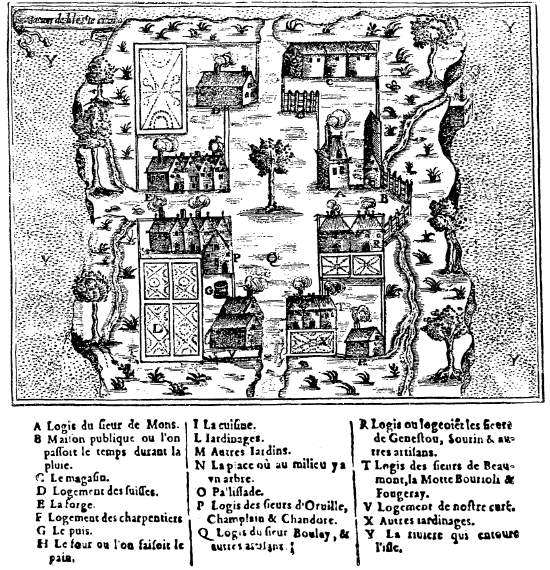
1604-05 Isle de sainte Croix, Habitation de Lile S'te Croix. This sketch shows De Monts' house (B), the public house (C-M), the magazine, lodgings, forge, well, bake-ovens, kitchens and gardens (P-T), lodgings for Champlain, other officials and craftsmen, and the priest's house (V). LAC, e010764742, Samuel de Champlain 1613
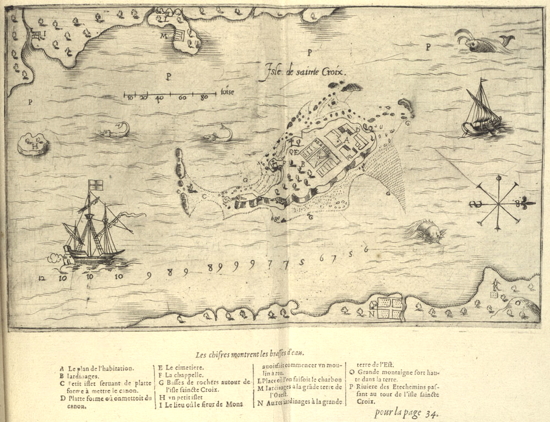
1604-05 Isle de sainte Croix, Habitation de Lile S'te Croix, LAC, e010764741, Samuel de Champlain 1613
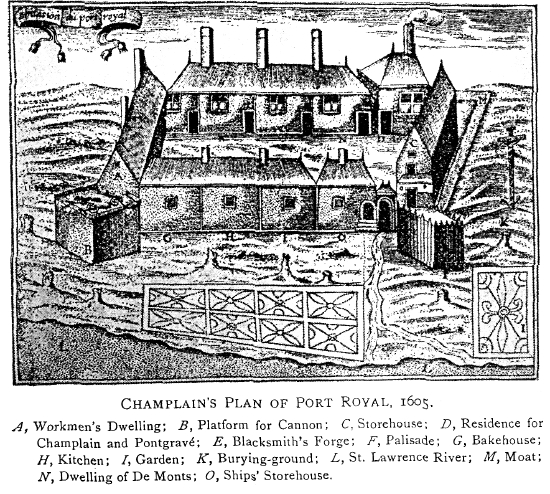
1605 Abitation du port royal, LAC, e010764747, Samuel de Champlain 1613
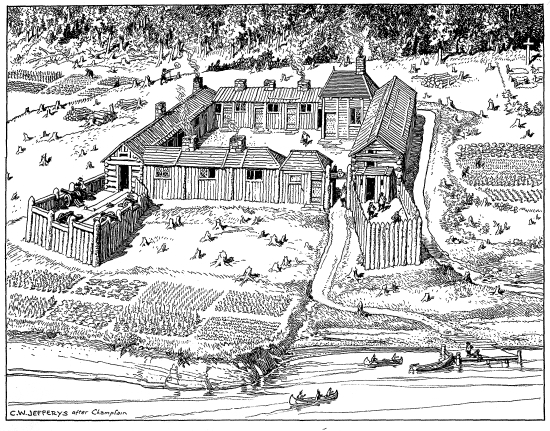
The Habitation of Port Royal, 1605. LAC, Acc. No. 1972-26-641, Charles W. Jefferys 1920s or 1930s?
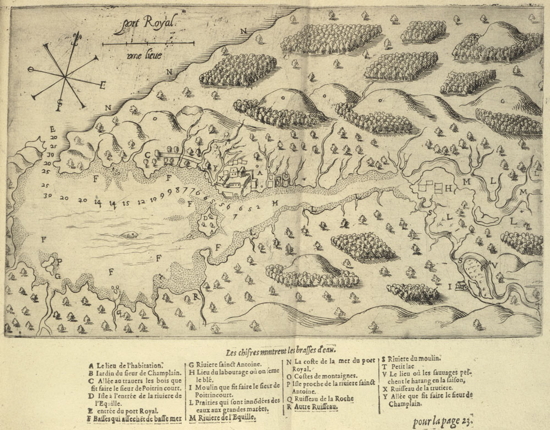
1605 Port Royal, LAC, e010764738, Samuel de Champlain 1613
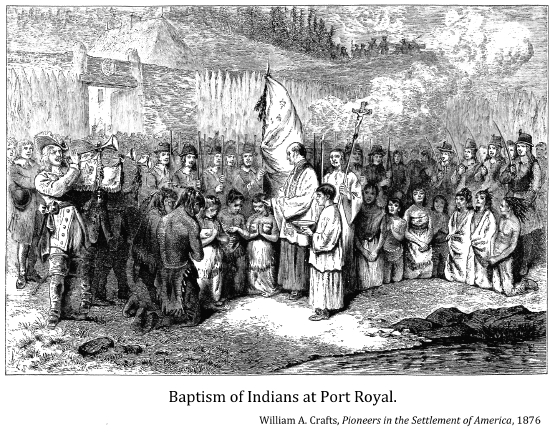
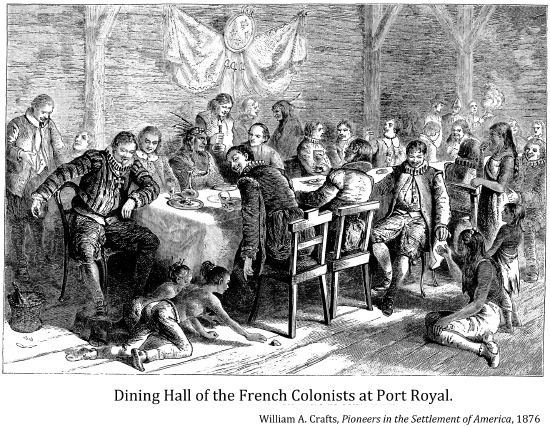

1606 L'Ordre de Bon Temps, 1606. The Order of Good Cheer. LAC, Acc. No. 1996-282-3, Charles William Jefferys 1925
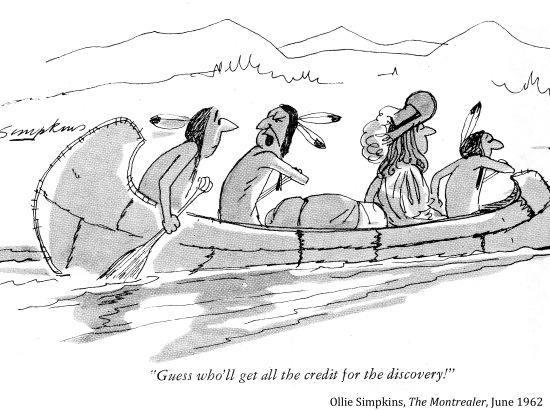
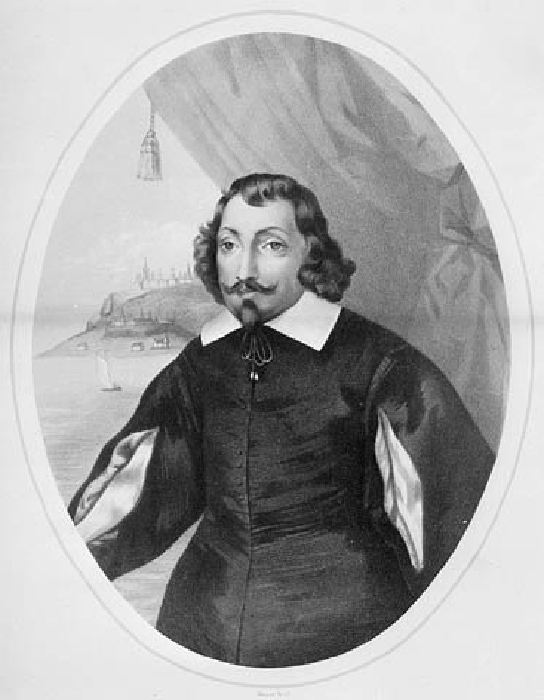
1608 Faux portrait de Samuel de Champlain. False portrait of Samuel de Champlain. LAC, Acc. No. C-006643, Louis-César-Joseph Ducomet 1854
"No other European colony in America is so much the lengthened shadow of one man as Canada is of the valiant, wise, and virtuous Samuel de Champlain."
Samuel Eliot Morison
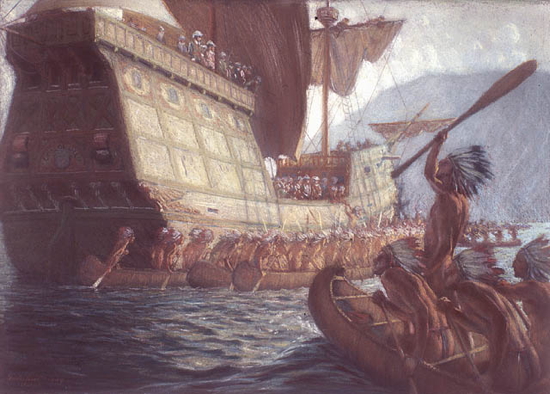
1608 L'arrivée de Champlain à Québec en 1608. Arrival of Champlain at Québec. LAC, 1990-329-5, George Agnew Reid 1909
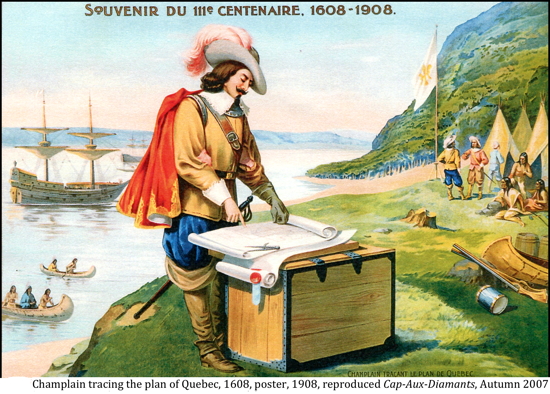
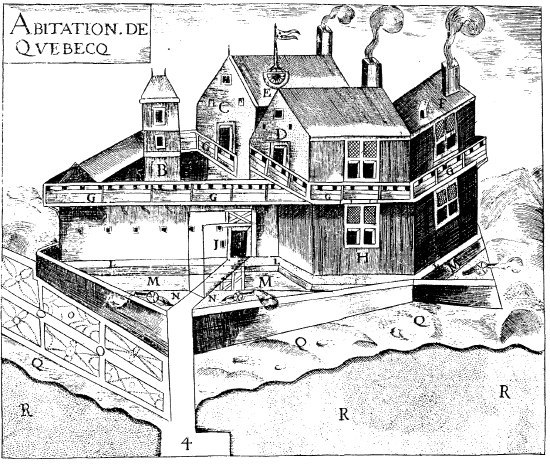
1608 Abitation de Québec. The first habitation at Quebec, LAC, C-009711, after original engraving by Samuel de Champlain in Paris, 1613, it includes a sun dial, a smithy, Champlain's lodgings, a pigeon loft, workmen's lodgings, a gate and drawbridge, a moat and a walkway.
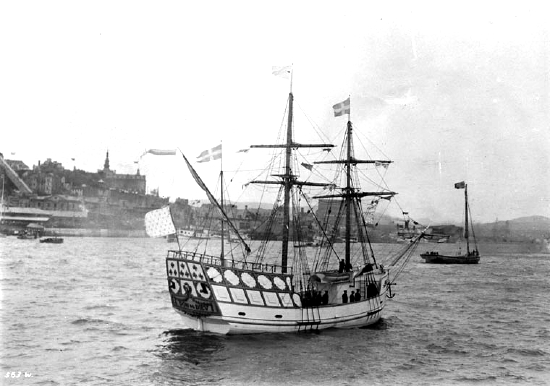
"Don de Dieu" (Champlain's ship built for the tercentennary) .LAC, PA-020845, John Woodruff, 1908
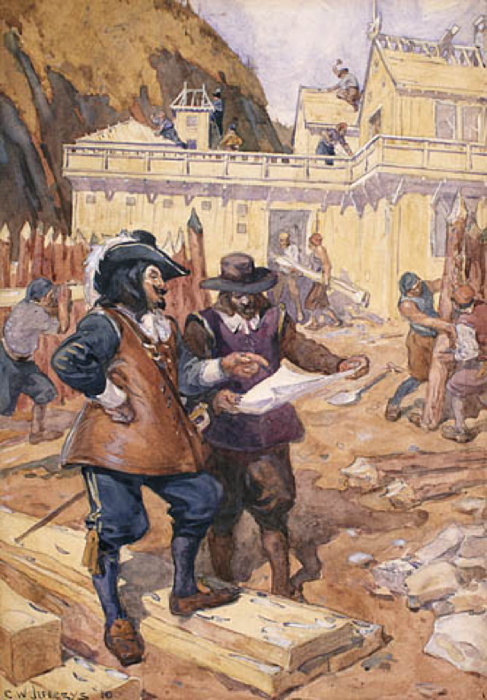
1608 Champlain supervisant la construction de sa résidence, Québec, 1608. Champlain superintending the building of his habitation, 1608. LAC, Acc. No. 1972-26-760 / C-073716, Charles William Jefferys ca. 1925
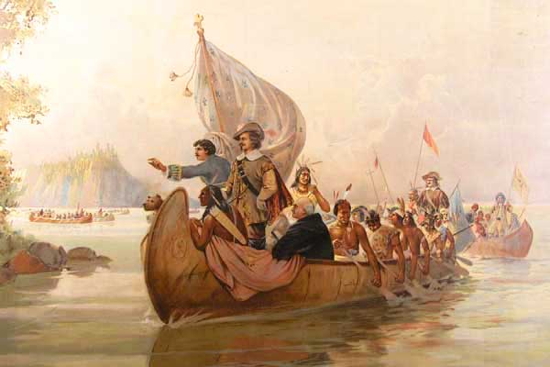
Champlain Before Quebec, 1608. LAC Acc. No. 1935-49, John David Kelly, 1895
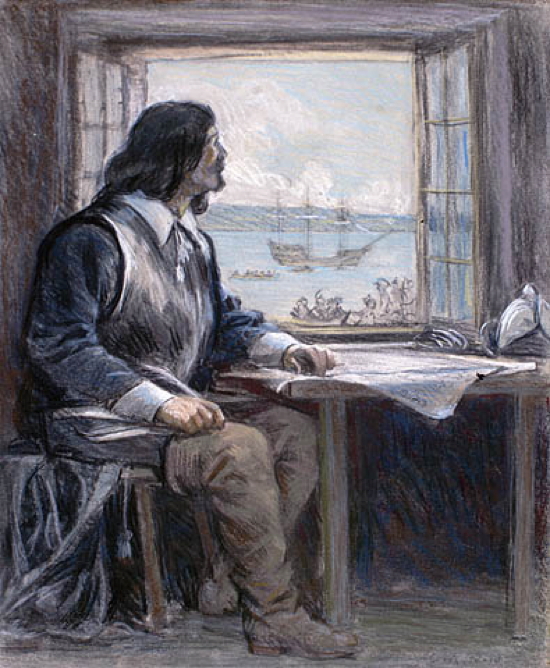
Sameul de Champlain. Cette oeuvre correspond à la description de « Champlain Dreams of the way to Cathay », cataloguée 1931 dans « G. A. Reid, Canadian Artist », de Muriel Miller Miner (Toronto, The Ryerson Press, 1946) : « L'explorateur aux cheveux noirs, en cuirasse d'acier, assis à une table près d'une fenêtre ouverte de son habitation; par la fenêtre, on voit son voilier trois-mâts, Le Don de Dieu, ancré. This work fits the description of "Champlain Dreams of the way to Cathay" listed as 1931 in Muriel Miller Miner's G. A. Reid, Canadian Artist (Toronto: The Ryerson Press, 1946). "The black-haired explorer in steel cuirass sits at table in an open window of L'Habitation; through the window his three-masted sailing vessel, Le Don de Dieu, is seen lying at anchor." LAC, Acc. No. 1990-329-2, George Andrew Reid, ca. 1908
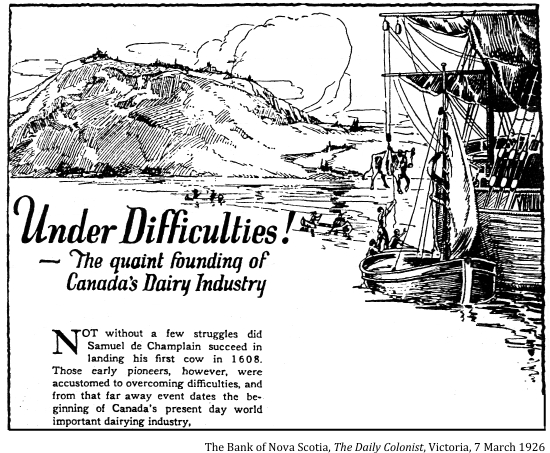
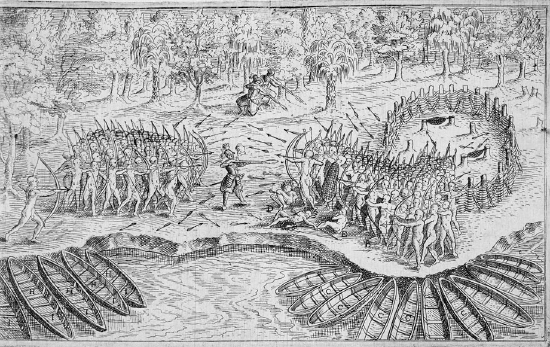
1609 Defaite des Yroquois au Lac de Champlain, 1609. Champlain's Fight with the Iroquois. LAC, 1972-26-1415, Samuel de Champlain 1613
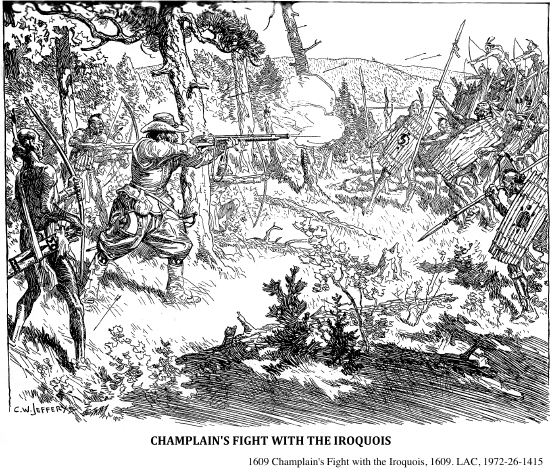
1609 Defaite des Yroquois au Lac de Champlain, 1609. Champlain's Fight with the Iroquois. LAC, 1972-26-1415, Samuel de Champlain
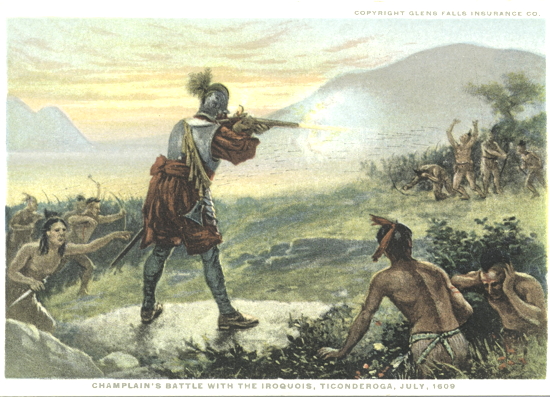
Champlains Battle with the Iroquois, Ticonderoga, postcard, July 1609, New York Public Library, Public domain, via Wikimedia Commons
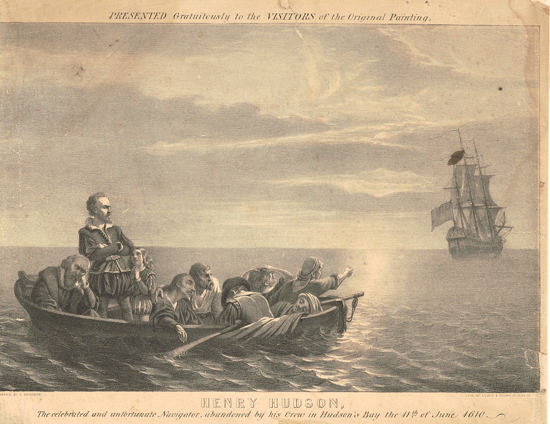
F. Davigon, Henry Hudson The celebrated and unfortunate navigator, abandoned by his crew in Hudson's Bay the 11th of June 1610, Library of Congress LC-DIG-ds-05657, published in New York between 1840? And 1860?,
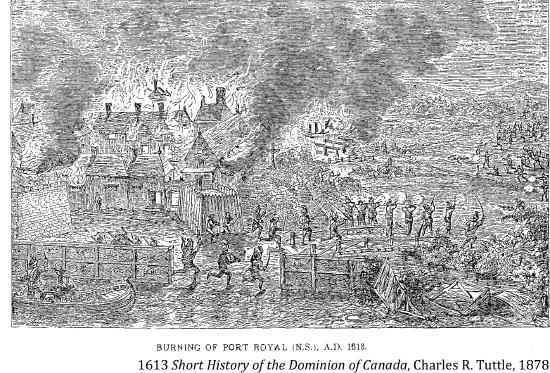
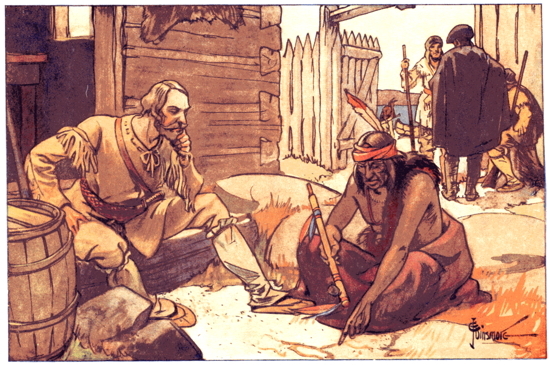
1613 A Clue to the Western Sea, E. J. Dinsmore, A Picture History of Canada, 1942
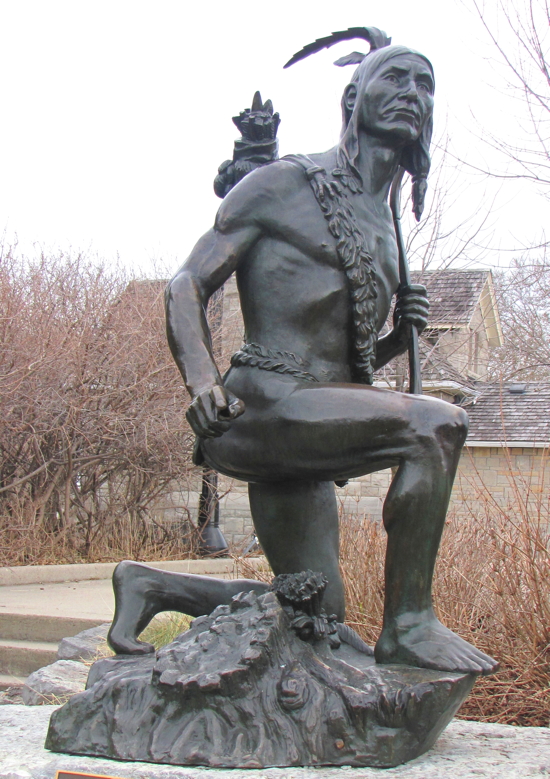
Anishnawabe Scout, erected to show how aboriginal peoples helped Samuel de Champlain navigate the Ottawa River, 1613. Hamilton MacCarthy 1918
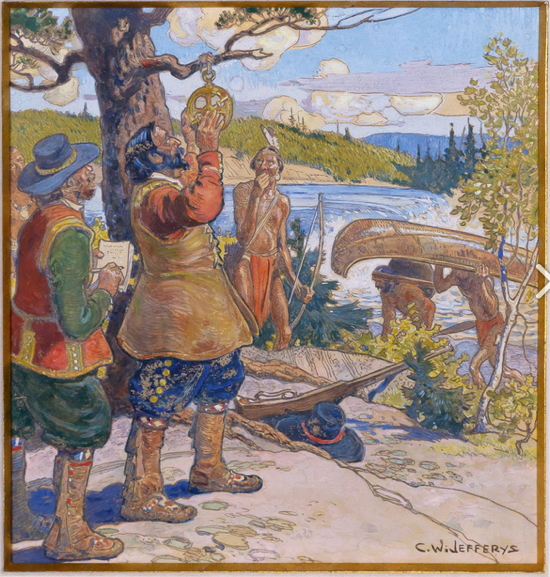
1613 Champlain à recours a son astrolabe, sur l'Outaouais, 1613. Champlain with Astrolabe on the West Bank of Ottawa River, 1613. LAC, 1972-26-84, Charles William Jefferys 1920s or 1930s?
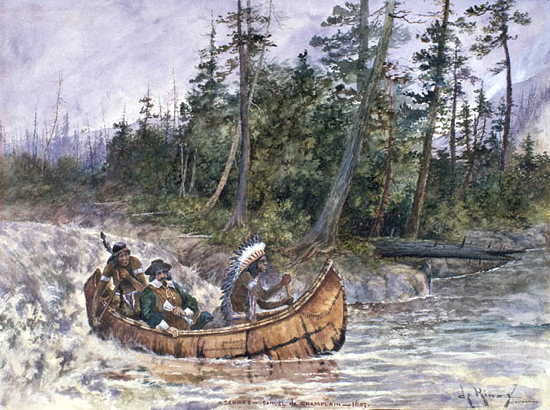
1613 Champlain en canot indien, 1603. Champlain in an Indian Canoe. LAC, Acc. No. 1993-343-3, John Henry de Rinzy ca. 1897-1930
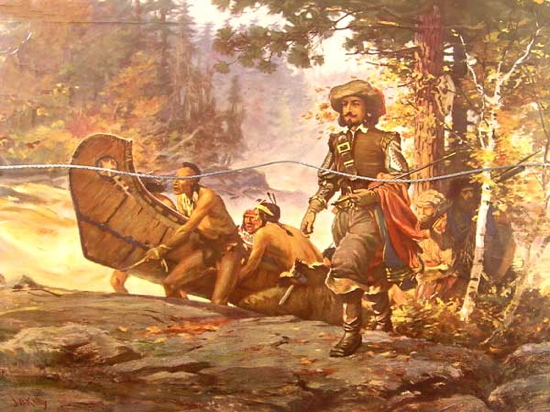
Exploring the Unknown, Champlain on the Upper Ottawa, 1613, J.D. Kelly, 1900?
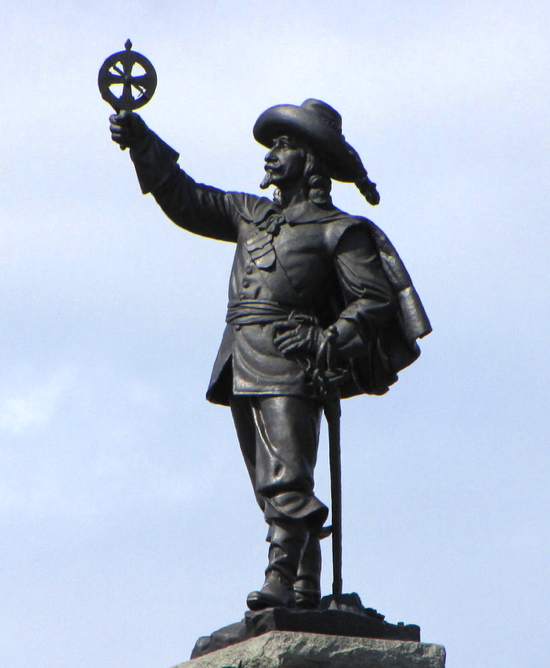
Champlain Statue, Ottawa, Hamilton MacCarthy, 1915 [The monument was erected at the same spot where Champlain made his solar observation in 1613. It was accompanied by a plaque that said the statue was meant to commemorate "the advent into Ontario of the white race."]
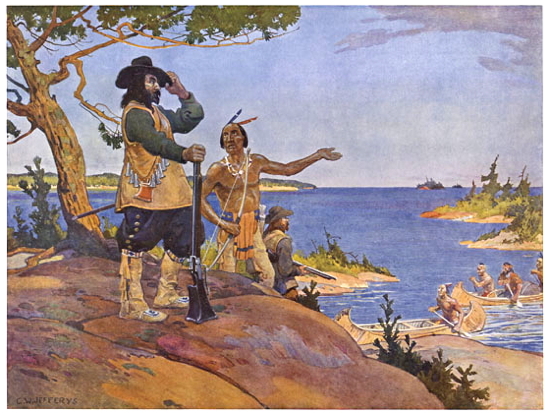
1613 Champlain discovers Georgian Bay. LAC, Acc. No. 1996-282-2, Charles William Jefferys 1925

1615 Champlain qui échange avec les Indiens. Champlain Trading with the Indians. LAC, Acc. No. 1972-26-1457, Charles William Jefferys 1911
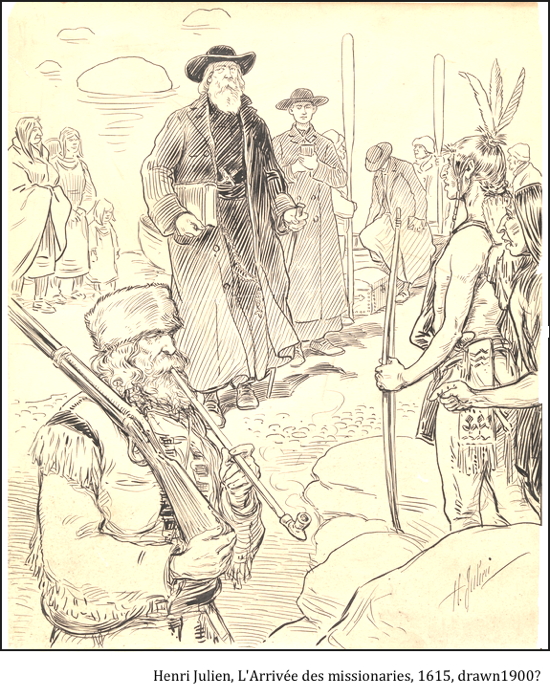
For more illustrations of the fur trade in New France see the Fur Brigade theme.
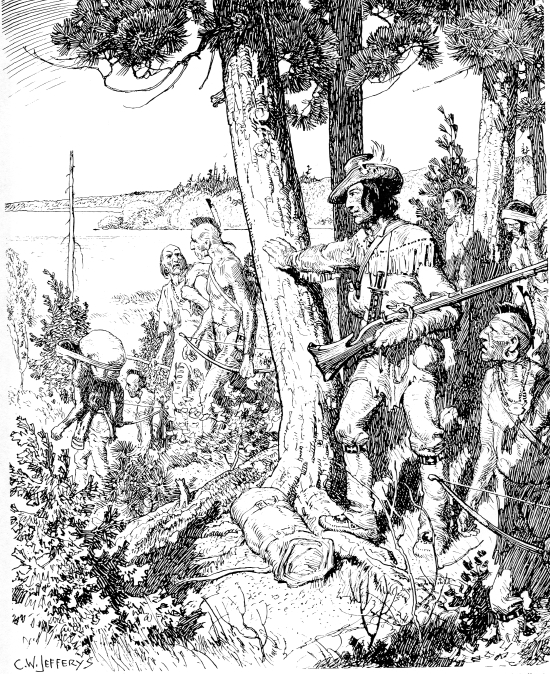
Etienne Brûlé at the mouth of the Humber, 1615. LAC, Acc. No. 1972-26-1395, Charles W. Jefferys, 1920s or 1930s?
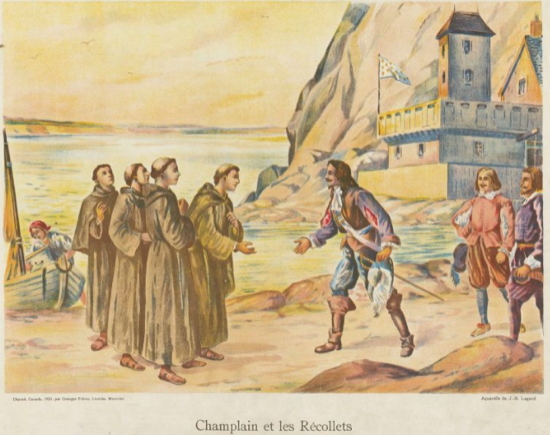
Champlain et les Recollets Montre´al, Jean-Baptiste Lagacé, June 1615, National Archives of Québec, 1921 et 1933
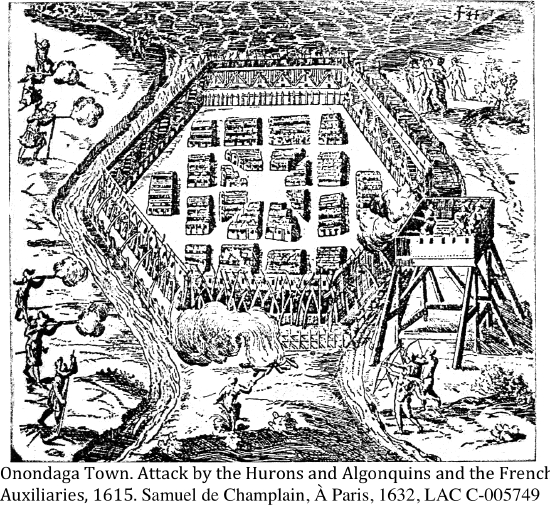
%20John%20David%20Kelly%20TRL%20948-1%20Cab%20III.jpg)
Champlain in Georgian Bay, Lake Huron, John David Kelly, Toronto Research Library 948-1 Cab III, 1615
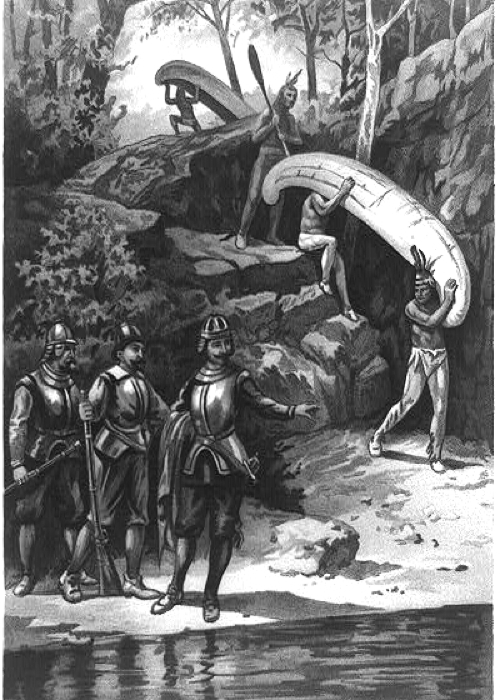
Champlain in Georgian Bay, Lake Huron, John David Kelly, Toronto Research Library 948-1 Cab III, 1615
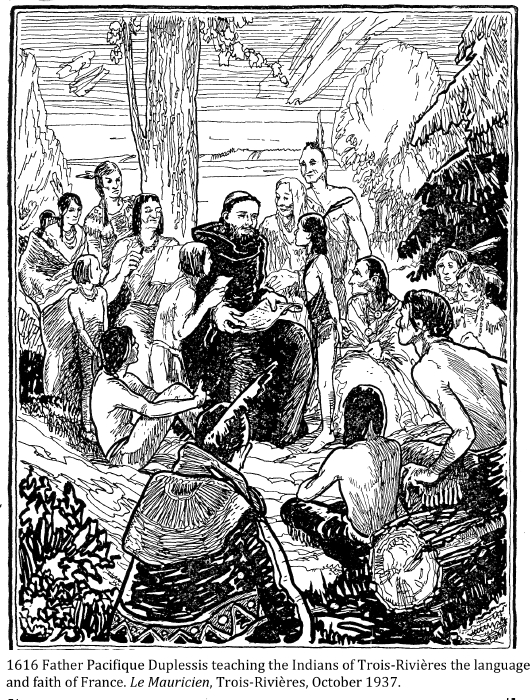
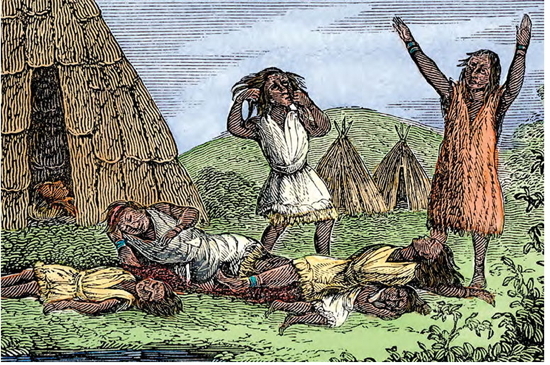
Smallpox struck the Indigenous population living near Tadoussac, an early fur trading post, 1616
https://www.canadashistory.ca/explore/science-technology/a-pox-on-our-nation?utm_source=Canada

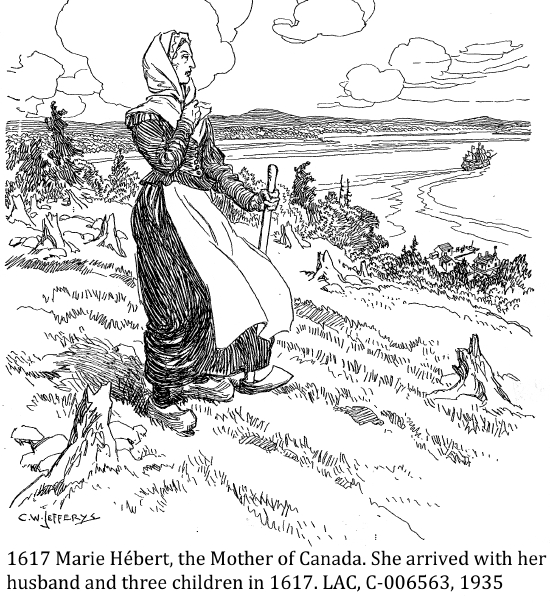
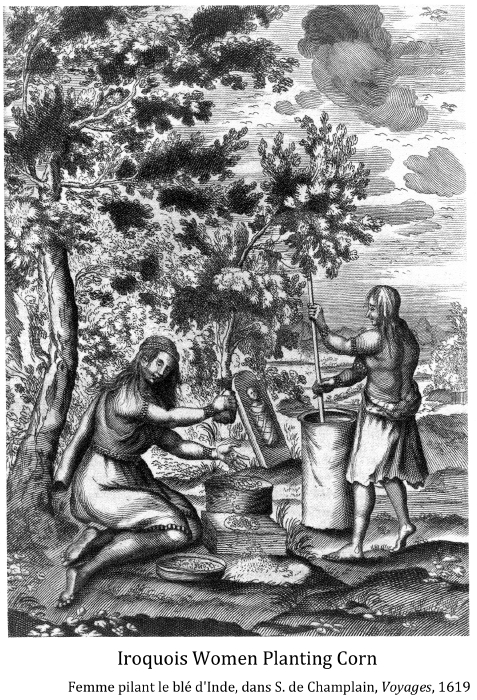
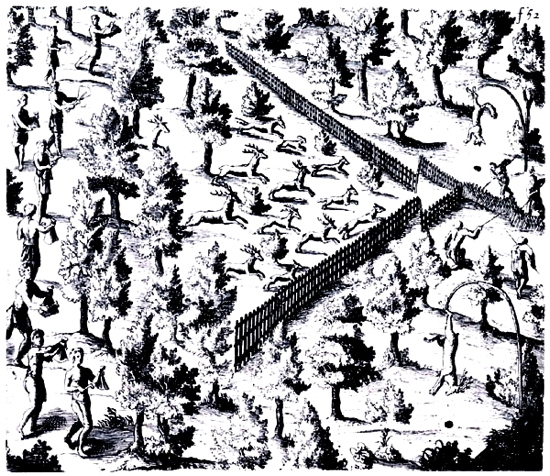
Huron deer hunt, Samuel Champlain, 1619, LAC C-113066
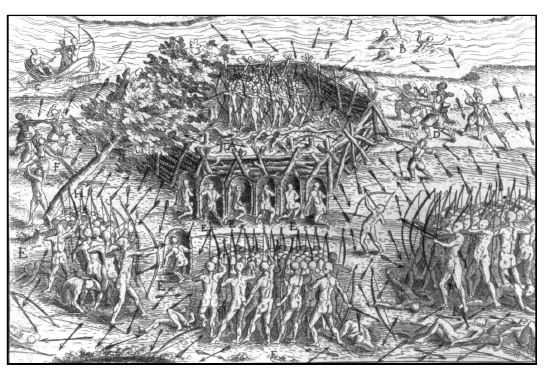
Warfare, Champlain, Les Voyages, 1619, LC2002699496
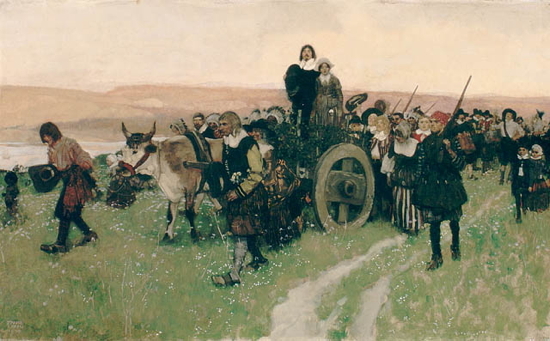
1620 L'arrivée de madame Champlain à Québec, 1620. Arrival of Madame Champlain at Quebec 1620. Acc. No. 1996-23-3, Craig Frank 1909
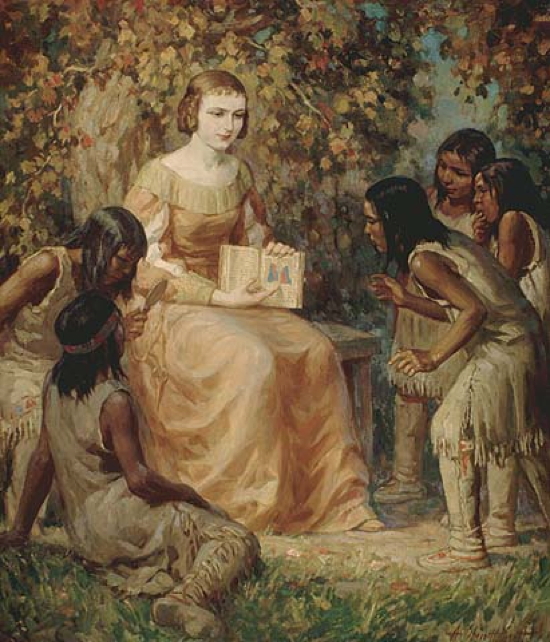
1620 Madame Champlain enseignant aux enfants indiens, 1620. Madame Champlain teaching Indian Children, 1620. LAC, Acc. No. 1991-36-1, Adam Sheriff Scott unknown
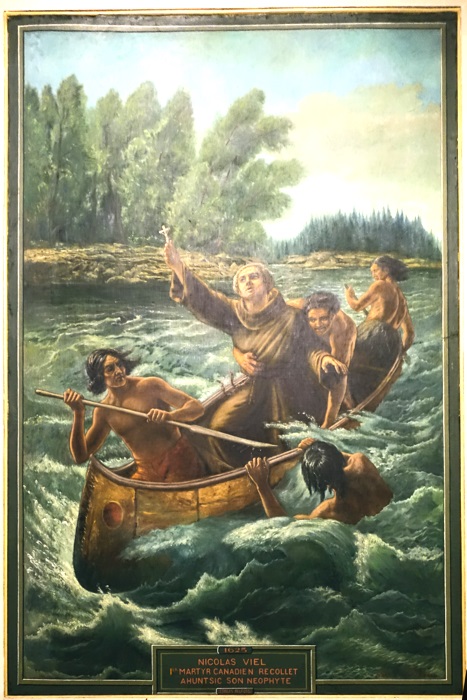
[Recollet missionary Nicolas Viel was killed by Huron Indians on his way to Quebec in 1625.]
Painting by Georges Delfosse, Guilhem Vellut from Paris, France, CC BY 2.0 https://creativecommons.org/licenses/by/2.0, via Wikimedia Commons


Canadian Histories Series, Imperial Tobacco Co. of Canada
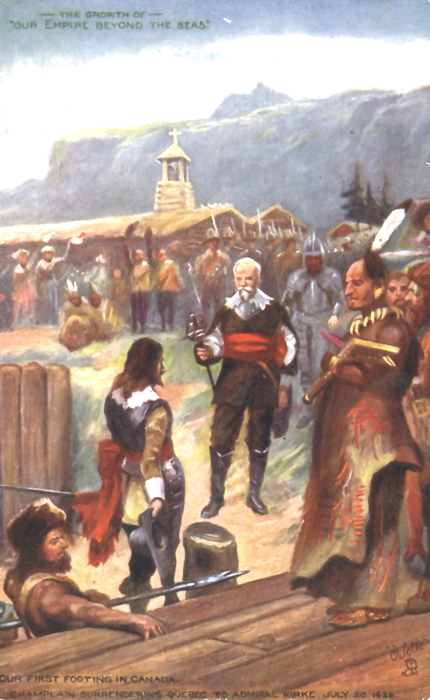
Champlain surrendering to Admiral Kirke, postcard, 20 July 1629, produced around 1911, Public domain, via Wikimedia Commons
"The interlocking of commerce, colonization, and conversion was Champlain's plan, sustained against adversity, failures, and the first English conquest by the Kirke brothers in 1629."
Desmond Morton
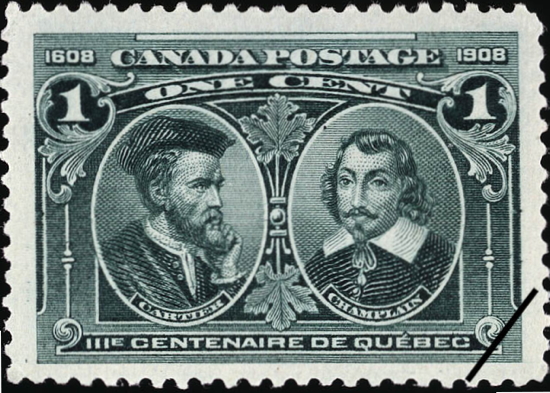
IIIe centenaire de Québec, 1608-1908. Cartier, Champlain [document philatélique]. IIIe centenaire de Québec, 1608-1908. Cartier, Champlain [philatelic record]. LAC, Copyright: Canada Post Corporation
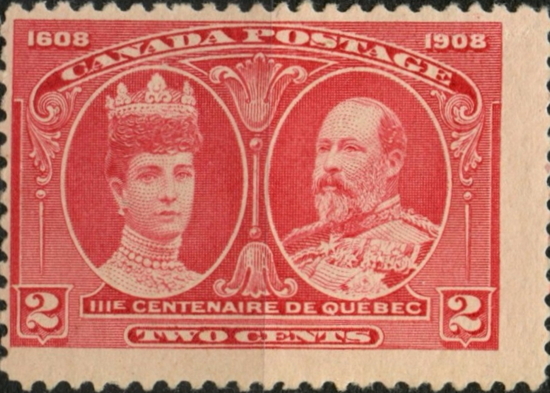
[Edward VII & Queen Alexandra] [philatelic record]. Copyright: LAC, Canada Post Corporation. 16 July 1908
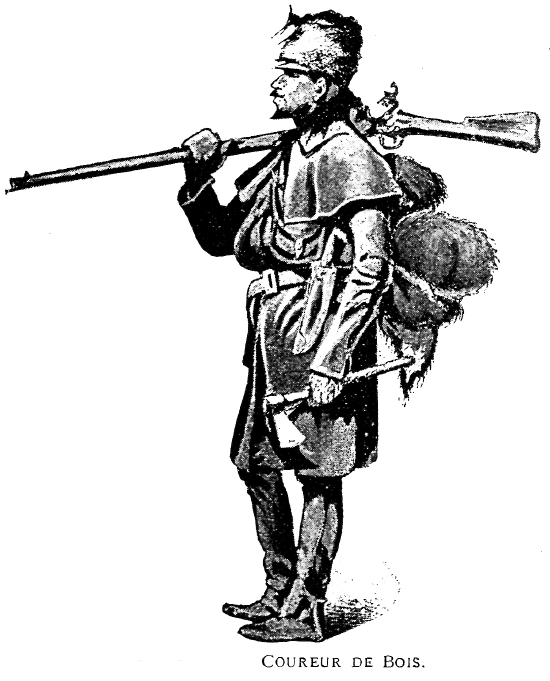
"American conditions of life emancipated the French peasants who crossed the Atlantic. With liberty forever beckoning through the trees and up the waters which flowed past their door, how could they be ridden by feudal lords? If anyone found life in the colony too cramping now power on earth could hold him from running away into the woods to live a wilder life of freedom with the Indians."
A. L. Burt

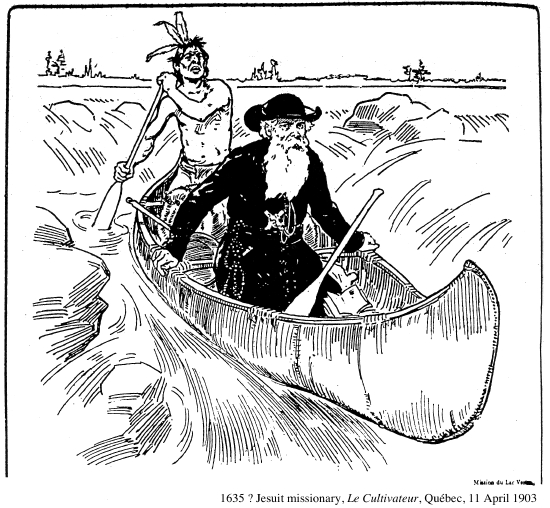
"In Canada, not a cape was turned, nor a mission founded, nor a river entered, nor a settlement begun, but a Jesuit led the way."
George Bancroft
"The constant pattern of our early history thus emerges with great clarity; a strong farming settlement within a small domain; and surrounding this domain, satisfying an extraordinary need for action, for conquest, for missionary work, a vast unbounded territory for adventure, heroism, and glory. All around the pastoral, the immense epic."
Abbé Groulx
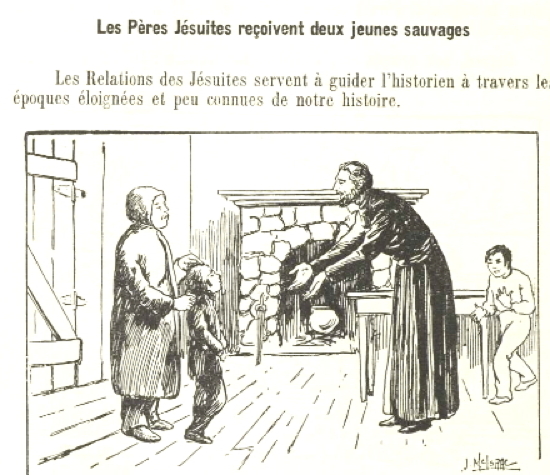
The Jesuit Fathers receive young savages.
Jesuits, 21 Decembre 1632, Élie de Salail, 366 Anniversaires Canadiens, James McIsaac, 1949
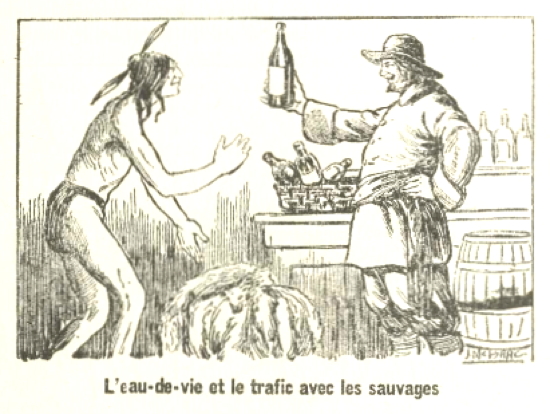
Trafficking brandy with the savages.
Élie de Salail, 366 Anniversaires Canadiens, James McIsaac, 1949
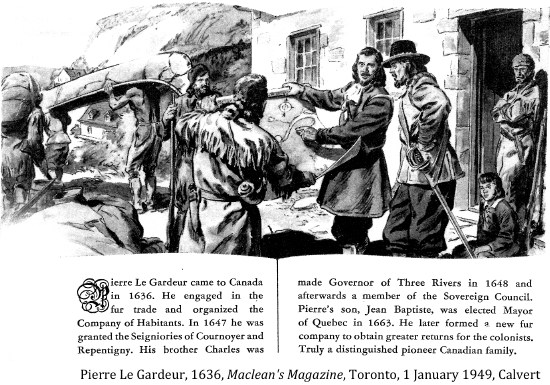
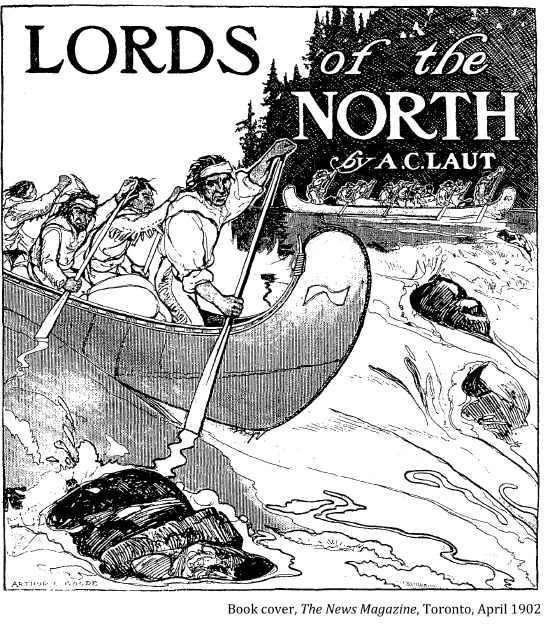
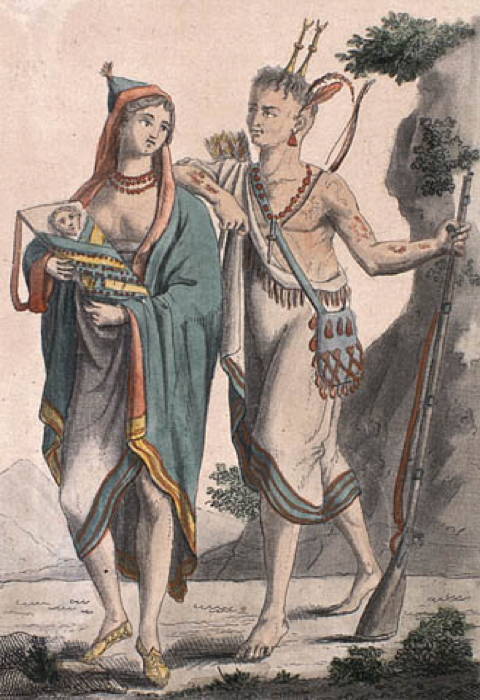
Homme et femme Iroquois. LAC, Acc. No. 1970-188-148 W.H. Coverdale Collection of Canadiana, Jacques Grasset de Saint-Sauveur, 1801
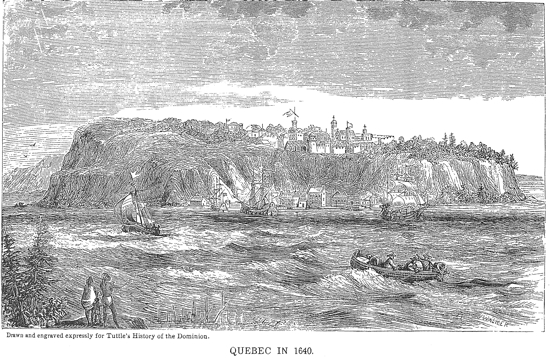
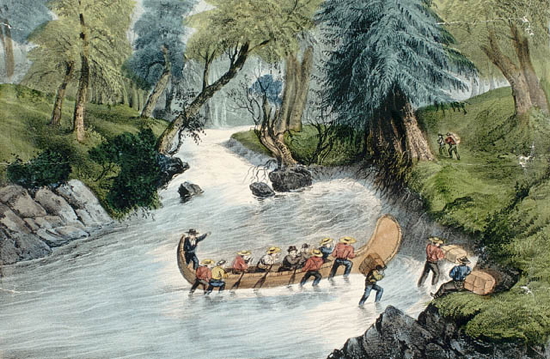
1640 Quebec, Short History of the Dominion of Canada, Charles R. Tuttle, 1878
Canadian Voyageurs Walking a Canoe Up a Rapid. Voyageurs canadiens poussant un canot dans un rapide. LAC Acc. No. 1934-380-1, William Henry Bartlett, 1870-73
"Quebec was comfortable, but the woods were free, and freedom was the breath of their [the coureurs de bois] nostrils."
Agnes Repplier
"It was the one great river which led from the eastern shore into the heart of the continent. It possessed a geographical monopoly; and it shouted its uniqueness to adventurers . . . The dream of the commercial empire of the St. Lawrence runs like an obsession through the whole of Canadian history."
Donald Creighton, The Empire of the St. Lawrence
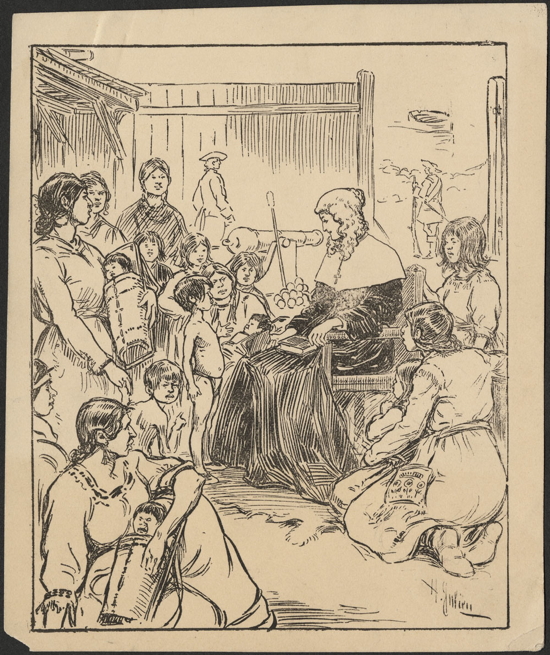
Miss Jeanne Mance Teaching Natives. LAC Acc. No. 1984-164-91, Henri Julien, 1880-1908
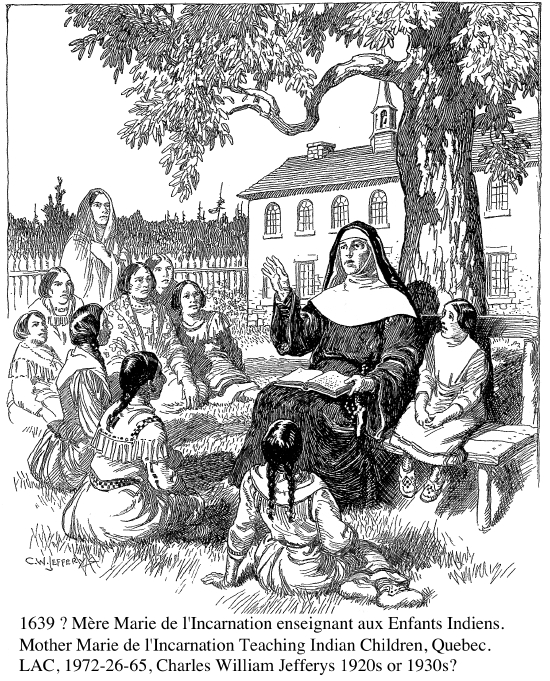
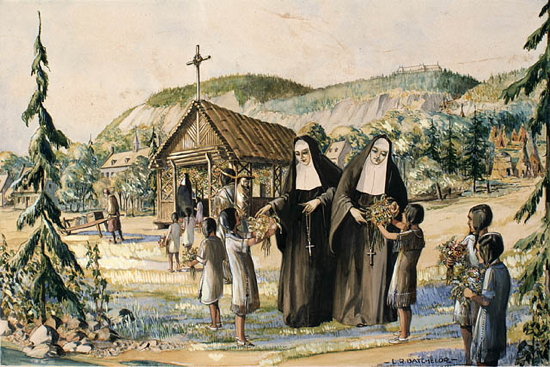
1640 Premières religieuses ursulines avec des étudiantes indiennes, à Québec. First Ursuline Nuns with Indian Pupils at Quebec. LAC, Acc. No. 1983-45-1 / C-010520, Lawrence R. Batchelor ca. 1931
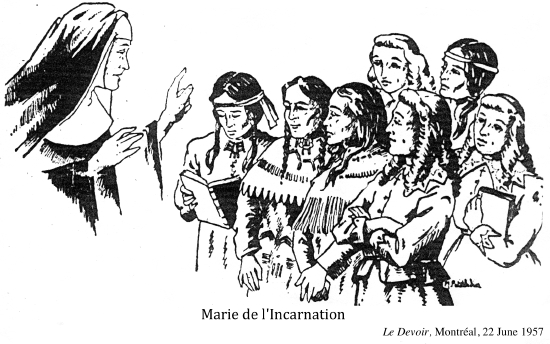
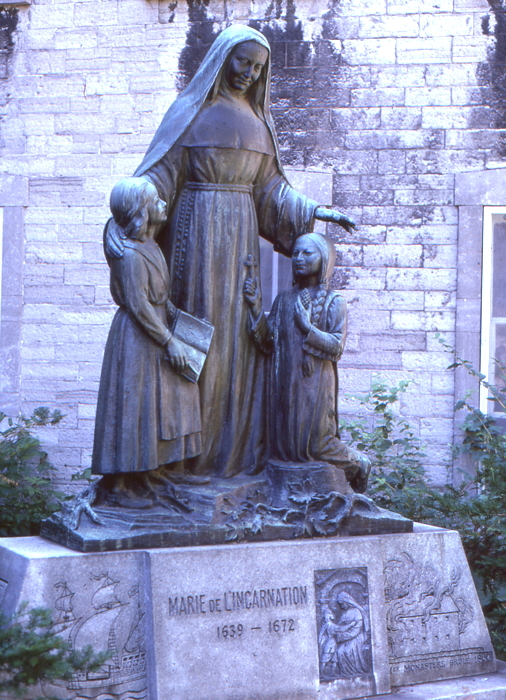
Mother Marie de l'Incarnation
"It is easier to make a savage out of a Frenchman than to do the opposite."
Mary of the Incarnation
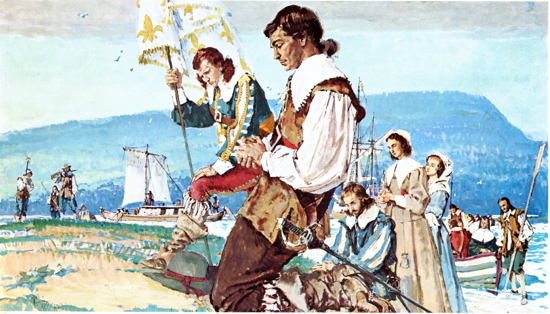
Founding of Montreal, 18 May 1642. LAC 1967-49-3, Donald Kenneth Anderson, 1965
"History was how God's plan for humanity unfolded."
Geoff Keelen
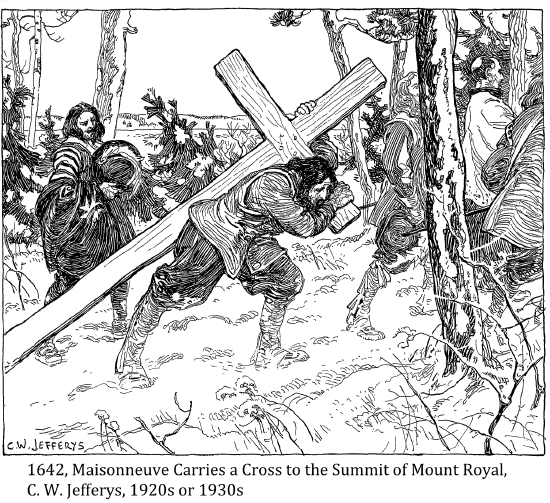
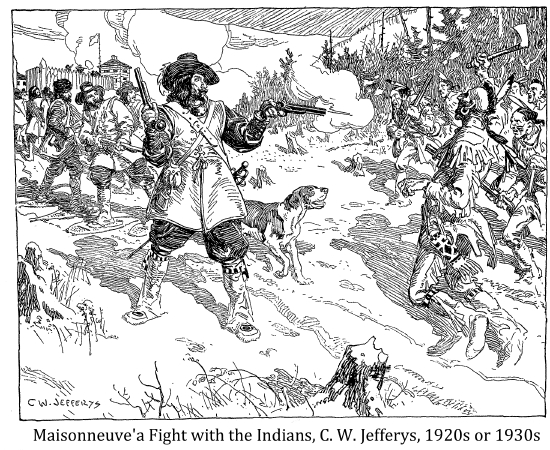
"The founding of Montreal ranks high in the history of heroism."
Agnes Repplier
"I have not come here to deliberate, but to act. It is my duty and my honour to found a colony at Montreal; and I would go, if every tree were an Iroquois!"
Sieur de Maisonneuve
"You are a grain of mustard seed that shall rise and grow until its branches overshadow the earth. You are few, but your work is the work of God. His smile is on you, and your children fill the land."
Sieur de Maisonneuve Sermon, founding the colony of Ville-Marie [Montreal], 18 May 1642
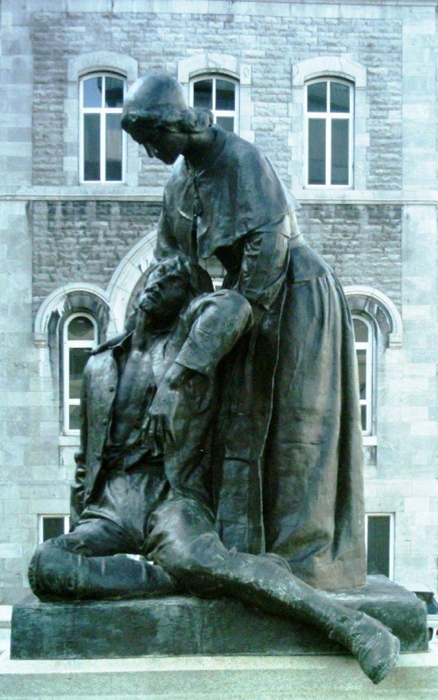
1642 Jeanne Mance cofounded the settlement of Montreal with Paul de Chomedy de Maissoneuve and founded the first hospital in Montreal, Louis-Philippe Hébert 1909
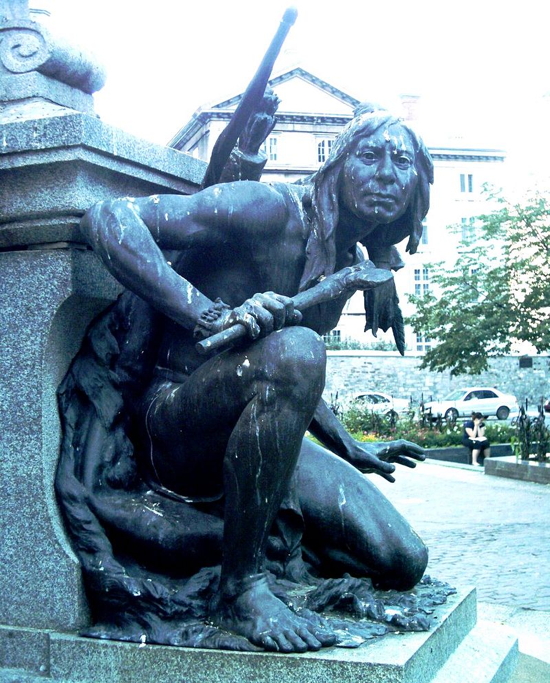
Iroquois found at the base of a statue to Paul de Chomedy, sieur de Maisonneuve. Louis-Philippe Hébert 1895
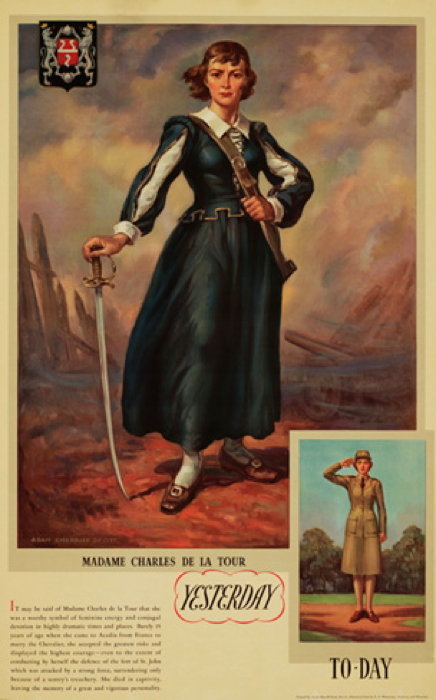
1645 Madam Charles de la Tour, McGill University Library, REF#WP2.R27.F2, 1939-45
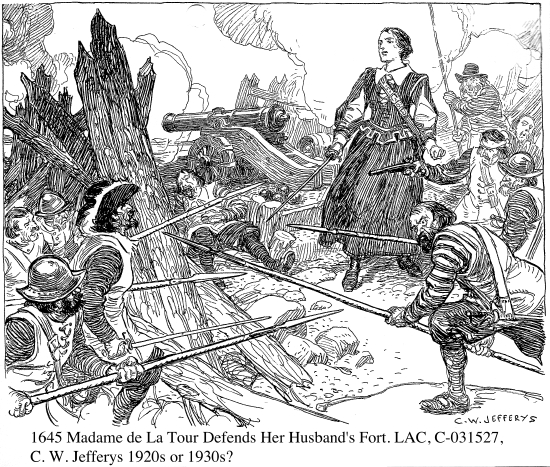
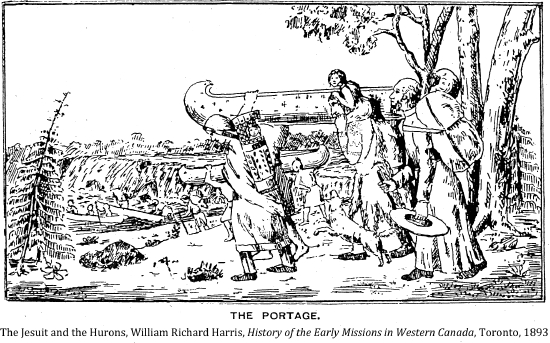
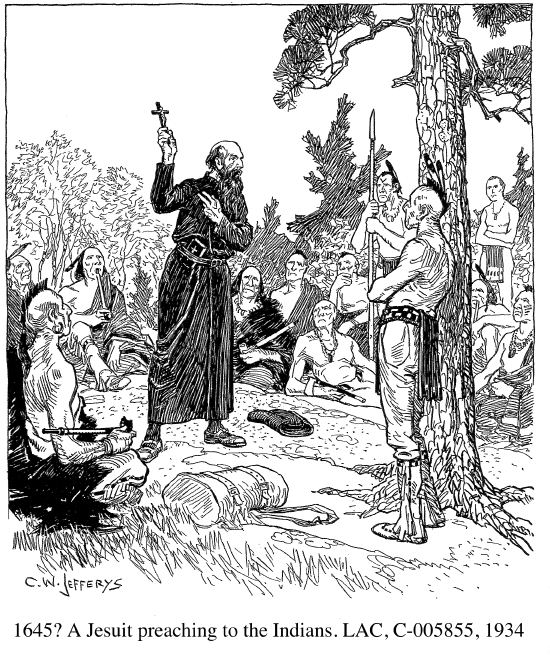
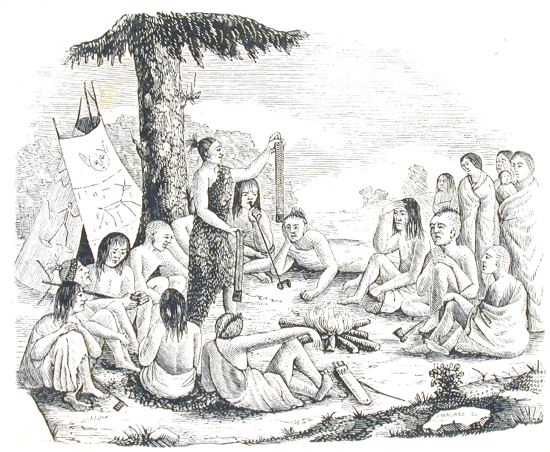
Native people scene, John Henry Walker, McCord Museum, M930.51.1.66, 1850-1885
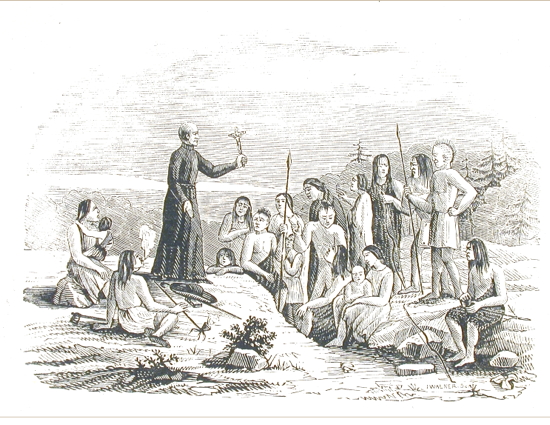
Native gathering, John Henry Walker, McCord Museum, M930.51.1.76, 1850-1885
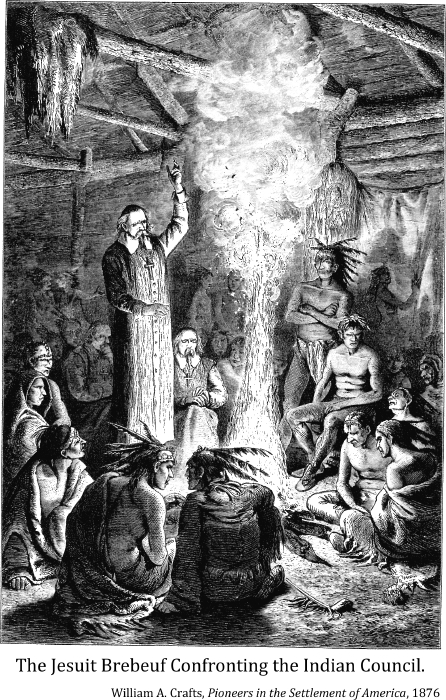

1649 The death of some Jesuit Fathers in New France, from "Historiae Canadensis" by Francois Ducreux, published in 1664. It is a composite picture of ten martyrdoms which took place in various places between 1646 and 1650.
This engraving portrays ten martyrdoms which took place in various places between 1646 and 1650. It was used to solicit funding to support the missions.
• Anne de Nouë de Champagne (1587-1646) was frozen to death while trying to
administer the sacrament to soldiers at Sorel.
• Isaac Joques (1607-1646) was killed by a hatchet blow to the head by Iroquois at
Ossernenon (Auriesville, New York).
• Two young Frenchmen who were killed.
• Antoine Daniel (1601-1648) was slain at the Saint-Joseph Mission II.
• Jean de Brébeuf (1593-1649) and Gabriel Lalemant (1610-1649).
• Charles Garnier (1605-1649) was slain by the Iroquois at Saint-Jean in the Huron
country.
• Noël Chabanel (1613-1649) died at the hands of a former convert.
• Joseph Onahare (d.1650) was a young Algonquin who was killed for refusing to
abandon Christianity.
"The Catholic version of Canadian history disparaged Native people as superstitious savages and praised French colonists and missionaries for planting the One True Truth in the New World. . . [Textbooks never] mention that Native people were fighting to protect their homeland against what amounted to an armed invasion by European soldiers and settlers."
Daniel Francis, National Dreams, 1997
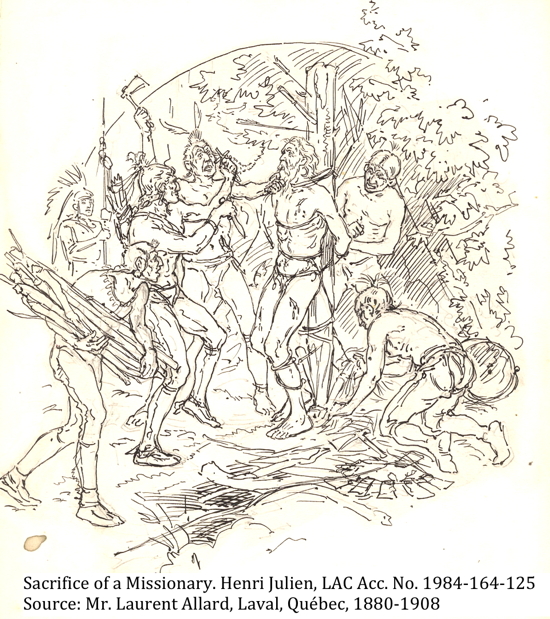

"When Lalemant and de Brébeuf, brave souls,
Were dying by the slow and dreadful coals,
Their brother Jesuits in France and Spain
Were burning heretics with equal pain.
For both the human torture made a feast:
Then is priest savage, or Red Indian priest?"
Canon F. G. Scott, 1957
"When Brébeuf and His Brethren [a poem by E. J. Pratt] first came out, a friend of mine said that the thing to do now was to write the same story from the Iroquois point of view."
Jame Reaney, 1972
"The Hurons observed with some sort of reason, that, since our arrival in these lands, those who had been the nearest to us, happened to be the most ruined by the disease and that whole villages of those who had first received us now appeared to be utterly exterminated. It has happened very often and has been remarked more than a hundred times, that where we were most welcome, where we baptized the most people, there it was in fact where they died the most."
Father Lalemant
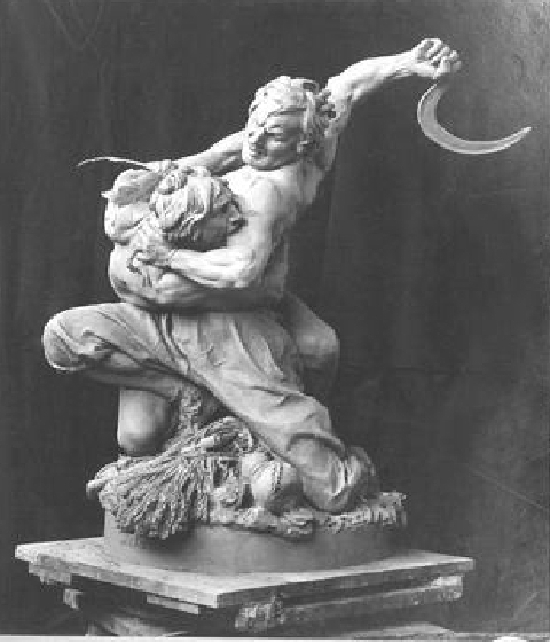
Sans Merci. Without Mercy. (A farmer is fighting a native in mortal combat in a grainfield. It depicts the struggle of civilization against savagery.), Louis-Philippe Hébert, 1893
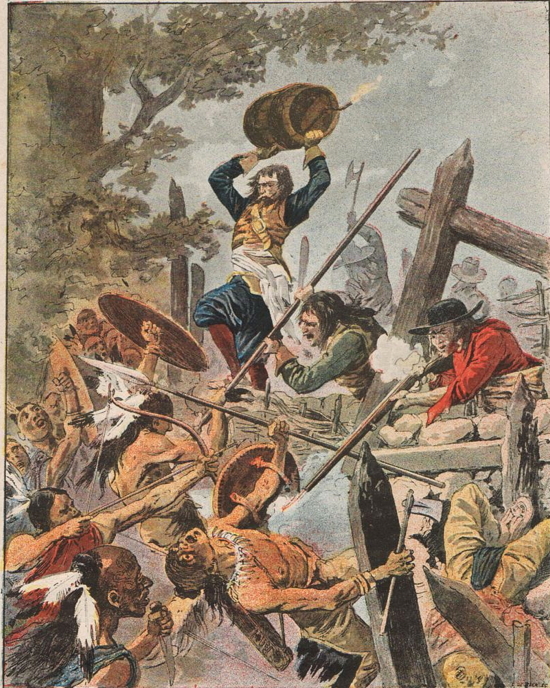
1660, Engraving depicting Adam Dollard with a keg of gunpowder above his head, 1898
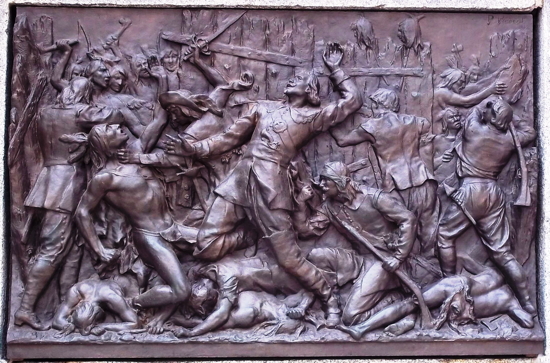
1660, A bas-relief of Adam Dollard des Ormeaux in the battle of Long Sault, Montreal, Louis-Philippe Hébert, 1895
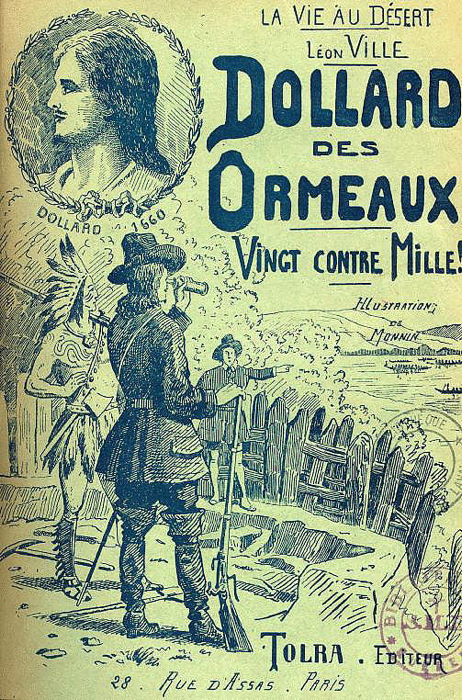
Dollard des Ormeaux, Lèon Ville, 1854
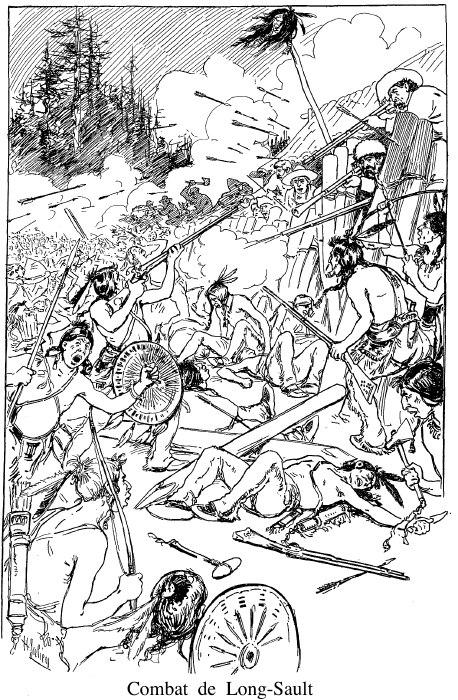
1660 Combat du Long Sault. LAC, Acc. No. 1984-164-92 Source: Mr. Laurent Allard, Laval, Québec., Henri Julien 1880-1908
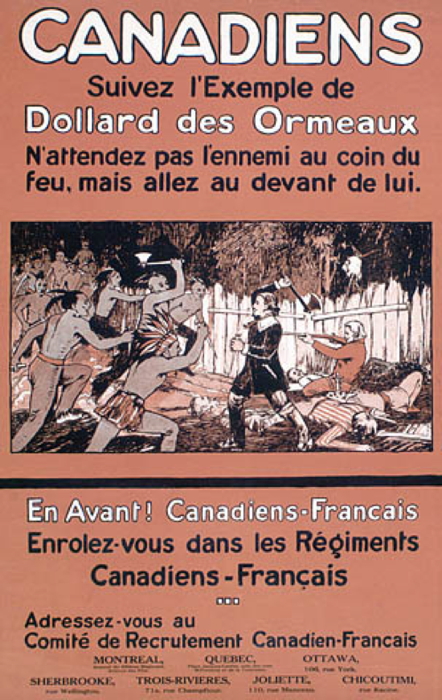
1660 « Canadiens suivez l'exemple de Dollard des Ormeaux » : Campagne de recrutement. LAC, Acc. No. 1983-28-781, unknown 1914-1918. Canadians: Follow Dollard des Ormeaux's example. Don't wait for the enemy by the fireside, go out and meet him. Forward! French Canadians, enlist in French-Canadian regiments. Visit an office of the French Canadian Recruitment Committee.
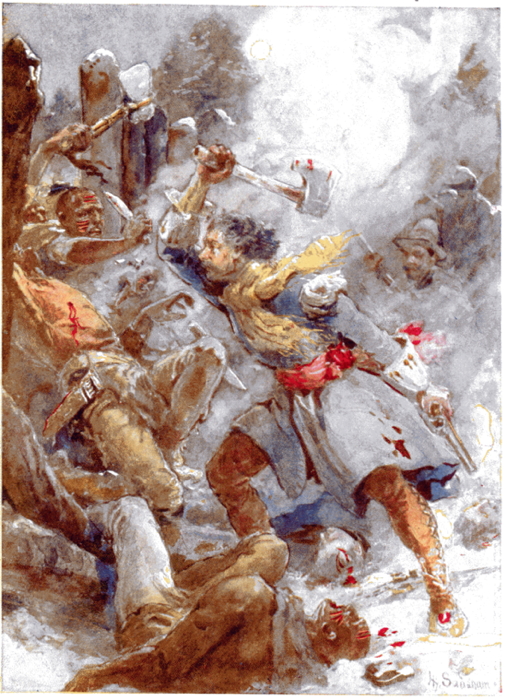
1660 Defence of the Long Sault, Henry Sandham in A Picture History of Canada, 1942
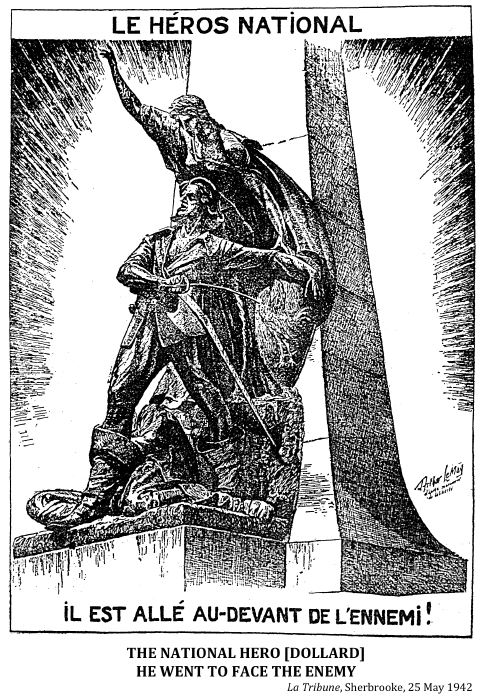
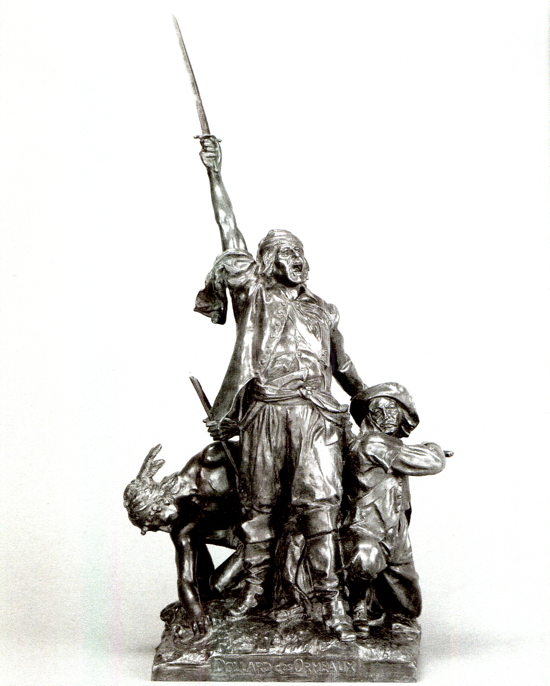
Dollard des Ormeaux, Louis Philippe Hébert, 1916
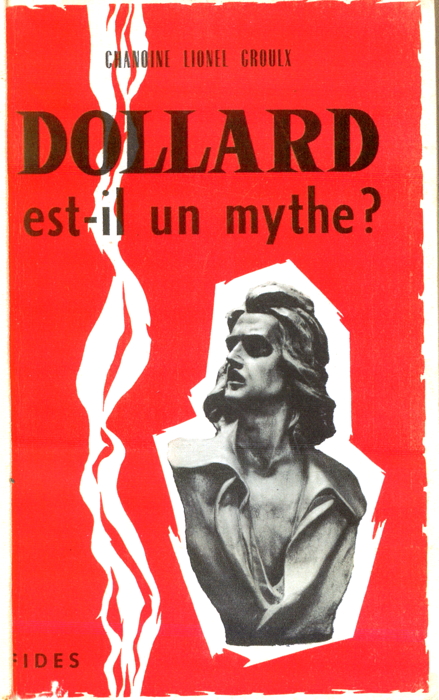
Victoria Day was celebrated by many in Quebec as Fête de Dollard starting in 1920. In 2003 the holiday was rebranded as Fête nationale des Patriotes (National Patriots' Day).

Radissonand Groseilliers at Sault St. Marie, John David Kelly
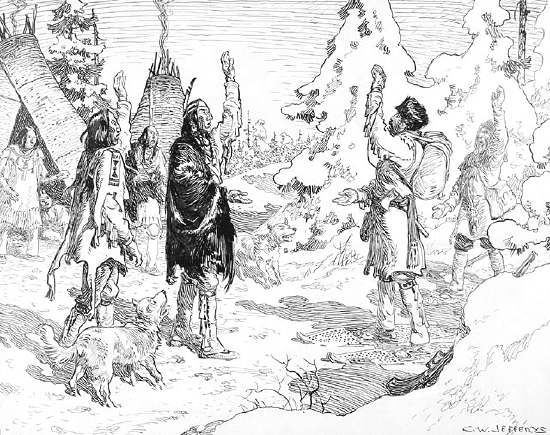
1661 Radisson rencontre les Indiens dans un campement d'hiver. Radisson Meets the Indians in Winter Camp. LAC, 1972-26-60, Charles William Jefferys 1920s or 1930s?
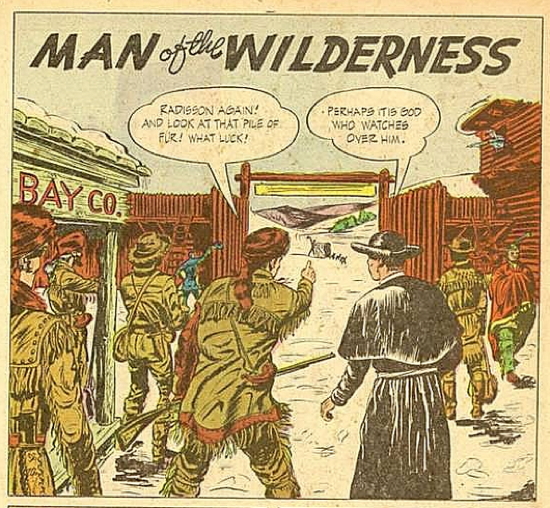
Radisson and Groseilliers, comic book, 1942-1952
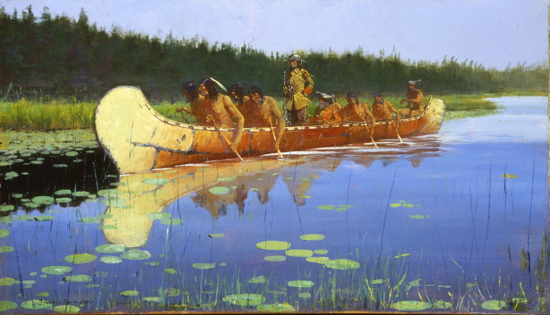
Radission and Groseilliers, in 1661. Frederick Remington 1905

"American conditions of life emancipated the French peasants who crossed the Atlantic. With liberty forever beckoning through the trees and up the waters which flowed past their door, how could they be ridden by feudal lords? If anyone found life in the colony too cramping now power on earth could hold him from running away into the woods to live a wilder life of freedom with the Indians."
A. L. Burt

1663 ? Les pelletiers à Montréal. The Fur Traders at Montreal. LAC, 1990-329-1, George Agnew Reid 1916
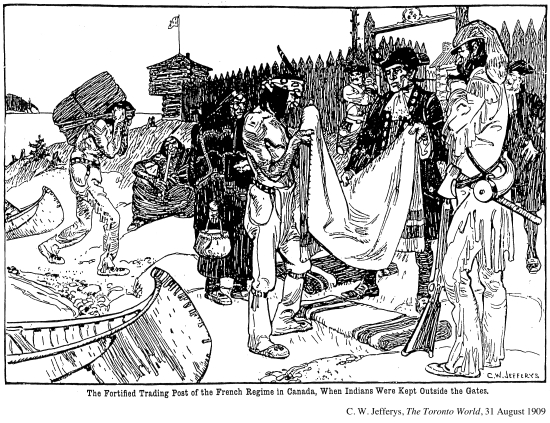
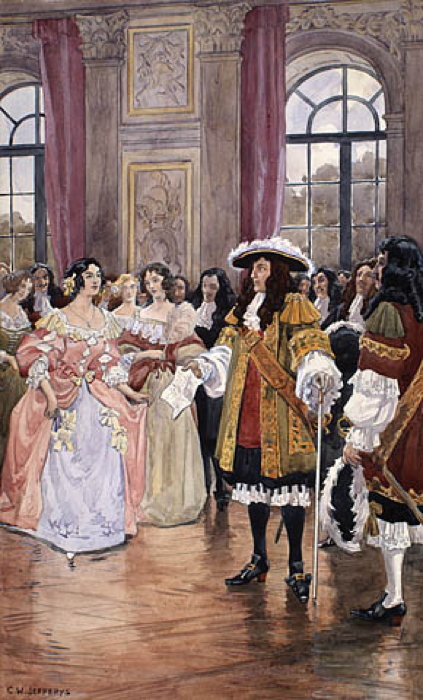
1663 Louis XIV accueille les filles qui seront envoyées au Canada. Louis XIV receiving the girls to be sent to Canada. LAC, Acc. No. 1990-568-2, Charles William Jefferys ca. 1925
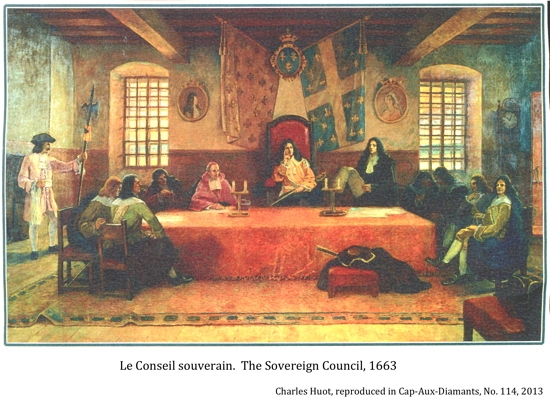
"The women who pioneered New France had little time to read, let alone to write . . . they married as soon as they landed, bore a child each year, worked alongside their men in the fields, and shouldered muskets when Indians attacked."
Sandra Gwyn, Herstory, 1975
"Women, in a variety of ways, played a primary role in shaping French-Canadian society even before the conquest."
Ramsay Cook
"The Counter-Reformation in France was like a tonic for Catholicism, inspiring man to undertake the mission to evangelize Aboriginal peoples."
Jacques Lacoursière and Robin Philipot
"Try to civilize the Algonquins, the Hurons and the other savages who have embraced Christianity to prepare them to come and live in a community with the French and to live with them according to their customs."
Jean-Baptiste Colbert
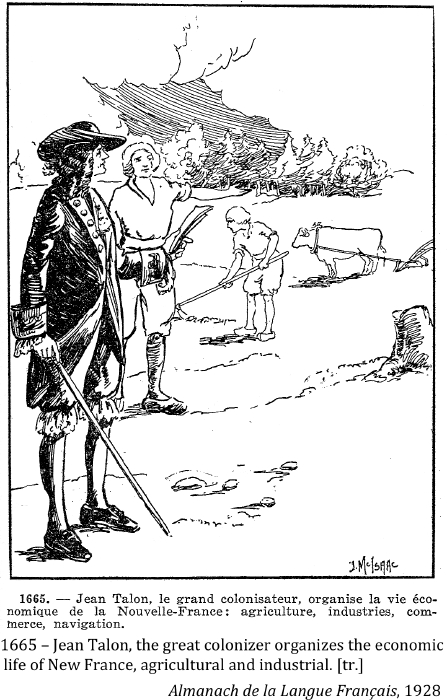

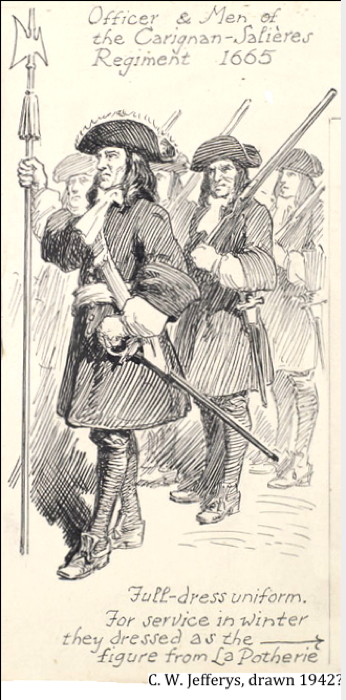
"Even Frenchmen – Colbert, Talon – Talon comes out to Canada filled with the idea of making this a typical little France, a new France, a real new France in the New World. And then he yields to the seduction, to the compulsion of the river. He begins dreaming grandiose dreams of what an enormous continental empire you could create in the centre of the continent."
Donald Creighton
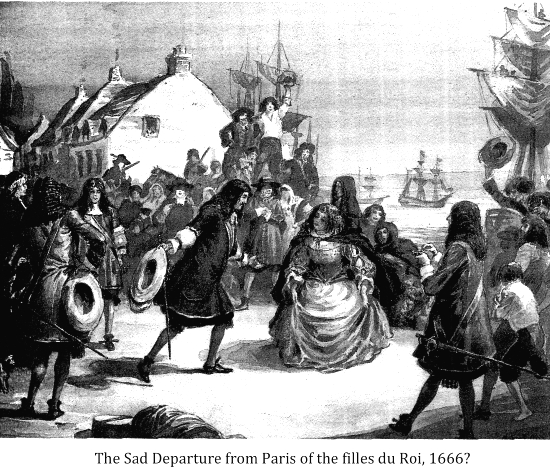
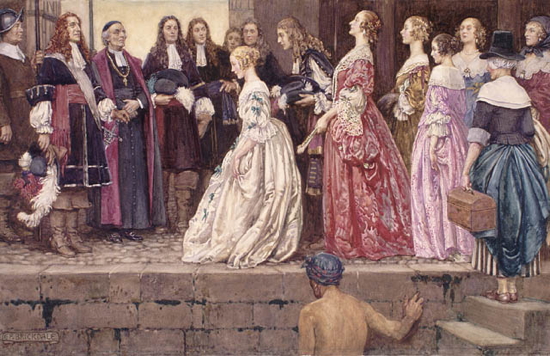
1667 L'arrivée des Filles du Roi. Arrival of the Brides. Acc. no 1996-371-1, Eleanor Fortescue Brickdale before 1927
[In 1663 there were six unmarried me for every woman in the colony. The King of France sent 850 girls to Quebec between 1663 and 1673.]
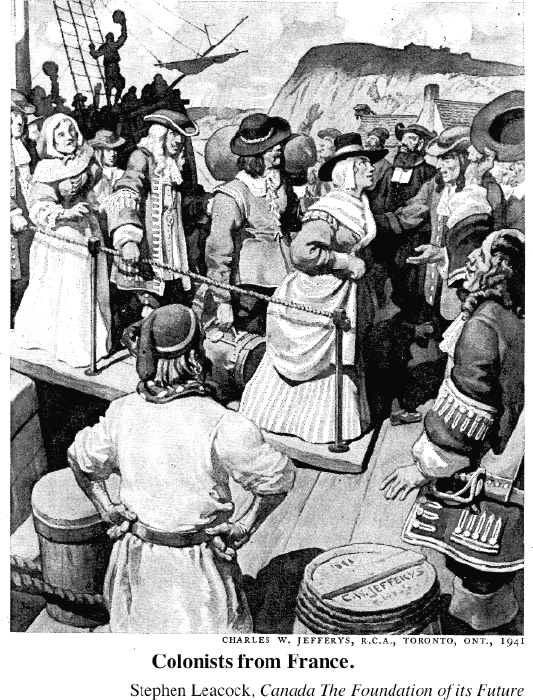
Facts from the Census of 1666
|
Number of families
Males
Females
Total population
Colonists under age 16
Seigneurs
Stone masons
Tailors
Storekeepers
Armourers
Hatters
Millers
Servants
Slaters
|
528
2034
1181
3215
1250
63
32
30
18
4
7
9
401
1 |
In Quebec District
In Montreal District
In Three Rivers
Colonists over age 81
Carpenters
Shoemakers
Teachers
Coopers
Gunsmiths
Joiners
Ropemakers
Ship Captains
Weavers |
2135
625
455
4
36
20
3
8
7
27
6
22
16 |
Note: Talon does not list members of the clergy, nobility or government.
Source: Ottawa Dominion Bureau of Statistics.
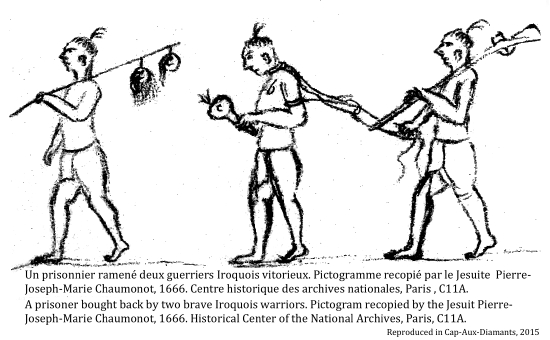
"Send me wives. With wives I will anchor the roving coureurs de bois to the soil of New France, and make of them the farmers that we need."
Pierre Le Moyne d'Iberville
"Those who refuse to marry should be made to bear the heaviest burden of taxation and it would be well if some especial mark of infamy could be added."
Jean-Baptiste Colbert

1665 Jean Talon visitant les colons. Jean Talon Visiting Settlers. LAC, Acc. No. 1983-45-3 / C-011925, Lawrence R. Batchelor 1931

1665 Réception donnée par mgr de Laval pour le marquis de Tracy et l'intendant Talon, 1665. Reception of the Marquis de Tracy and The Intendant Talon by Mgr. Laval, 1665. LAC, Acc. No. 1996-23-5, Frank Craig 1908-1911
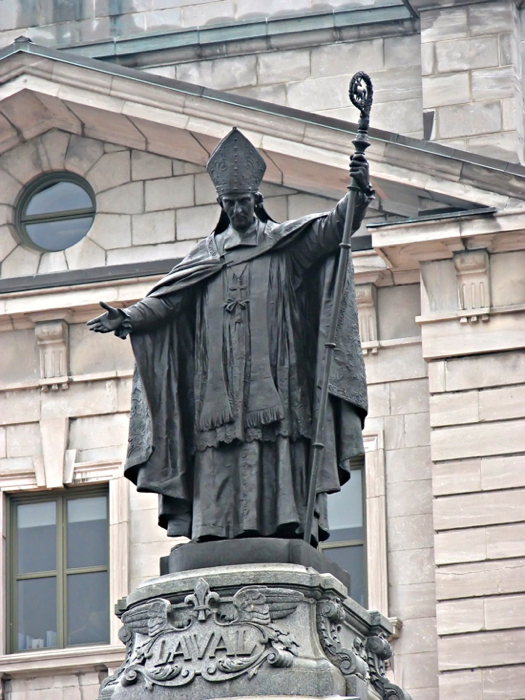
1665 Statue de François de Montmorency-Laval, à Québec, completed by Louis-Philippe Hébert in 1908.
"We make a very expressed prohibition, and forbid, under penalty of excommunication . . . the giving in payment to the savages, selling, trading or giving gratuitously or for reward, either wine or brandy in any fashion and manner or under any pretext."
Bishop Laval
"God, who is the God of battle, knows all. If He has aided us, we are victorious. His holy will be done; for in the order of this will He is glorified by our losses no less than by our gains . . . We feel that on the success or failure of this expedition [M. de Tracy, 1666] depends the life or death of the French colonies."
Marie de l'Incarnation
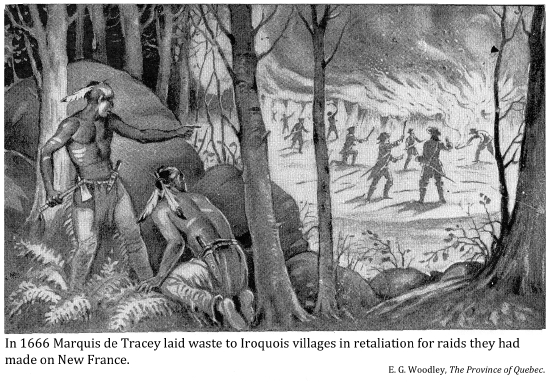
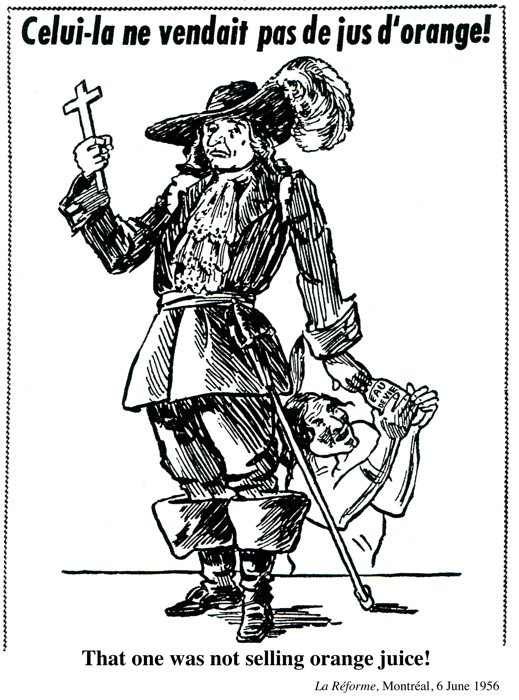
"Drink is a demon that robs them of their reason, and so inflames their passion that, after returning from the chase richly laden with beaver skins, instead of furnishing their families with provisions, clothing, and other necessary supplies, they drink away the entire proceeds in one day and are forced to pass the winter in nakedness, famine, and all sorts of deprivation."
The Jesuit Relations
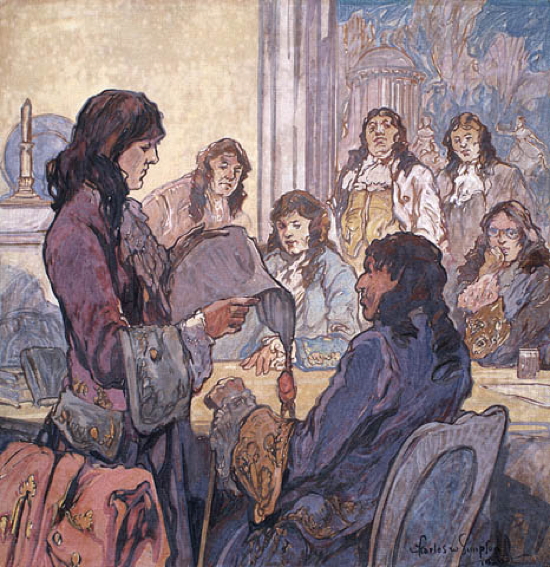
1670 Le prince Rupert lisant la charte octroyée le 2 mai 1670 aux dirigeants de la Compagnie des aventuriers faisant du commerce dans la baie d'Hudson. Prince Rupert reading charter granted May 2nd, 1670, to the directors of the Company of adventurers trading into Hudson's Bay. LAC, Acc. No. 1991-35-24, Charles Walter Simpson 1928
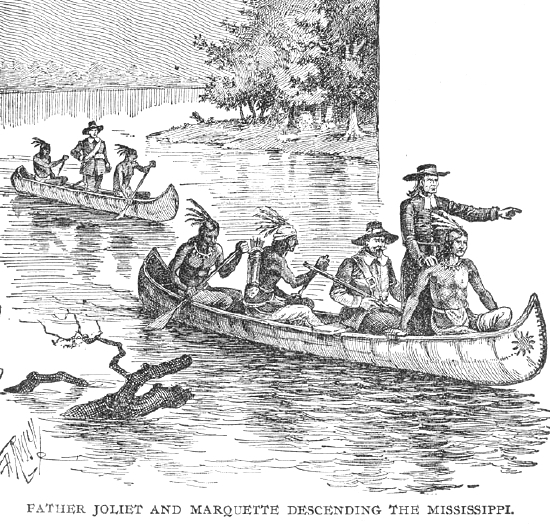
1673 Father Joliet and Marquette descending the Mississippi. LAC, Acc. No. 1990-553, 1900
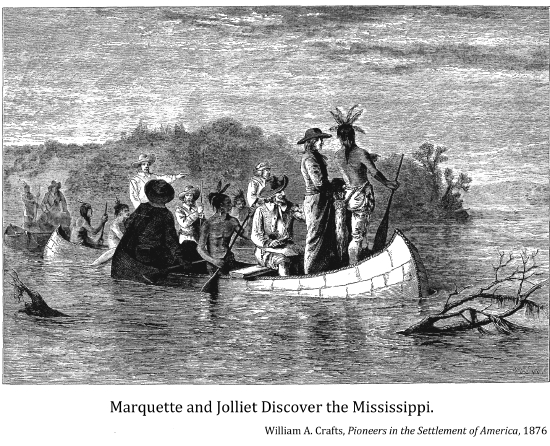
%20John%20David%20Kelly%20artist%20LAC%201967-49-4%20painted%201943%20e011201598.jpg)
Count Frontenac at Cataraqui (Kingston), 1673, John David Kelly artist, LAC 1967-49-4 painted 1943
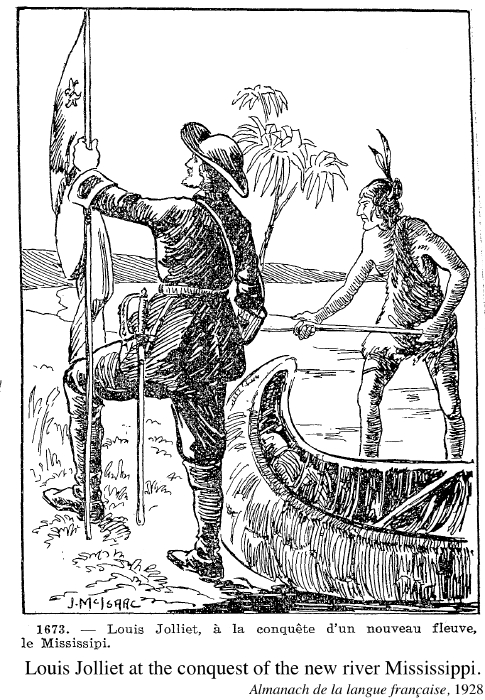
"When we arrived in this country the Indians were so numerous that it seemed as if they were going to grow into a vast population; but after they were baptized God called them to Himself either by disease or by the hands of the Iroquois. It was perhaps his wise design to permit their death lest their hearts should turn to wickedness.'
Marie de l'Incarnation, Letters Spiritualles, 1681
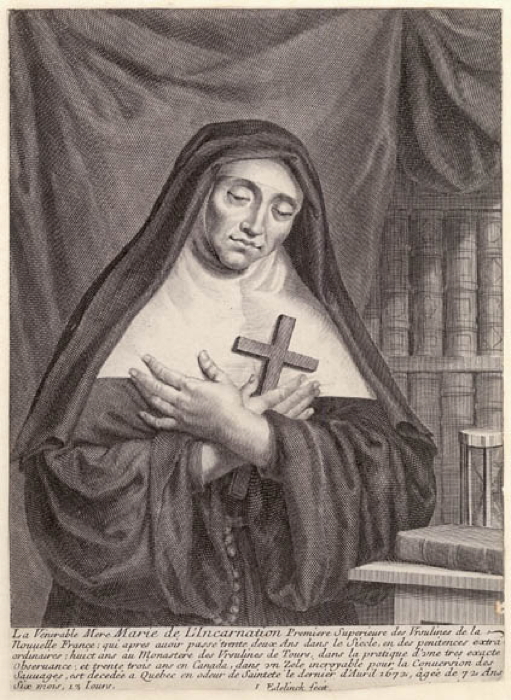
La Vénérable Mère Marie de l'Incarnation Première Supérieure des Ursulines de la Nouvelle France. Portrait de la Vénérable Mère Marie de l'Incarnation [document iconographique]. LAC C-008070, 1677
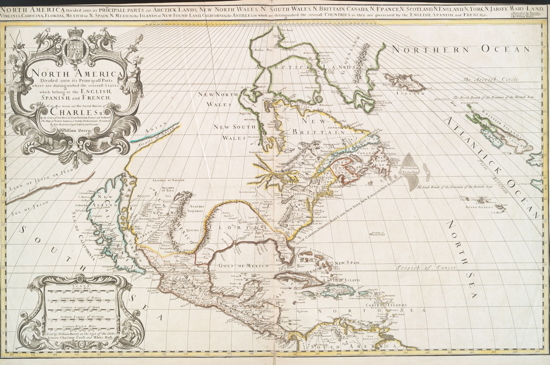
Map of North America, 1680-1689, New York Public Library, b15469755
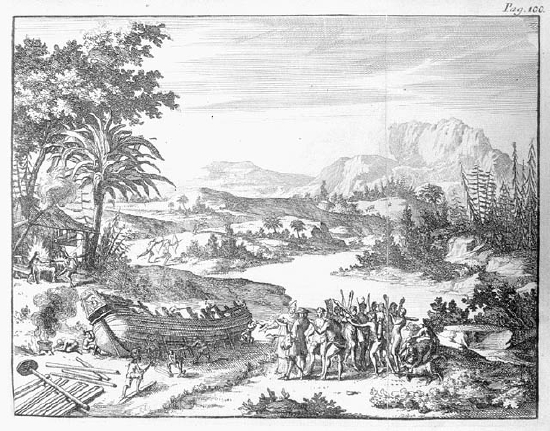
1679 The building of La Salle's "Griffon". LAC, C-001225, 1697
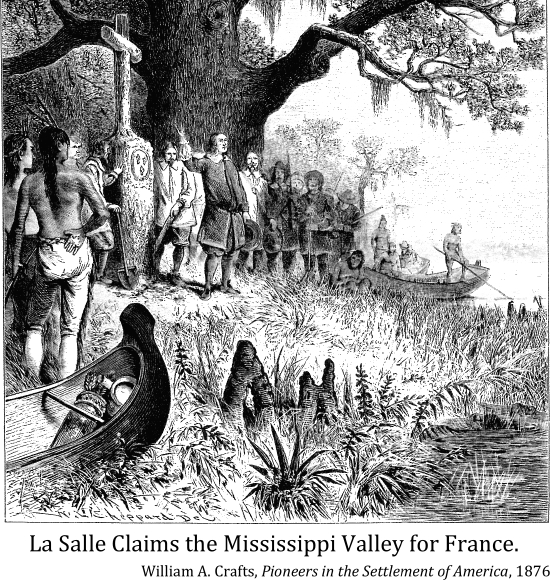
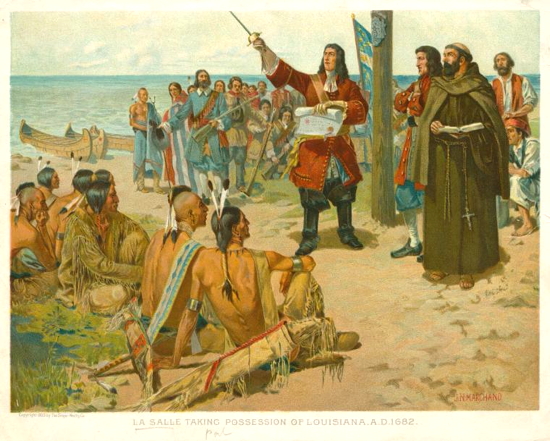
1682 La Salle taking possession of the Mississippi valley (under the name Louisiana) for France, 1904
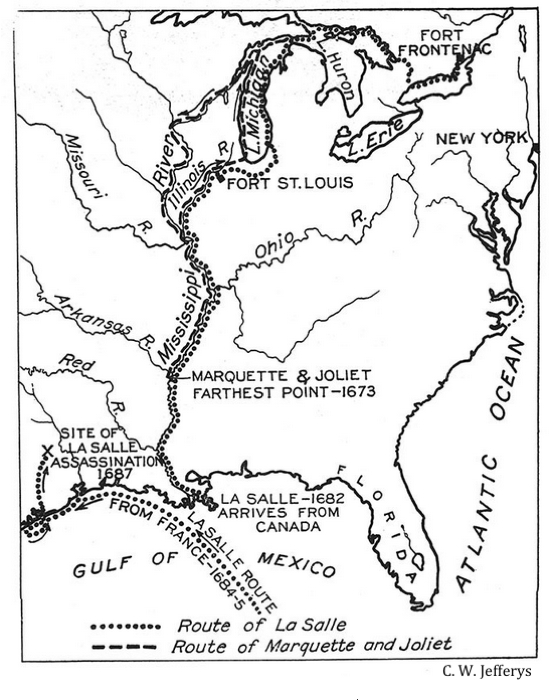
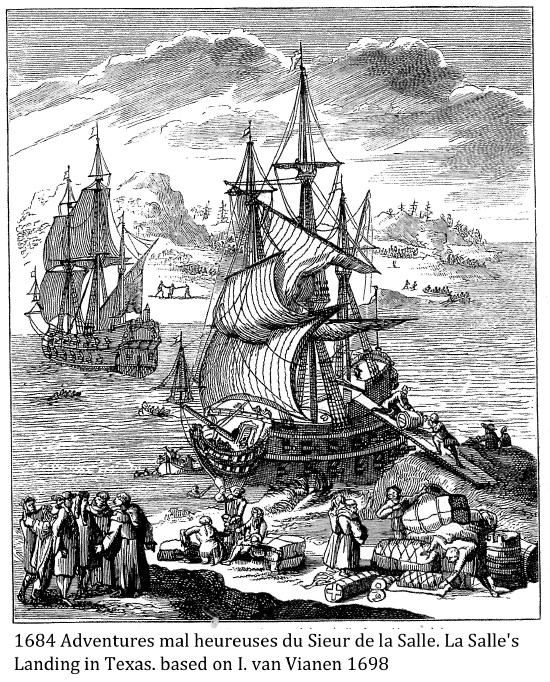

1687 Le Sieur de La Salle mal-heureusement assasiné. Sieur de la Salle unfortunately assassinated. LAC, C-099233, 1698
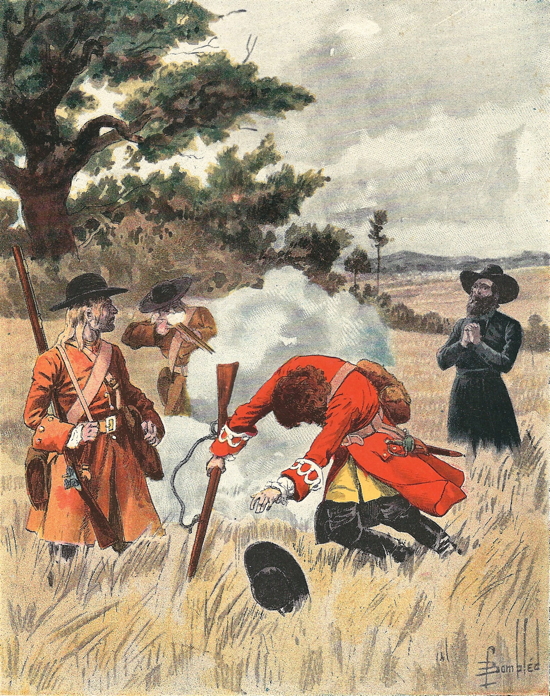
Assasination of La Salle, Assassinat de Cavelier de La Salle, 1687, Euge`ne Gue´nin, La Nouvelle-France, Paris, 1900, Public domain, via Wikimedia Commons
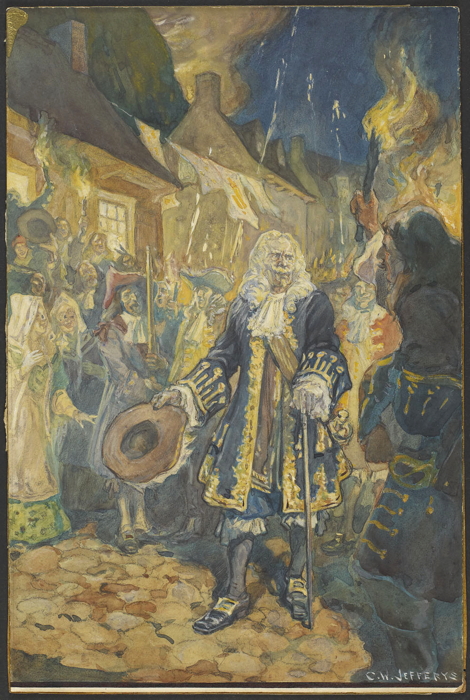
Frontenac reviens au Canada, 1689. Frontenac returns to Canada after the massacre at Lachine, 1689. LAC, Acc. No. 1972-26-762, Charles William Jefferys 1920s or 1930s?
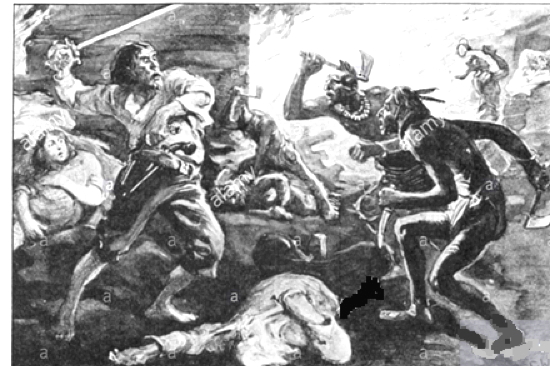
1689 1500 Iroquois attacked a French settlement at the farming village of Lachine
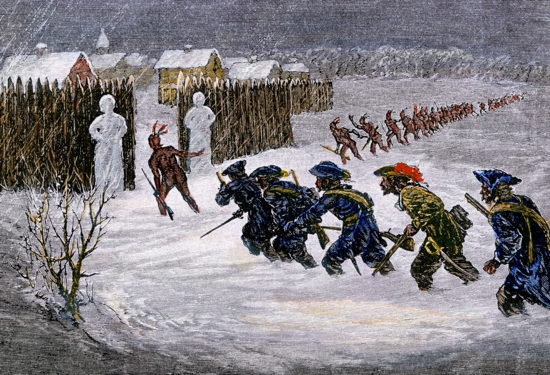
1690 The Attack on Schenectady, New York was in retaliation for the Lachine Massacre. The community (according to tradition) was only guarded by two snowmen.
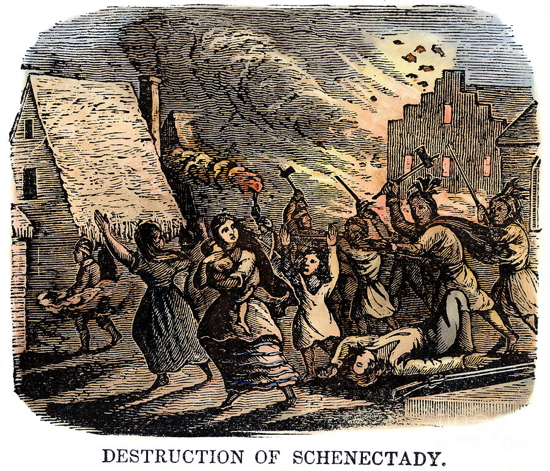
"The attorney general of the Conseil souverain of Quebec, who has come to France to inform His Majesty that the principal inhabitants of Canada are resolved, if His Majesty so consents, to bring Negroes to that country for the purposes of cultivating and clearing land, as a way of avoiding the heavy costs of resorting to workers and labourers of that country [France]. Whereupon His Majesty is pleased to state that He consents to such importation of Negroes as they propose."
Louis XIV, Letter to Governor Denonville, 1 May 1689
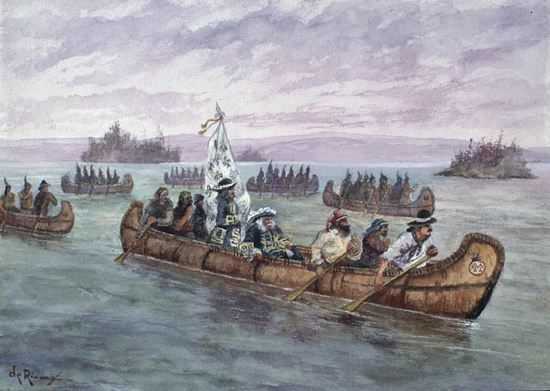
1690 Frontenac en route pour Cataraqui, 1690. Frontenac on his way to Cataraqui. LAC, C-013325, John Henry de Rinzy 1897-1930
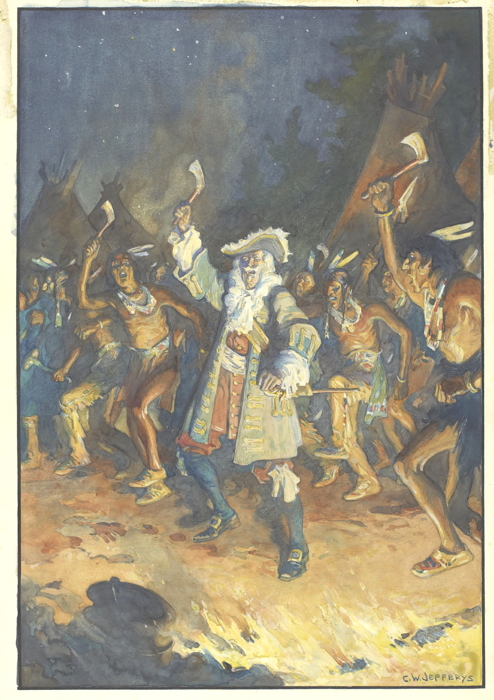
1690 Frontenac faisant la danse de la guerre, 1690. Frontenac dancing the war dance, 1690. LAC, Acc. No. 1990-512-3, Charles William Jefferys 1920s or 1930s?
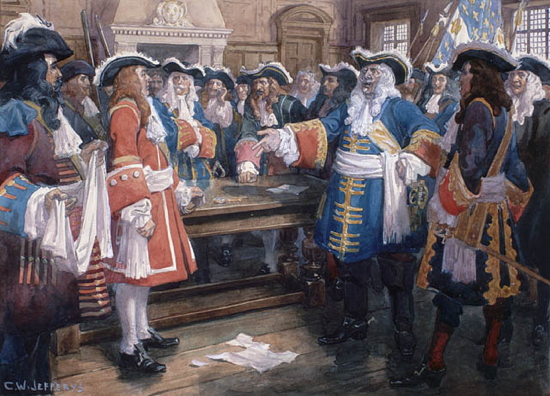
1690 Frontenac, recevant l'envoyé de sir William Phipps, qui demande à Québec de rendre les armes, 1690. Frontenac receiving the envoy of Sir William Phipps demanding the surrender of Quebec, 1690. LAC, Acc. No. 1972-26-780, Charles William Jefferys 1920s or 1930s?
"I will reply to your Admiral [Phips] through the mouths of my cannon."
Louis de Buade de Frontenac, 1690, reply to demand to surrender.
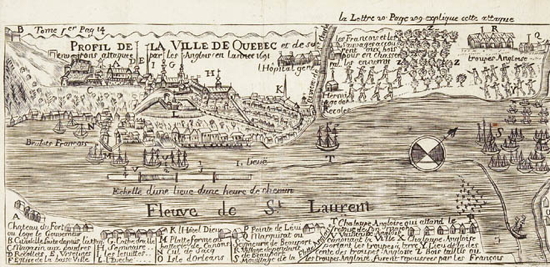
1690 Profil de La Ville de Quebec et de ses environs attaquée par les Anglais en l'annee 1691 [actual date of event October 1690]. The confrontation took place in October 1690 with Frontenac defending the city of Quebec and Sir William Phips leading the attack for the English. No battle was fought. The English retreated in the face of massed French forces and cold weather. LAC, Acc. No. R9266-3240 Peter Winkworth Collection of Canadiana, unknown 1690-1710
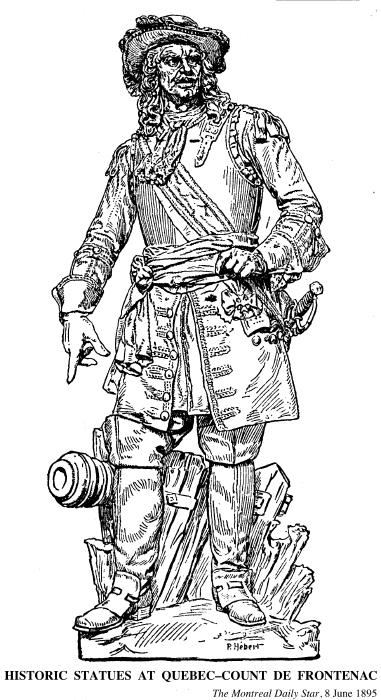
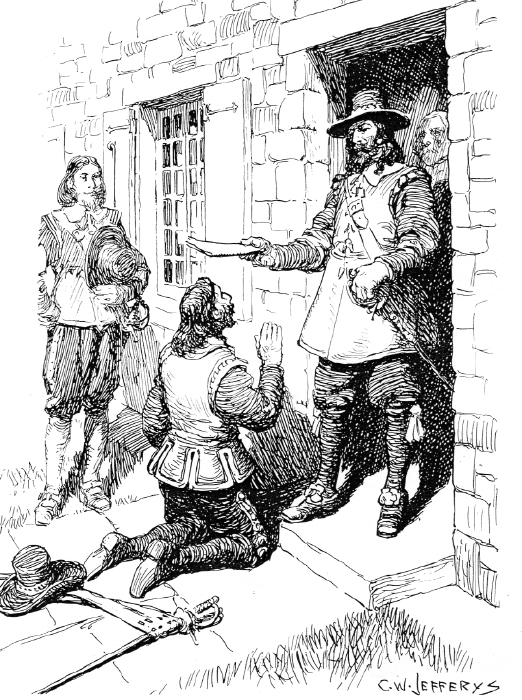
On receiving his grant of land the Seigneur, bareheaded, without sword or spurs, kneeling at the Governor's door, swore to be faithful to the King. LAC, 1972-26-668, Charles W. Jefferys, 1920s or 1930s?
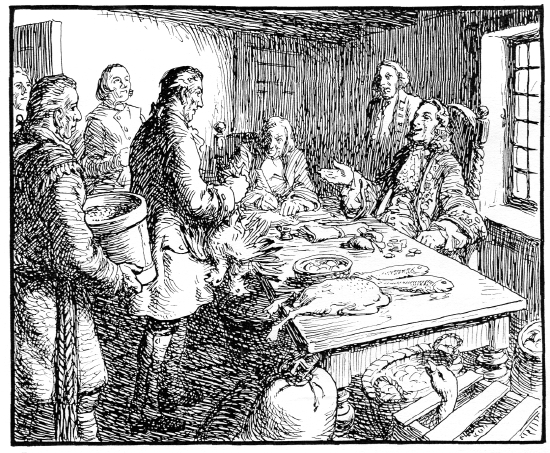
Tenants paying their yearly dues, in money or in produce to their Seigneur. LAC, 1972-26-668, Charles W. Jefferys, 1920s or 1930s?
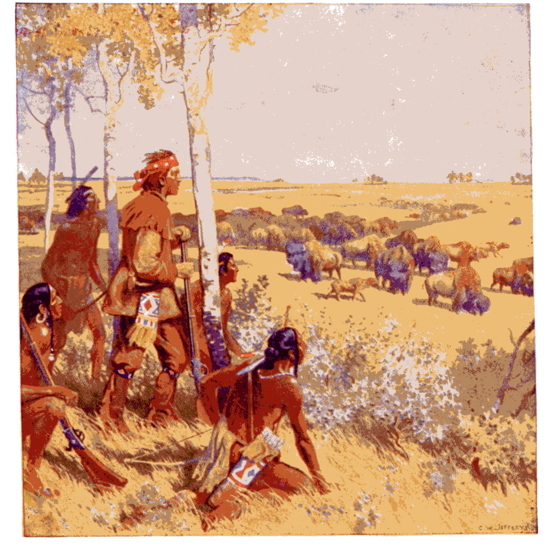
1691 Henry Kelsey sees the buffalo on the western plains, LAC, C-024390, Charles William Jefferys 1920s or 1930s?
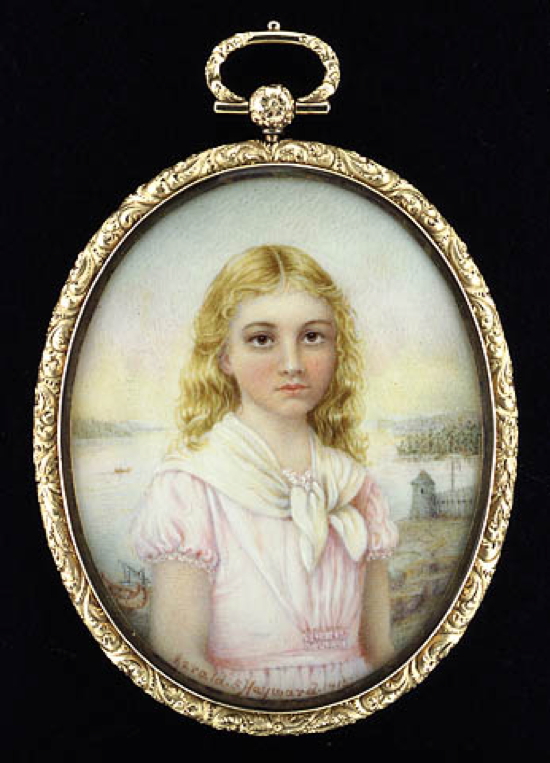
Marie Madeleine de Verchères, 1692. LAC, 1989-497-1, C-083513, Gerald Sinclair Hayward 1915
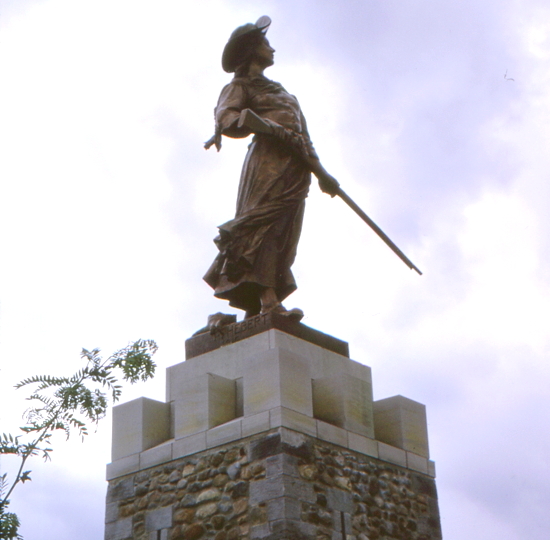
1692 Statue of Madeleine de Verchères, Louis-Philippe Hebert 1913
"Let us fight to the death. We are fighting for our country and our religion. Remember that our father has taught you that gentlemen are born to shed their blood for the service of God and the King."
Madeleine de Verchères
"The women who pioneered New France had little time to read, let alone to write. . . they married as soon as they landed, bore a child each year, worked alongside their men in the fields, and shouldered muskets when Indians attacked."
Sandra Gwyn, Herstory, 1975
"Women, in a variety of ways, played a primary role in shaping French-Canadian society even before the conquest."
Ramsay Cook
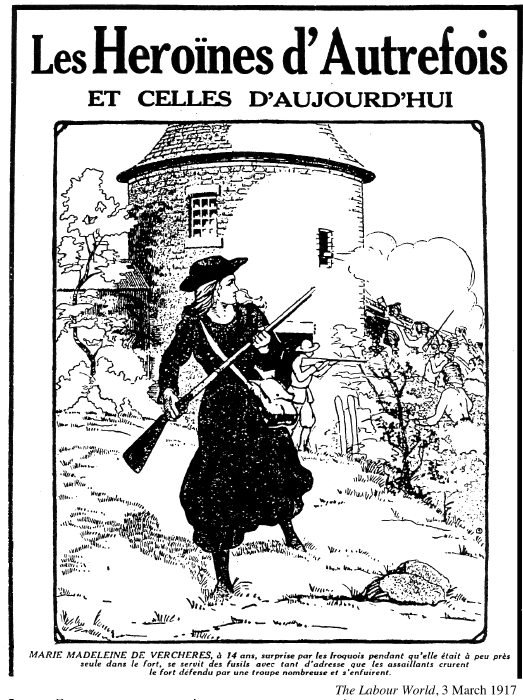
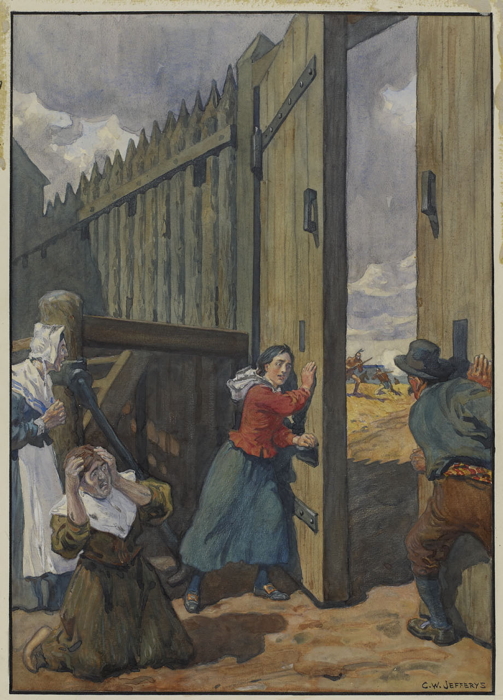
1692 Madeleine fermant le portail pendant que les Iroquois attaquent le fort de Verchères, en 1692. The Iroquois attack of Fort Vercheres, 1692. Madeleine closes the gate. LAC, Acc. No. 1990-512-1, Charles William Jeffreys 1920s or 1930s?

Madeleine de Verchères, Jean-Baptiste Lagacé, 1692, BAnQ

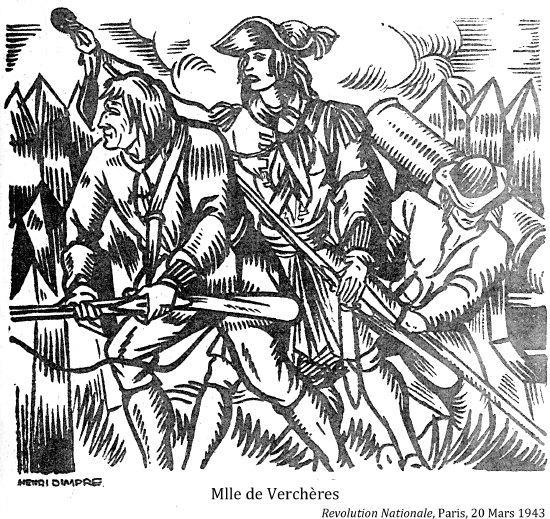
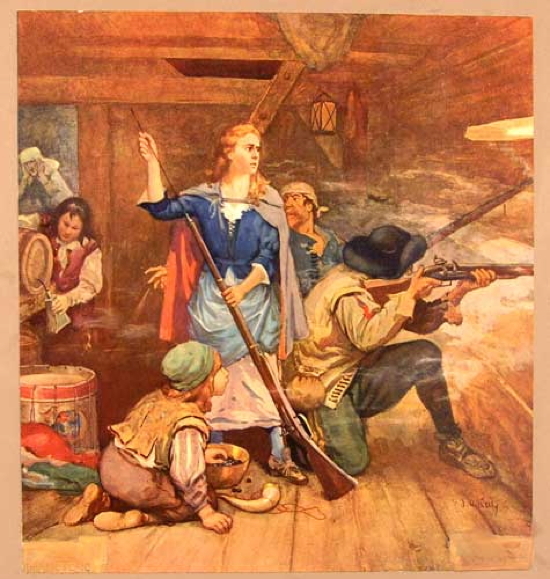
Madeleine de Verchères Defends the Fort, 1692, J. D. Kelly
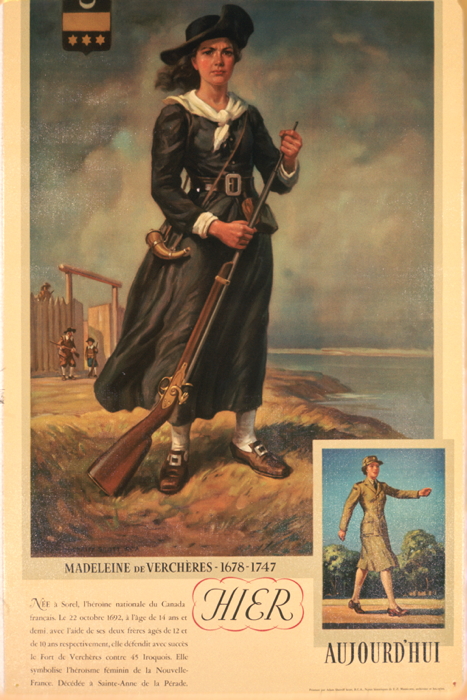
1692 Madeleine de Vercheres 1678-1747, CWM, Acc. No. 19700036-002, 1942-1945, Yesterday. Today. Born in Sorel, the national hero of French Canada. On 22 October 1692, at the age of 14 ½ years, with the help of her two brothers aged 12 and 10 respectively, she successfully defended Fort de Verchères against the Iroquois. She symbolizes the feminine heroism of New France. Deceased at Sainte-Anne de la Pérade.
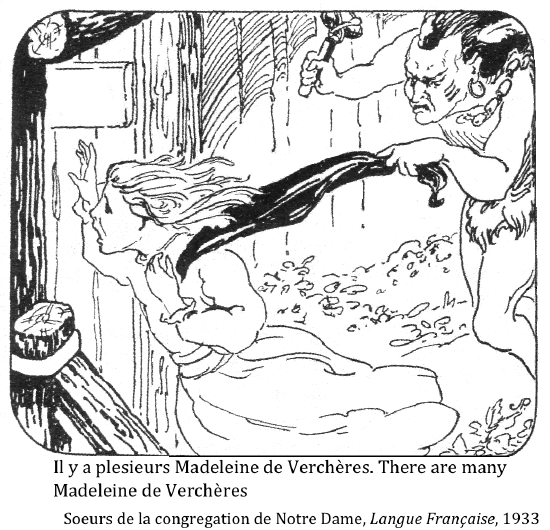
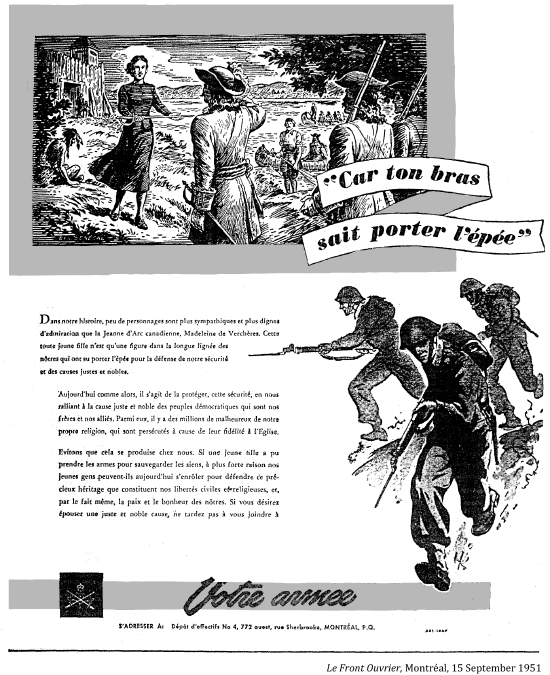
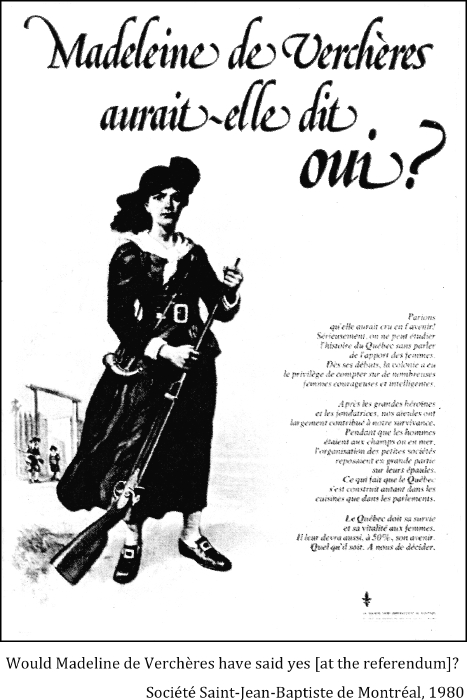
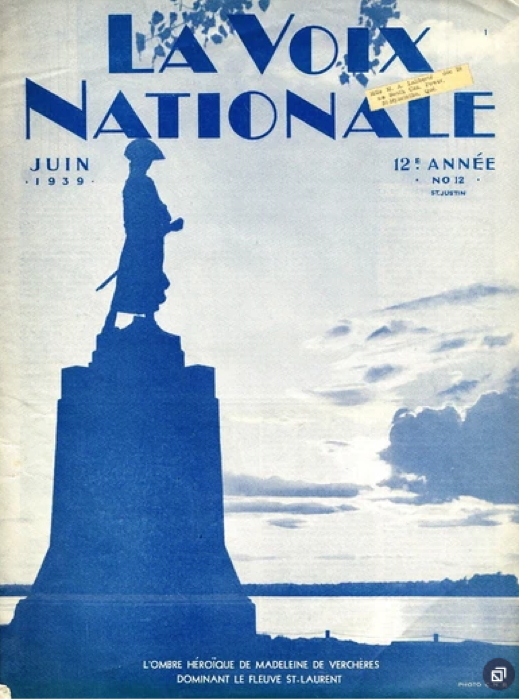

[Pierre le Moyne d'Iberville captures Fort Nelson on 13 September 1697.]
Arthur Heming, Public domain, via Wikimedia Commons
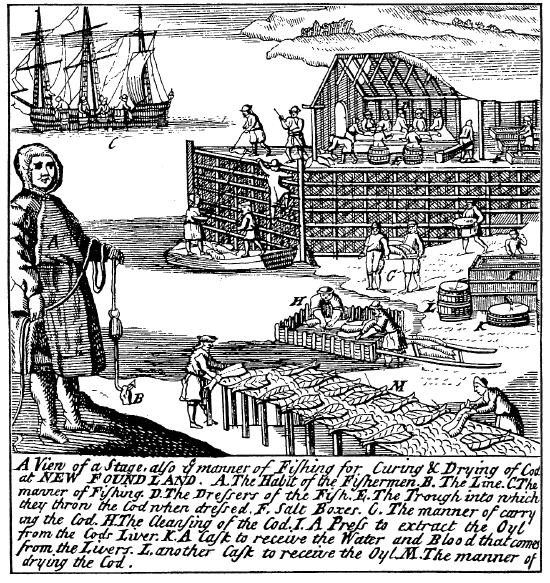
1698 A view of a stage and also of the manner of fishing for, curing and drying cod at New Found Land [...]. LAC, C-003686
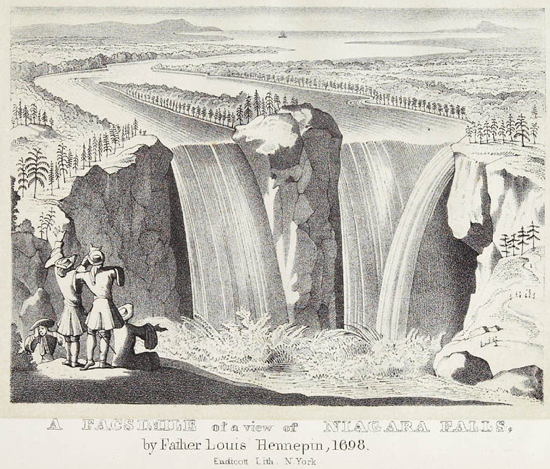
1698 A Facsimile View of Niagara Falls by Father Louis Hennepin, 1698. LAC, Acc. No. R9266-2197 Peter Winkworth Collection of Canadiana, Lewis Hennepin
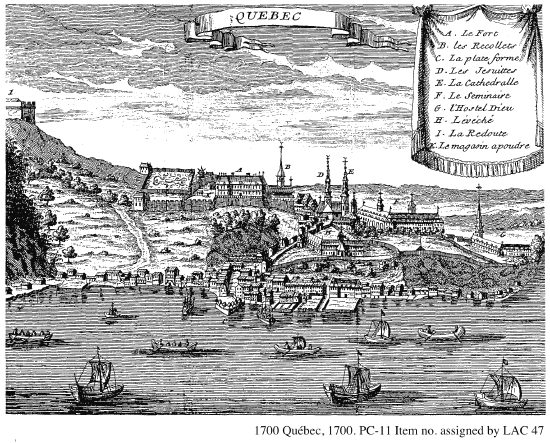
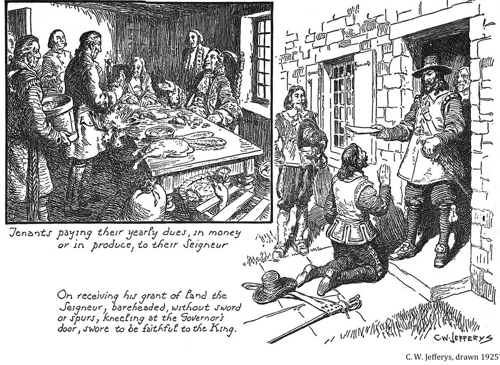

Kleedinge van Canada. Acc. No. R9266-2428 Peter Winkworth Collection of Canadiana, n.d.
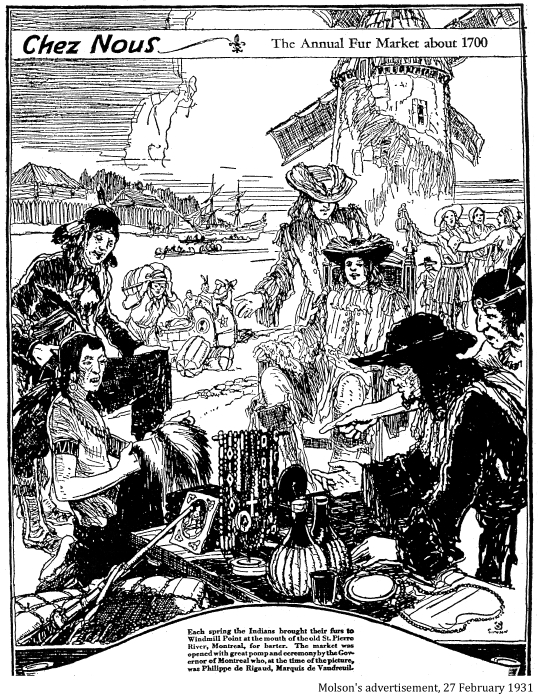
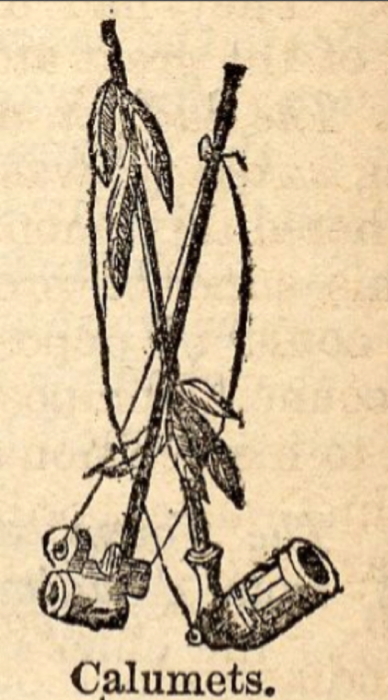
Signature de la Grade Paix de Montre´al, 4 August 1701, BAnQ
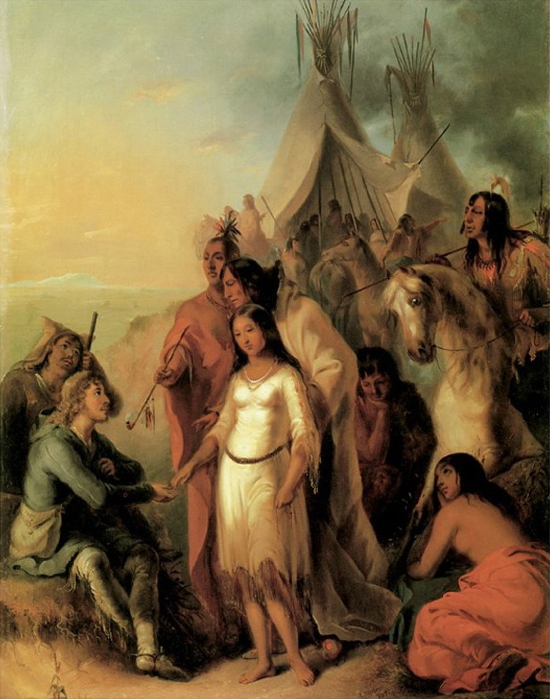
The Trapper's Bride, by Alfred Jacob Miller
"The fur trade made a critical mass of the Canadiens into adventurers. They were close to the natives and there was a good amount of intermarriage."
John Ralson Saul, A Fair Country
"By marrying into the indigenous world, most of the newcomers were marrying up. They were improving their situations, politically and economically."
John Ralston Saul, A Fair Country
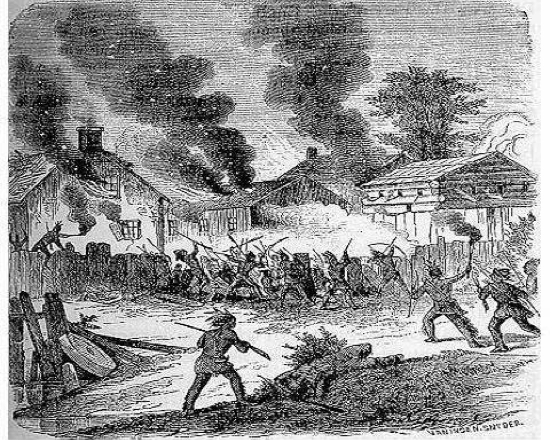
1704 An early American view of the Deerfield Raid
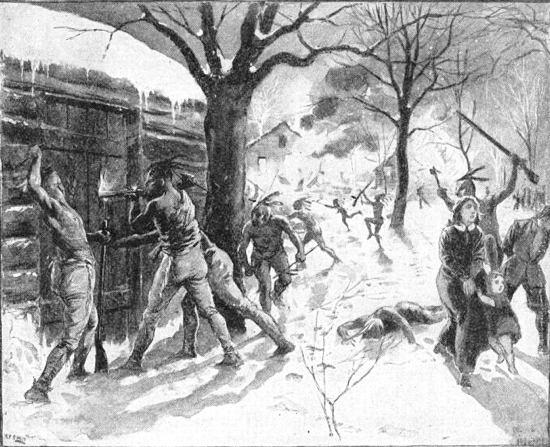
1704 Illustration depicting the Deerfield Raid produced in the United States in 1900
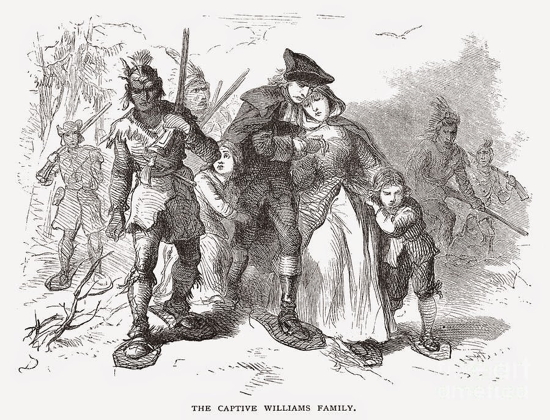
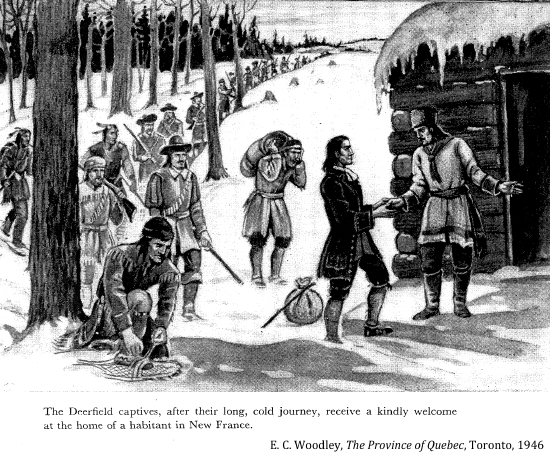
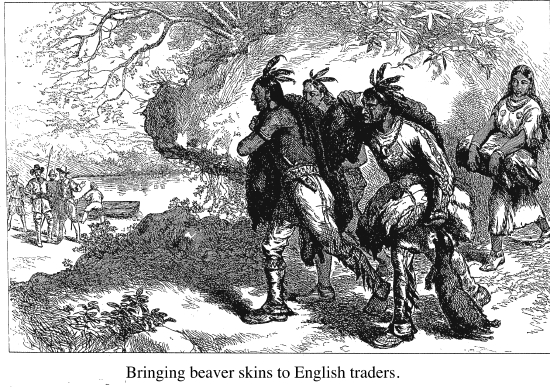
"Are the streets being paved with gold over there? I fully expect to awake one morning in Versailles to see the walls of the fortress [of Louisbourg] rising above the horizon."
Louis XV
"We, at His Majesty's pleasure, order that all Panis [Indians] and Negroes who have been bought and who shall be bought hereafter shall belong in full ownership to those who bought them as their slaves; and we hereby forbid said Panis and Negroes to leave their masters."
Intendant Raudot legalizes slavery, 1709
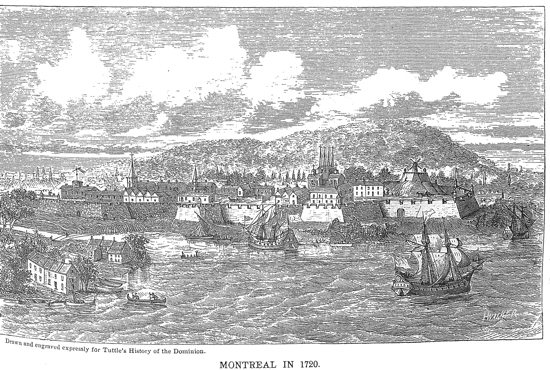
1720 Montreal, Short History of the Dominion of Canada, Charles R. Tuttle, 1878

Tejonihokarawa (baptisé Hendrick). Nommé Tee Yee Neen Ho Ga, Emperor of the Six Nations. Tejonihokarawa (baptized Hendrick). Named Tee Yee Neen Ho Ga Row, Emperor of the Six Nations. LAC, Acc. No. 1977-35-4, John Vereist 1710
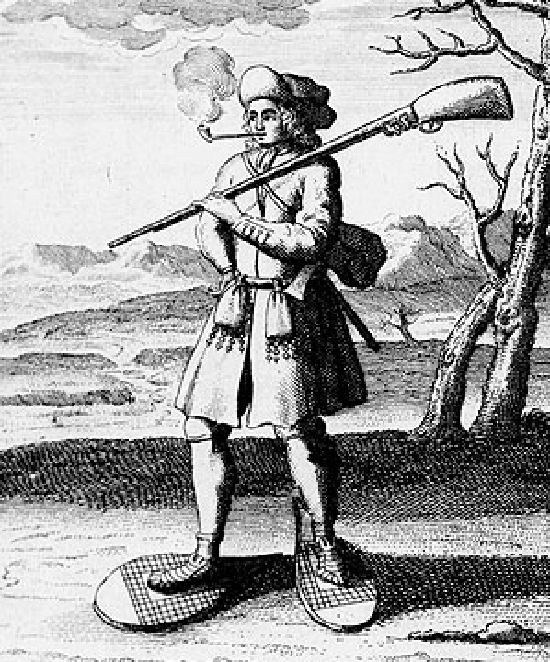
Canadians Going To War on Snowshoes, 1722. LAC C-113193

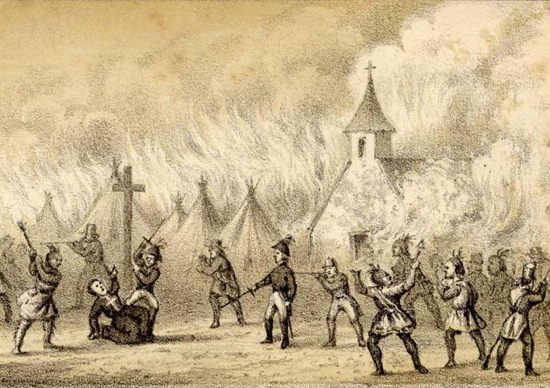
1724 Death of Father Sebastian Rale of the Society of Jesus
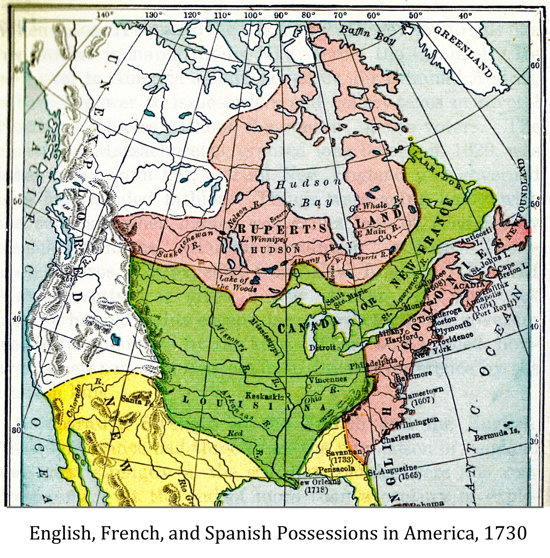
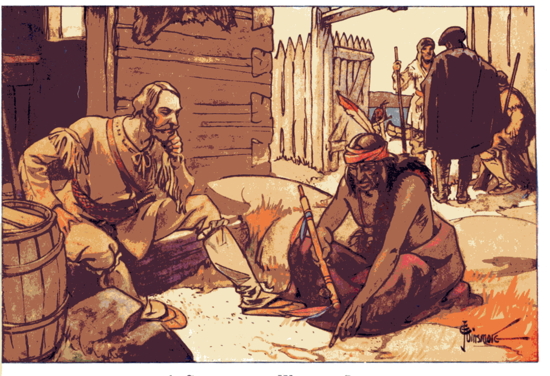
1731 Chief Ochagach tells La Verendrye about a big lake and from it a river running to the west, E. J. Dinsmore in A Picture History of Canada, 1942
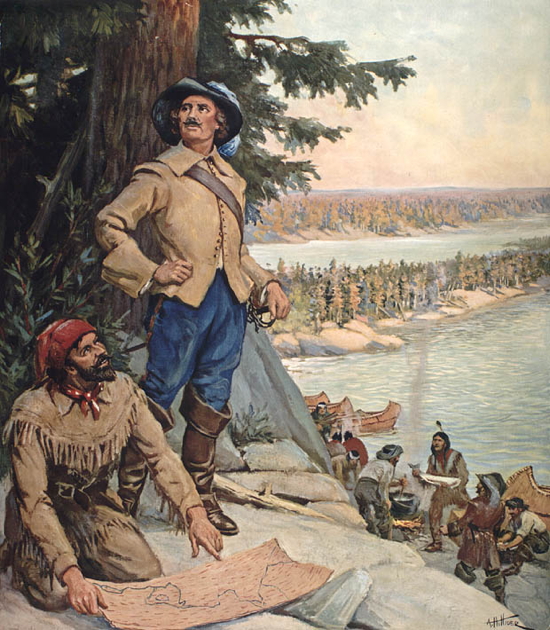
1732 La Vérendrye - le plus loin dans l'ouest canadien – 1732. La Vérendrye, Canada's Farthest West, 1732. LAC, Acc. No. 1973-22-1, John Innis 1920-1935 Gift of W.E. Gale, Vancouver, B.C.
"Champlain made the East. La Vérendrye grasped the West for the French."

1732 La Vérendrye - le plus loin dans l'ouest canadien – 1732. La Vérendrye, Canada's Farthest West, 1732. LAC, Acc. No. 1973-22-1, John Innis 1920-1935 Gift of W.E. Gale, Vancouver, B.C.
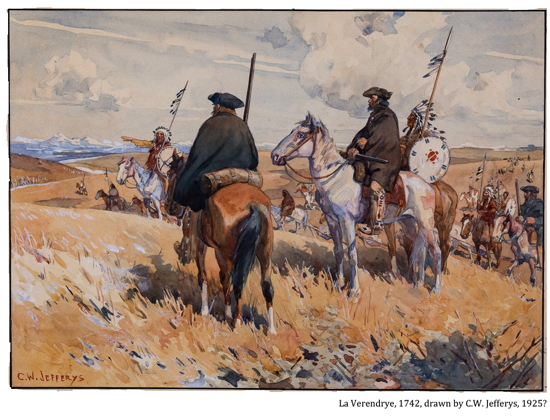
1742 La Verendrye. Acc. No. 1996-282-4, Charles William Jefferys 1925
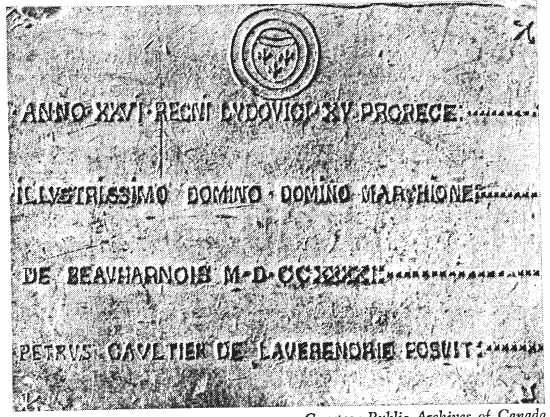
1743 La Vérendrye Plaque, known as the Cowley Plaque. The original La Vérendrye plate was discovered in Pierre, South Dakota sometime between 1913 and 1925. LAC, Acc. No. 1978-31-1M
"The trip [La Verendrye] across the continent would never have been successful had the Canadians not enjoyed the help and cooperation of Aboriginal nations all along the way."
Jacques Lacoursière and Robin Philipot
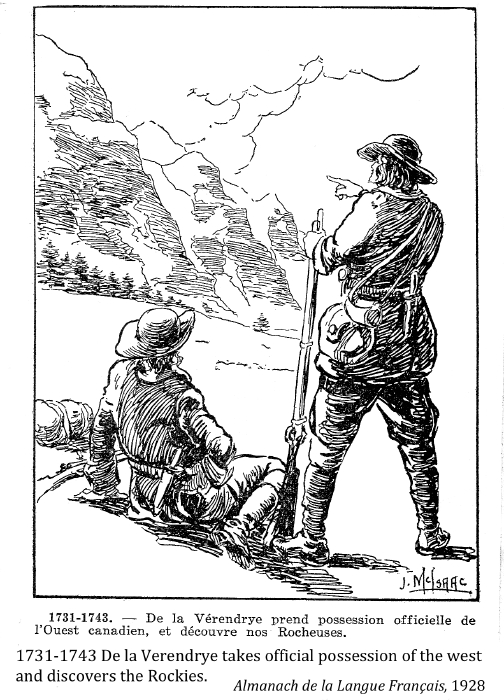
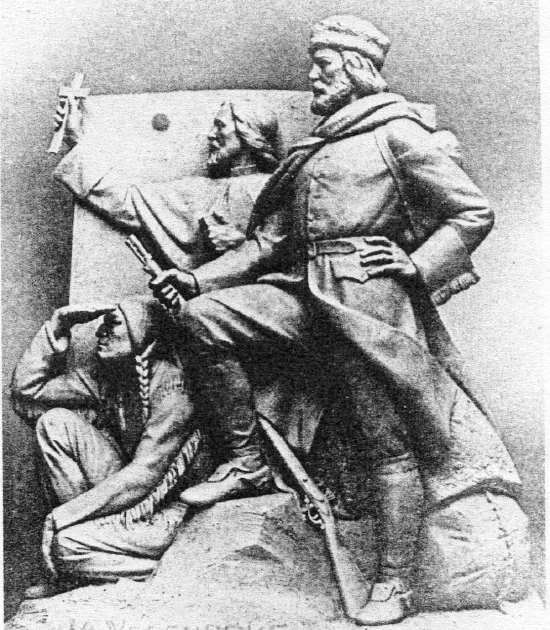
The largest figure is Pierre Gaultier de Varennes de La Vérendrye. Next to La Vérendrye stands a Jesuit missionary priest, Father Jean-Pierre Aulneau. The third figure is an unnamed Aboriginal guide. The inscription at the bottom of the monument reads: “LA VÉRENDRYE ISTAS INVENIT TERRAS EASQUE HUMANITATI ET FIDEI APERUIT.” La Vérendrye discovered these lands and opened them to humanity and the faith. Joseph-Émile Brunet, 1938.
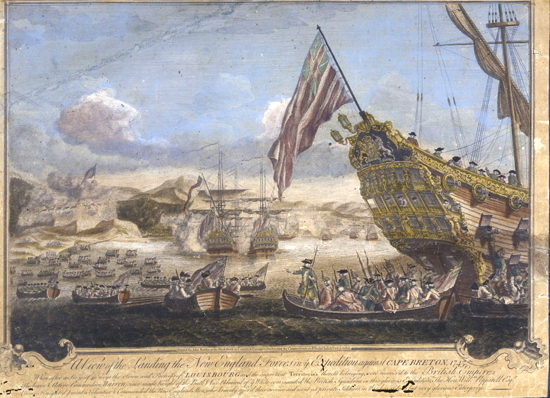
1745 The Expedition against Cape Breton in Nova Scotia, 1745. LAC, (R9266-3242) Peter Winkworth Collection of Canadiana, Carington Bowles. Cape Breton with the Important Fort of Louisbourg was taken (after a seige of 40 Days) by the New England Forces under the Command of the Honble. William/Pepperel Esqr. & a Squadron of his Majesty's Ships of War.
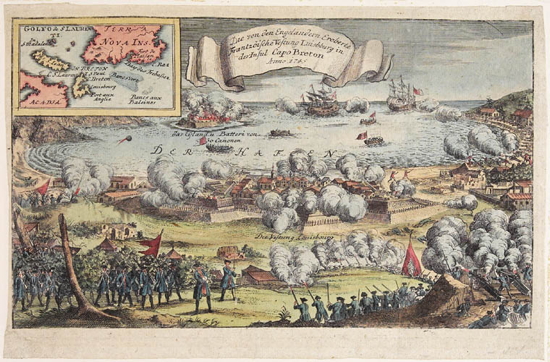
1745 Die Yon Den Engelandern Eroberte Frantzoische Vestung Luisburg in Der Insul Capo Breton Anno 1745. LAC, Acc. No. R9266-3273 Peter Winkworth Collection of Canadiana, artist unknown ca. 1745
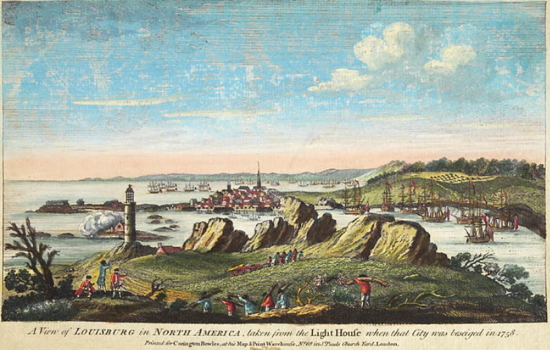
A view of Louisbourg. 11 Nov. 1762 LAC C-e000943097
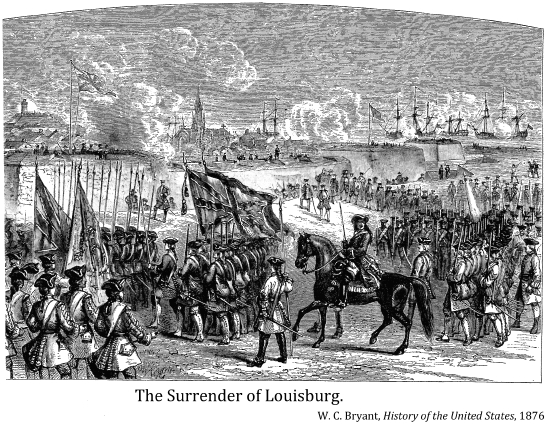
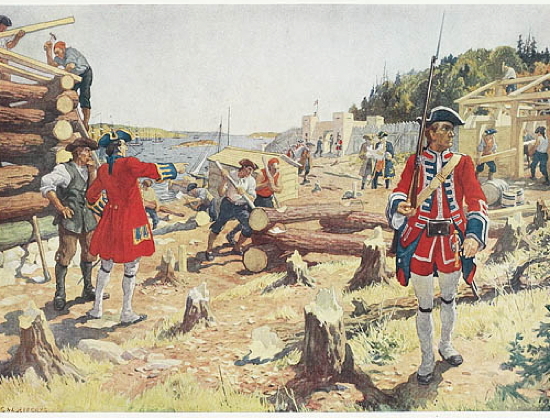
1749 Founding of Halifax. LAC, Canada Post Corporation

1750 The first published view of Halifax. LAC, Microfiche NMC1012, Thomas Jefferys 1750
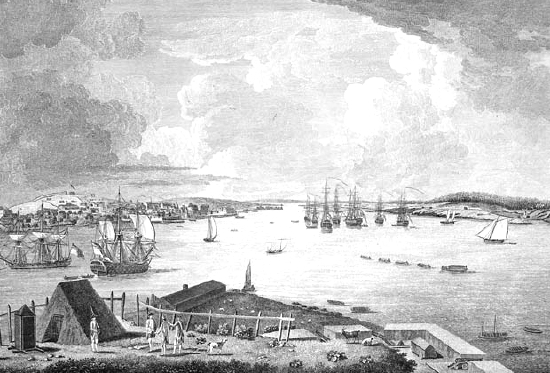
1764 Town and Harbour of Halifax in Nova Scotia. LAC, C-000054, James Mason 1764
"Louisbourg and Halifax are the symbols of a mighty struggle."
George M. Wrong
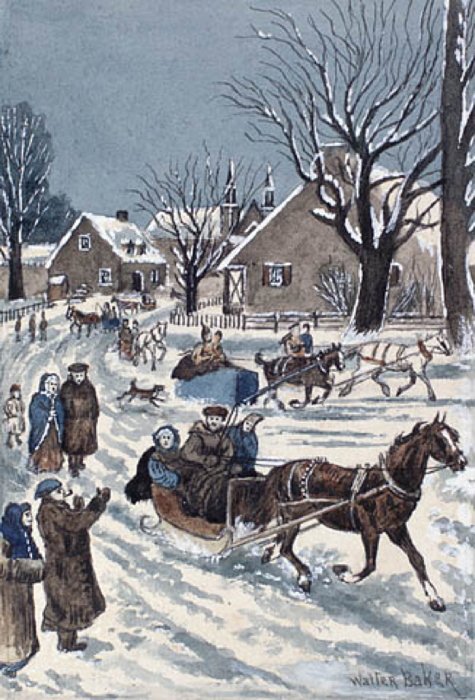
1750? Habitants revenant de la messe. Habitants Returning from Mass. LAC, 1989-514-33, Walter Baker 1900??
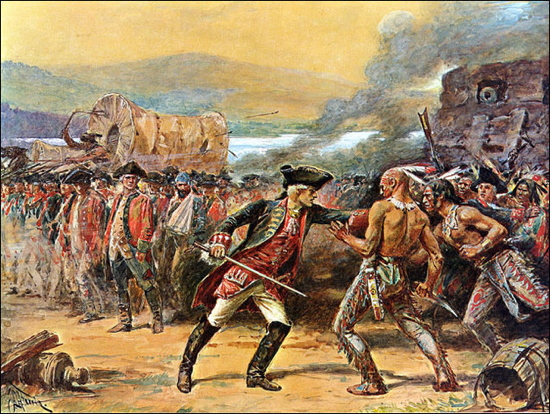
1754-63 French and Indian war
"The constant pattern of our early history thus emerges with great clarity; a strong farming settlement within a small domain; and surrounding this domain, satisfying an extraordinary need for action, for conquest, for missionary work, a vast unbounded territory for adventure, heroism, and glory. All around the pastoral, the immense epic."
Abbé Groulx
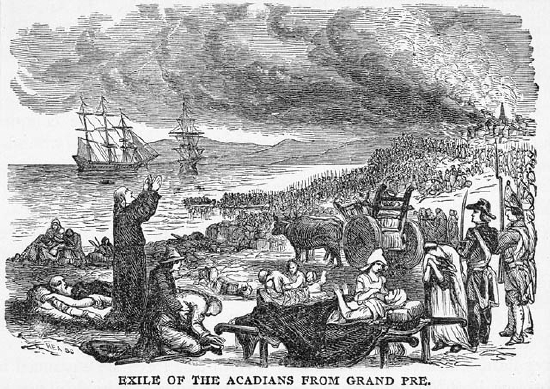
1755 Exile of the Acadians from Grand Pre. LAC, C-024549, 1850?
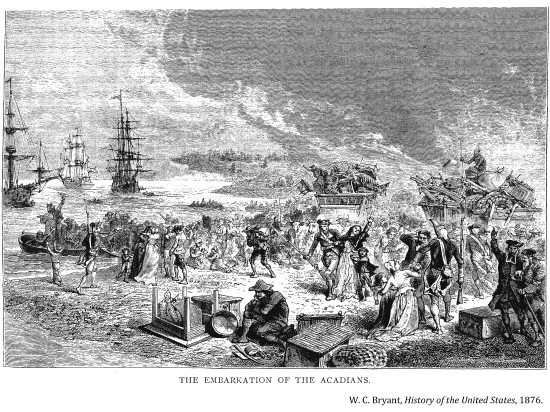
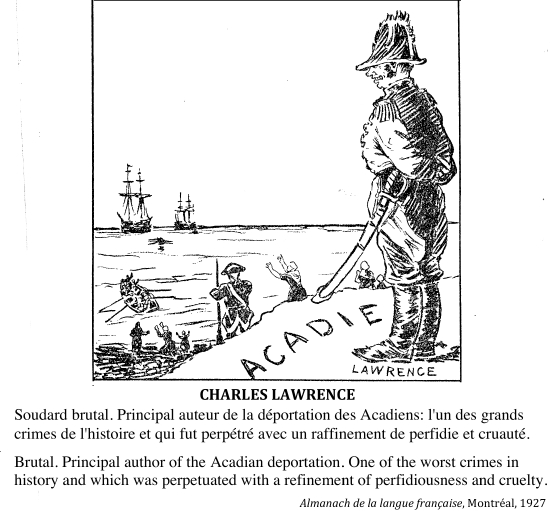
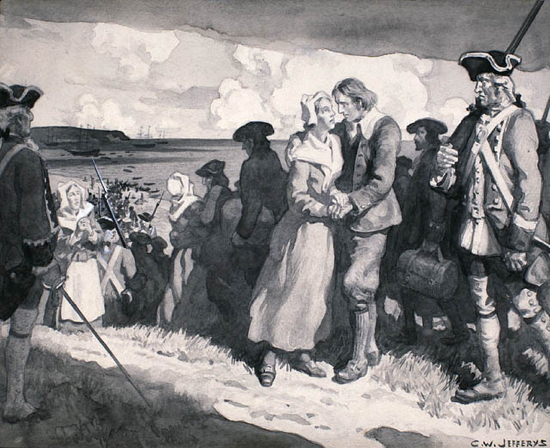
1755 Embarquement des Acadiens, 1755. Embarkation of the Acadians, 1755. LAC, Acc. No. 1972-26-587, Charles William Jefferys 1920s of 1930s?
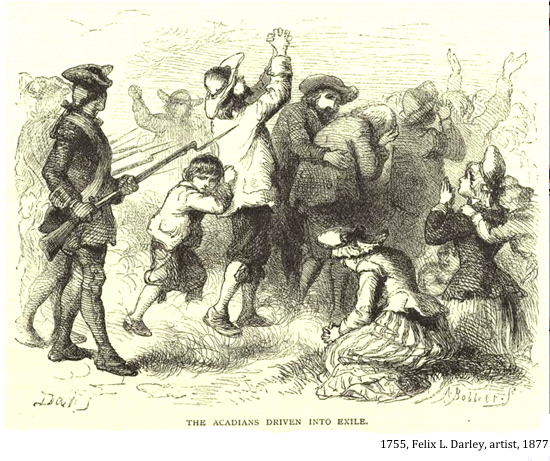
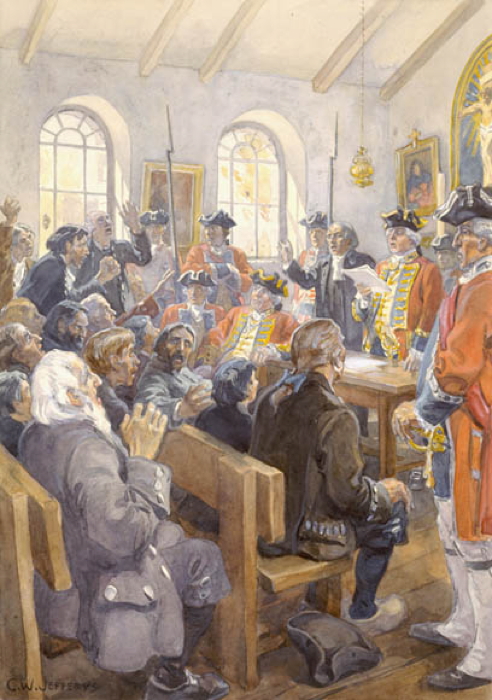
1755 Lecture de l'ordonnance d'expulsion des Acadiens dans l'église de Parish à Grand Pré, 1755. Reading the Order of expulsion to the Acadians in the parish Church at Grand Pre, in 1755. LAC, Acc. No. 1972-26-768, Charles William Jefferys 1920s or 1930s?
"The Acadian deportation was a North American affair . . . the lynch mob consisted of their American colonial neighbours, and the motive was the destruction of New France and control of the rich Ohio Valley, . . . This was for over a decade, as bloody and ruthless a landscape of racial and religious hatred and economic greed as we had been seeing in the Balkans of our television screens."
Mark Starowicz
"Here [the Seven Years War] the forest drama was more stirring, and the forest stage more thronged with appropriate actors, than in any other passage of our history . . . My theme fascinated me, and I was haunted with wilderness images day and night."
Francis Parkman
"Tell them . . . it is considered by some to be the first real world war, because it was fought on several continents, on every ocean on earth, with the five greatest navies that ever set sail, and the largest armies in the history of mankind – bigger than those of Rome and Carthage. Tell them it was literally a life-and-death struggle between global empires, and it changed the destiny of nations . . . It had also been a contest for America between North Americans."
Mark Starowicz
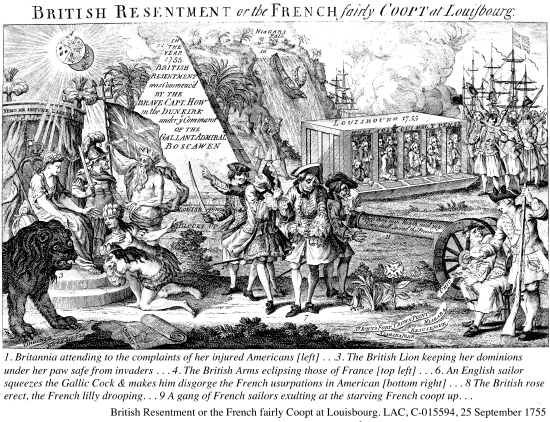

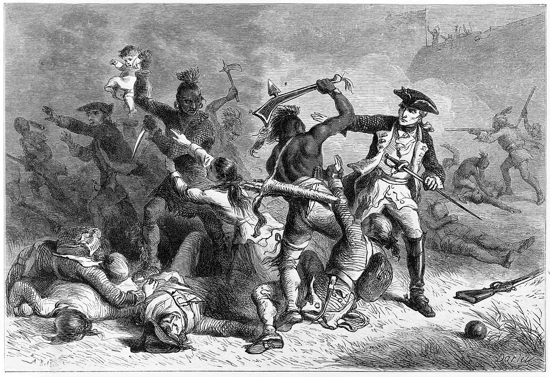
1757 08 Montcalm trying to stop the massacre Fort William Henry

1758 07 08 Battle of Ticonderoga, Carillon
"You know that these two nations [France and England] are at war for a few acres of snow, and that they are spending for this fine war more than all Canada is worth."
Voltaire, 1759
"When a house is on fire [France], you don't bother about the stables. [Quebec]"
Minister Berryer, French Minister for the Colonies, 1759
"It [New France] is a sinkhole for money and a sponge for the blood of France."
Voltaire
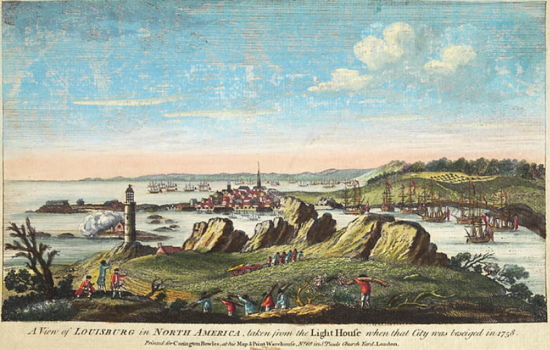
1762 A View in Louisburg in North America. This image depicts the city of Louisburg in the background, Gabarus Bay, the English Camp, the French Fleet, the Island Battery and the Lighthouse can beseen on the left. LAC, Acc. No. R9266-1588, Pierre-Charles Canot 11 November 1762
"The old 'drum and trumpet' history that emphasized tradition and glory through . . . noble or savage natives, and great heroes such as Wolfe and Montcalm, or Brock did not sit well with critical academic historians."
Tim Cook
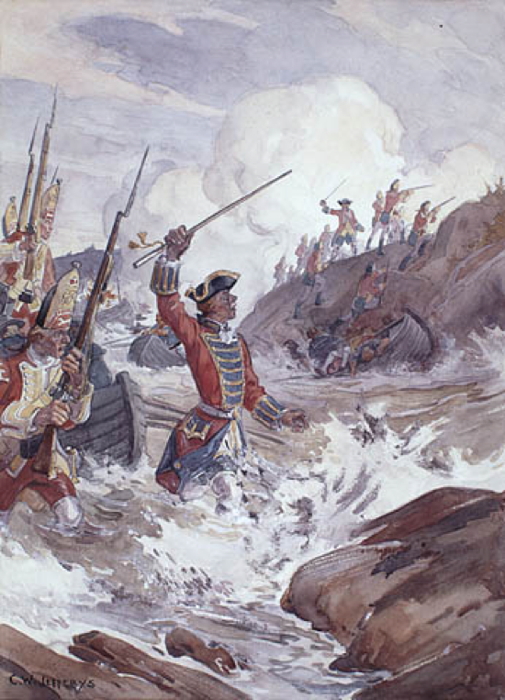
1758 Wolfe débarquant, à travers les vagues, sur la rive à Louisbourg. Wolfe wading ashore through the surf at Louisbourg. LAC, Acc. No. 1972-26-1381, Charles William Jefferys 1920s or 1930s
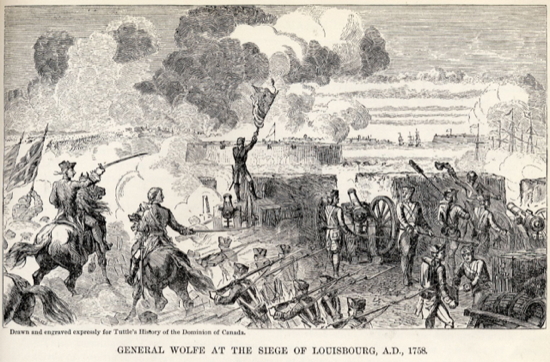
General Wolfe at the Siege of Louisbourg, 1758,, BAnQ
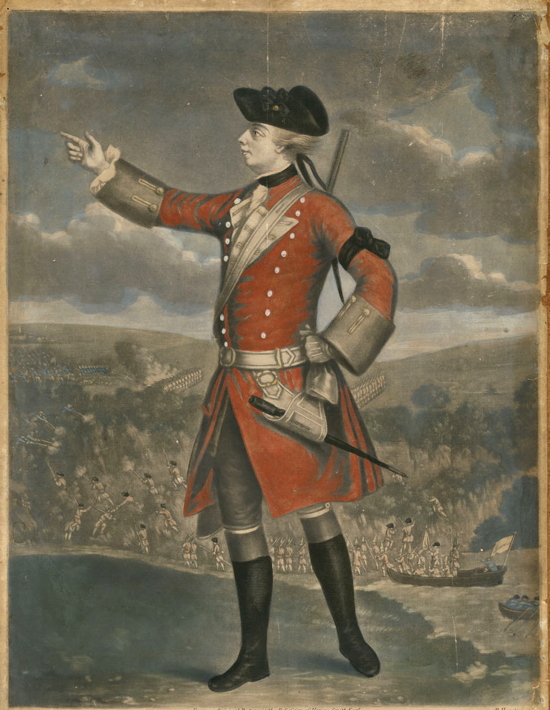
1759 08 00 Major General James Wolfe. LAC, Acc. No. 1992-485-3, Richard Houston 1766
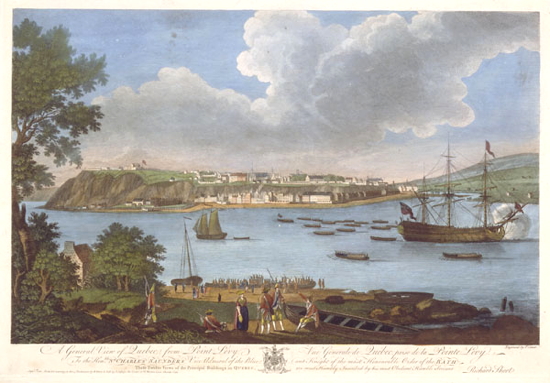
1759 07 00 Vue de Québec, prise de la Pointe de Lévy. A General View of Quebec, from Point Levy. LAC, Acc. No. 1989-283-1, Pierre-Charles Canot 1 September 1761
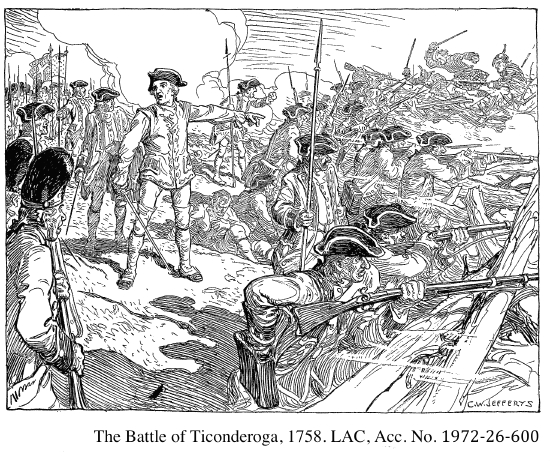

1759 A New chart of the River S. Laurence, from the Island of Anticosti, to the falls of Richelieu: with all the Islands, rocks, shoals, and soundings. Also particular directions for navigating the river with safety. Taken by order of Charles Saunders, Esqr. Vice-Admiral of the Blue, and Commander in Chief of His Majesty's ships in the expedition against Quebec in 1759. [cartographic material], LAC, NMC113508, Thomas Jefferys 1760

1759 A CORRECT PLAN of the ENVIRONS OF QUEBEC, and of the Battle fought on the 13th September, 1759: Together with a particular Detail of The French Lines and Batteries, and also of the Encampments, Batteries and attacks of the British Army, and the Investiture of that City under the Command of ICE ADMIRAL SAUNDERS, MAJOR GENERAL WOLFE, BRIGADIER GENERAL MONCTON, and BRIGADIE GENERAL TOWNSHEND. Drawn from the original Surveys taken by the Engineers of the Army. Engraved by THOMAS JEFFERYS, Geographer to His MAJESTY [cartographic material], LAC, C-123940
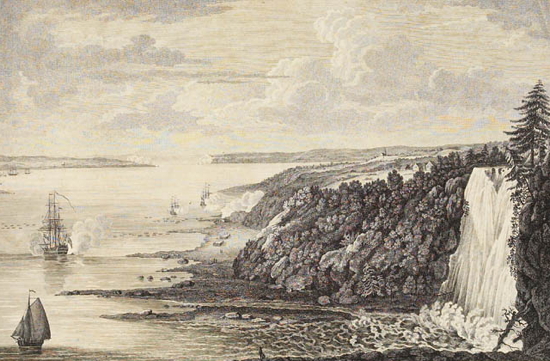
1759 07 31 A View of the Fall of Montmorenci and the Attack Made by General Wolfe on the French Entrenchments near Beauport with the Grenadiers of the Army, July 31, 1759. LAC, Acc. No. R9266-1109 Peter Winkworth Collection of Canadiana, William Elliot 1761
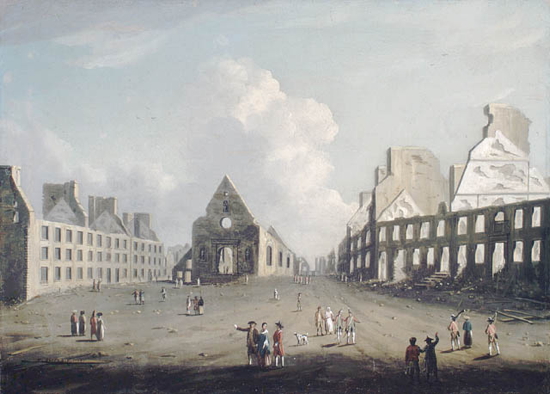
1759 Vue de la Cathédrale Notre-Dame -de-la-Victoire, Québec. A View of the Church of Notre-Dame de la Victoire [Quebec]. LAC, Acc. No. 1989-283-12, Richard Short unknown
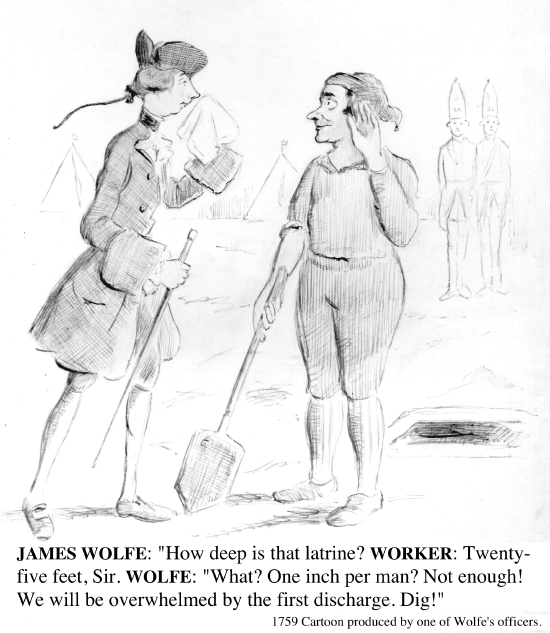
George Townsend, 1759
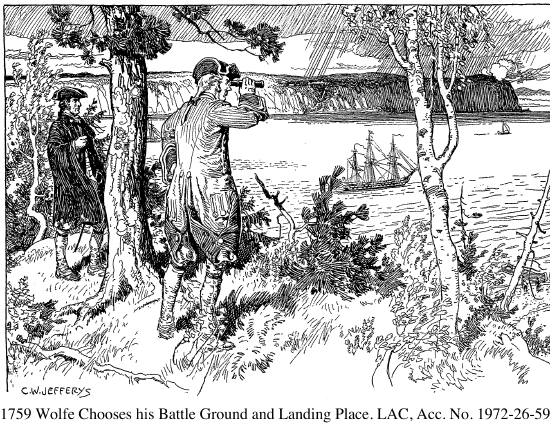
1920s or 1930s?
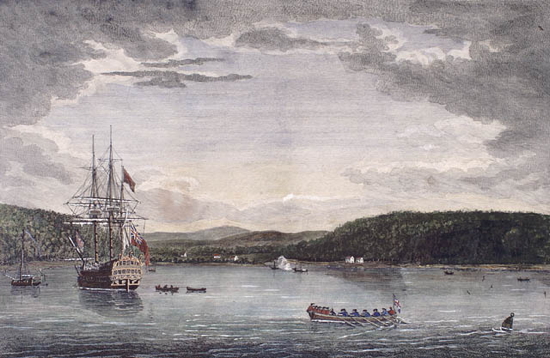
1759 Vue de cap Rouge ou Carouge, neuf milles en amont de Québec. A View of cap Rouge or Carouge, Nine Miles above the City of Quebec. LAC, C-000783, Peter Mazell 5 November 1760
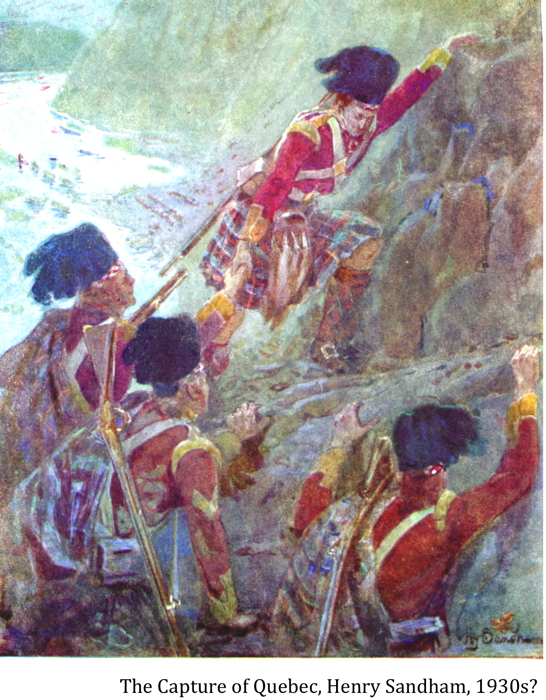

Montcalm's Headquarters with a distant view of Quebec, 1895, NAQ
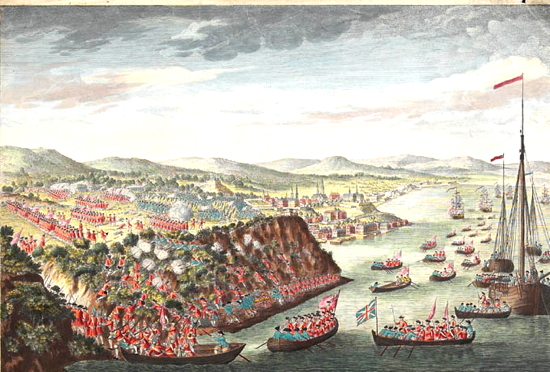
1759 09 13 A View of the Taking of Quebec, Sept 13, 1759. LAC, Acc. No. R9266-2102 Peter Winkworth Collection of Canadiana, after 1761
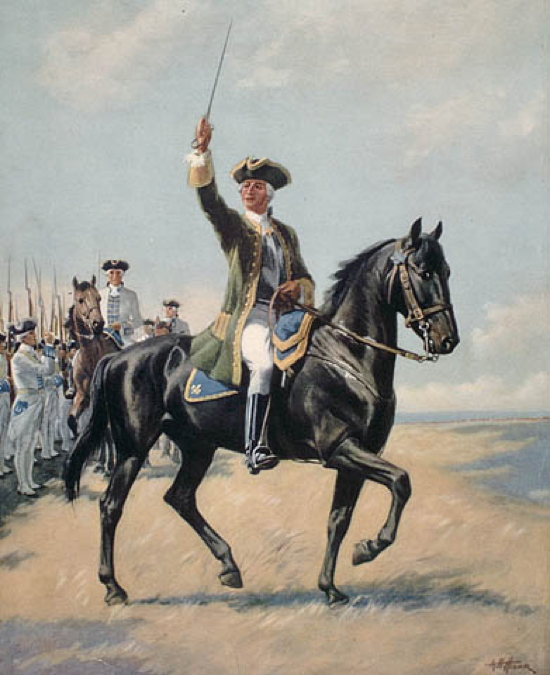
1759 09 13a Montcalm sur les Plaines d'Abraham, 1759. Montcalm on the Plains of Abraham, 1759. LAC, Acc. No. 1939-64-1, Arthur H. Hider
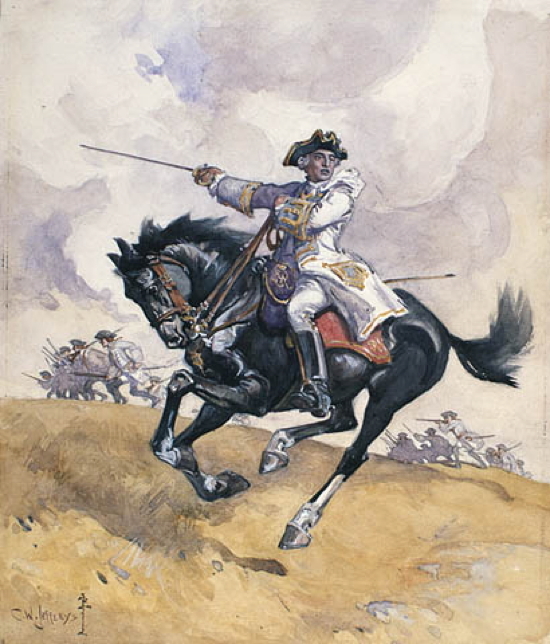
1759 Montcalm conduisant ses troupes aux Plaines d'Abraham. Montcalm leading his troops at Plains of Abraham. LAC, Acc. No. 1972-26-782, Charles William Jefferys ca. 1908
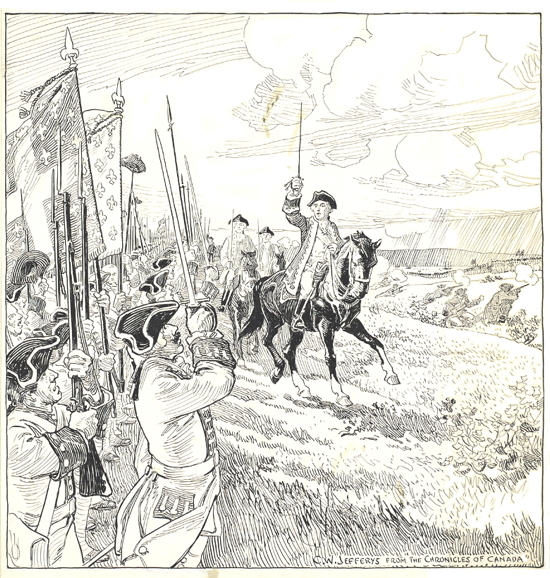
1759 Montcalm Riding Along the French Lines Before the Battle of the Plains. LAC, Acc. No. 1972-26-778, Charles William Jefferys, 1920s or 1930s?
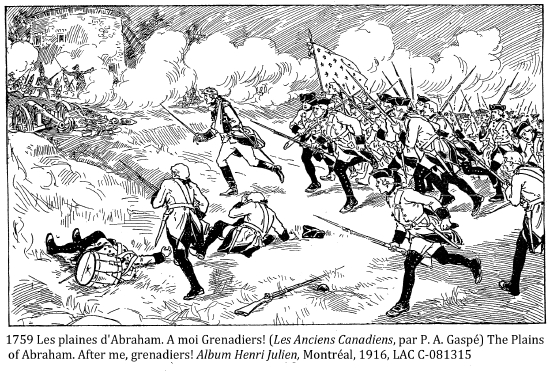
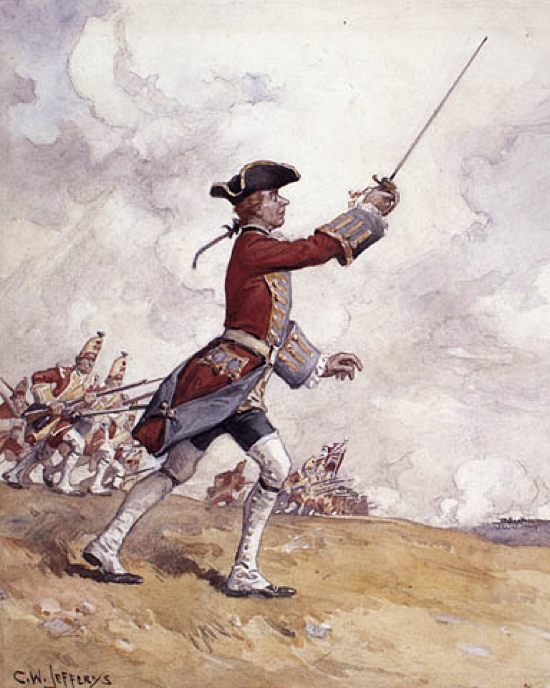
1759 Wolfe dirigeant son armée à la bataille des Plaines d'Abraham. Wolfe leading his army at the Battle of the Plains. LAC, Acc. No. 1972-26-1382, Charles William Jefferys, 1920s or 1930s?
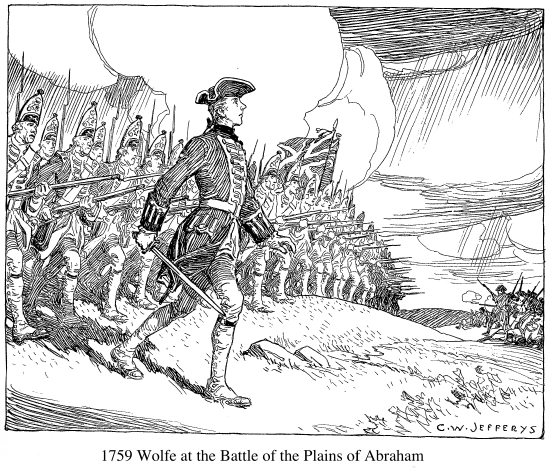
1920s or 1930s?
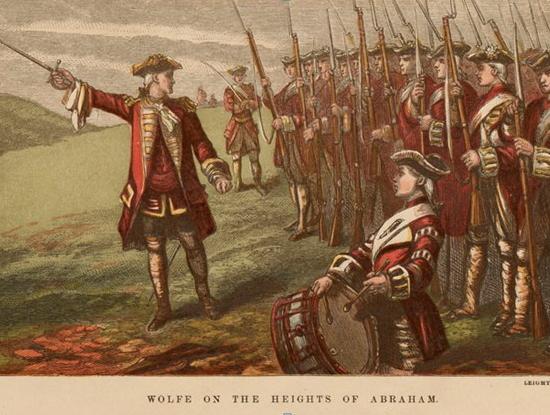
1759 Wolfe on the heights of Abraham. LAC, C-001082
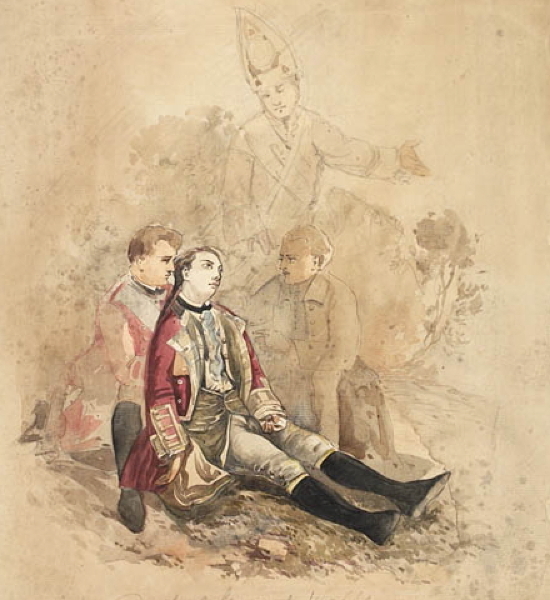
1759 La mort du général Wolfe lors de la bataille des Plaines d'Abraham, Québec, deJames Barry. Preparatory drawing for the engraved print of the Death of Wolfe by James Barry. LAC, Acc. No. R9266-335 Peter Winkworth Collection of Canadiana, Barry James 1763
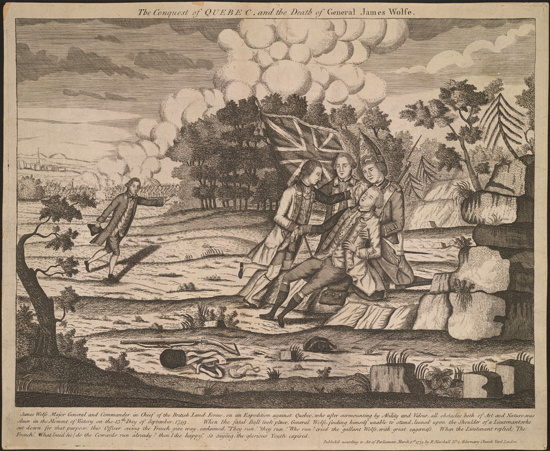
1759 The Conquest of Quebec and the Death of General James Wolfe. LAC, R13133-38, Publish'd according to Act of Parliament, William Henry Bartlett March 1st, 1774
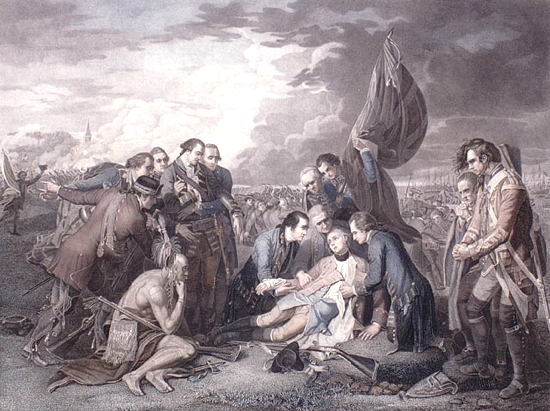
1759 Une vue de l'est de Montréal, au Canada. The Death of General Wolfe. LAC, R13133-378, engraving after the painting by Benjamin West, ca. 1776
https://en.wikipedia.org/wiki/The_Death_of_General_Wolfe
http://www.19thcenturyart-facos.com/artwork/death-general-wolfe
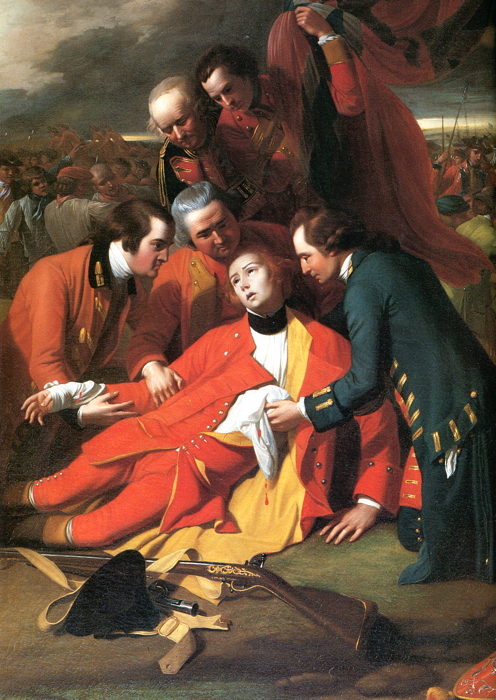
Death of Wolfe
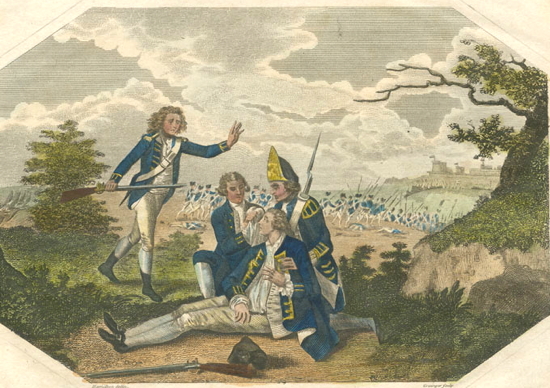
1759 The Death of General Wolfe at the Seige [sic] of Québec. Acc. No. 1973-18-237 The Source: R.W. Reford Estate, Montréal, Québec, Gavin Hamilton 1802
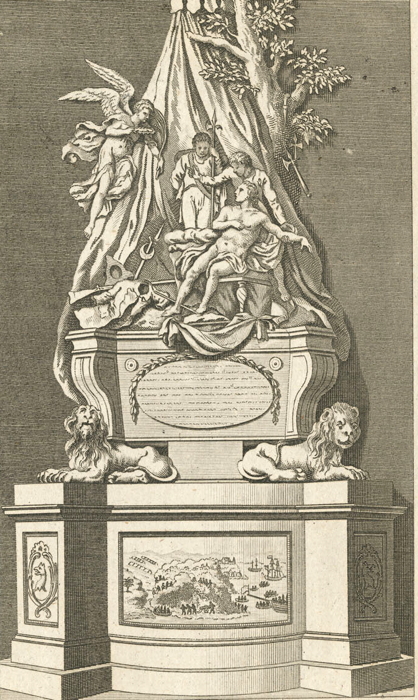
1760 General Wolfe's Monument in Westminster Abbey. LAC, Acc. No. 1968-140-17, 1812
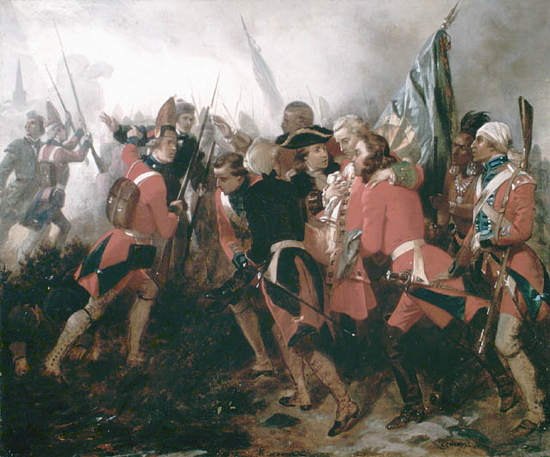
1759 Mort du général Wolfe. Death of General Wolfe. LAC, Acc. No. 1970-188-96, Alonzo Chappel 1857
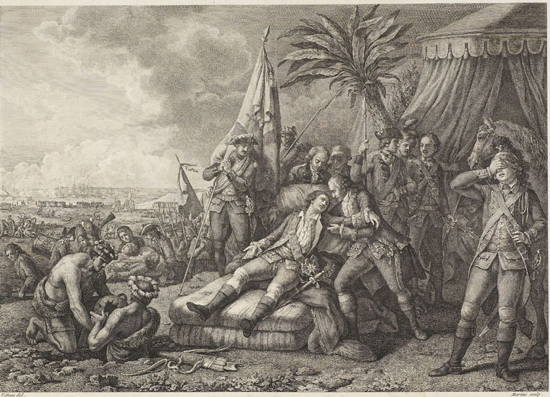
1759 Mort du Marquis de Montcalm. LAC, Acc. No. R9266-3091, Vateau date of reproduction unknown
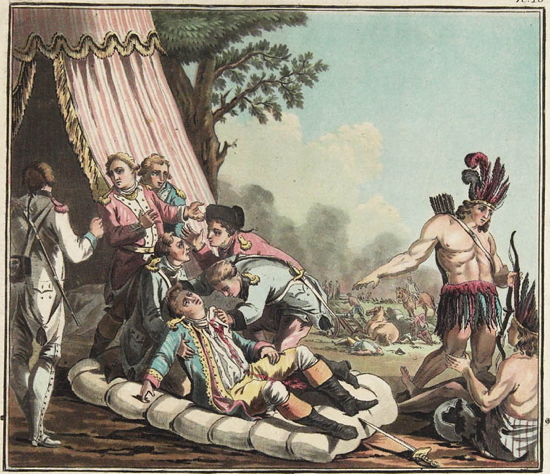
1759 Mort de Montcalm. LAC, Acc. No. R9266-3087, Desfontaines 1789
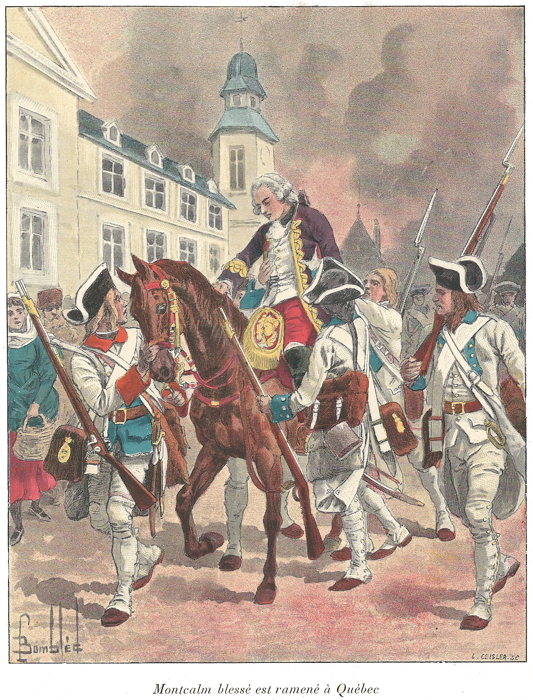
Histoire de la Nouvelle France, Euge`ne Gue´nin, 1900, Public domain, via Wikimedia Commons
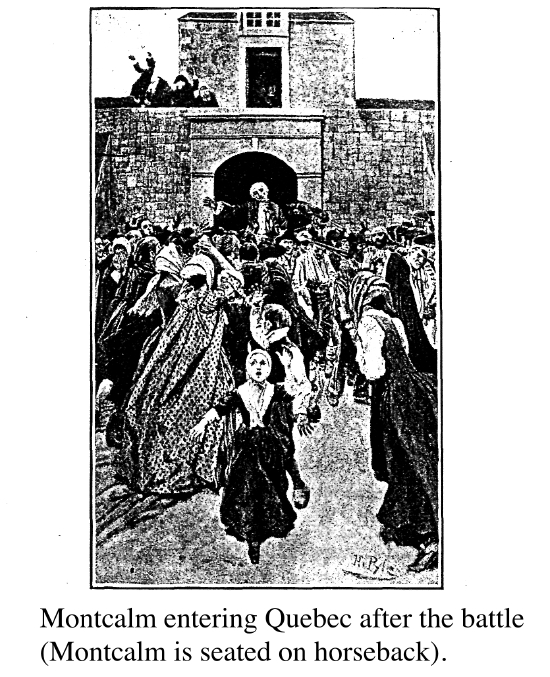
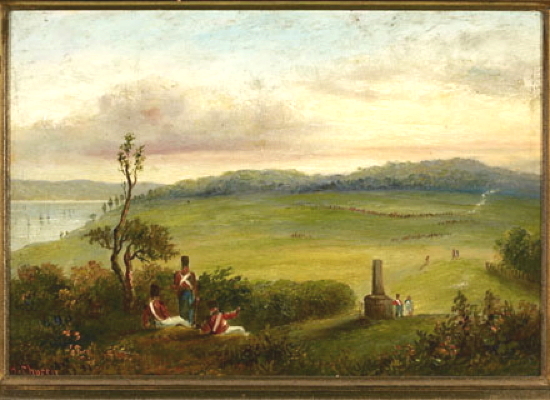
The Plains of Abraham, Québec City, (the place where Wolfe fell),Les plaines d'Abraham. près de Québec (endroit où le général Wolfe fut blessé), au Bas-Canada. LAC Acc. No. 1970-188-344 W.H. Coverdale Collection of Canadiana, W. H. Bartlett, ca. 1850
"The Battle of the Plains of Abraham lasted less than fifteen minutes. Yet those fifteen minutes were pivotal to the fate of an entire continent, to the French-Canadian people, to the Indian nations, to the fate of the French and British empires, and would set off chain of events that would bring about the American Revolution, the Loyalist flight, and the migration of millions of Europeans to the Canadian frontier."
Mark Starowicz
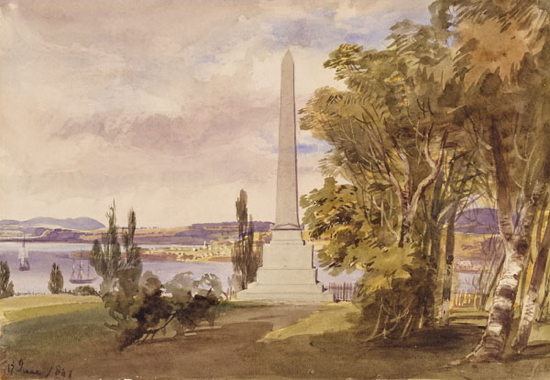
1759 Wolfe and Montcalm Monument, Quebec City, Canada East / Le monument à Wolfe et à Montcalm, à Québec, au Canada-Est. LAC, Acc. No. 1970-188-438 W.H. Coverdale Collection of Canadiana, James Hope-Wallace 1841
"Valour gave them [Wolfe and Montcalm] a common death, history a comm fame, posterity a common monument."
James C. Fisher, Monument, Quebec City, erected 1878
"In what country under the sun could you find a similar monument [to Wolfe and Montcalm], erected to the memory of the conqueror and the conquered? In what country under the sun could you find the names of the victor and vanquished honoured in the same degree, occupying the same place in the sentiment of the population."
Wilfrid Laurier, 26 June 1877
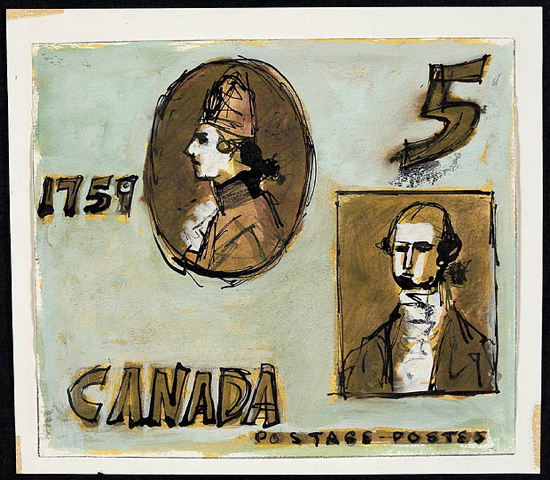
1759 1759 [Wolfe and Montcalm] [graphic material]. Copyright: Canada Post Corporation
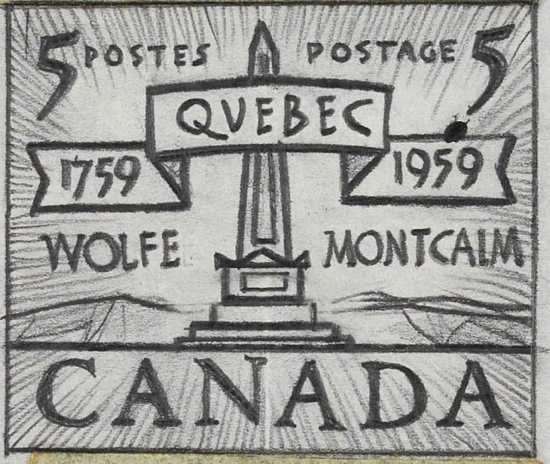
1759 Quebec, 1759-1959 [graphic material]. LAC, B102-09/X2 Item no. assigned by LAC 64 copyright: Canada Post Corporation, 1959?
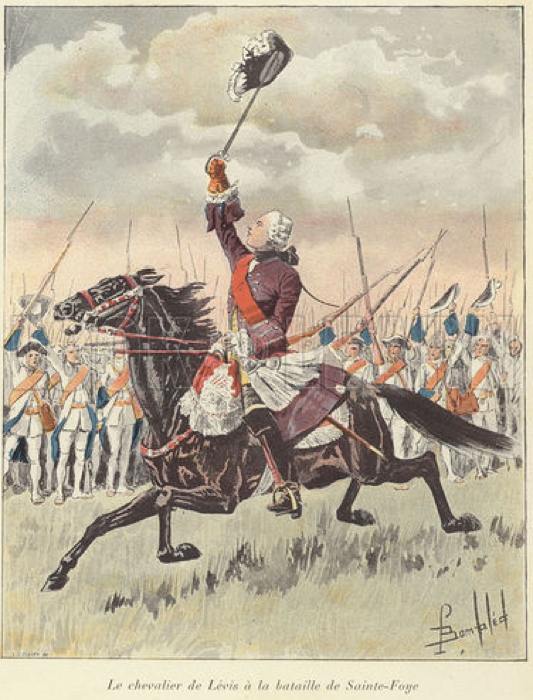
Le chevalier de Lévis ralliant son armée. Louis Bombled
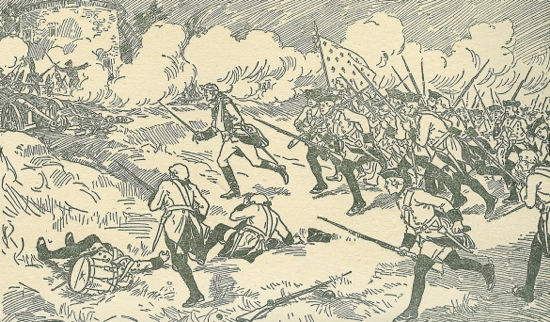
The Chevalier De Levis at the Battle of Sainte-Foy, 28 April 1760, LAC C-00770
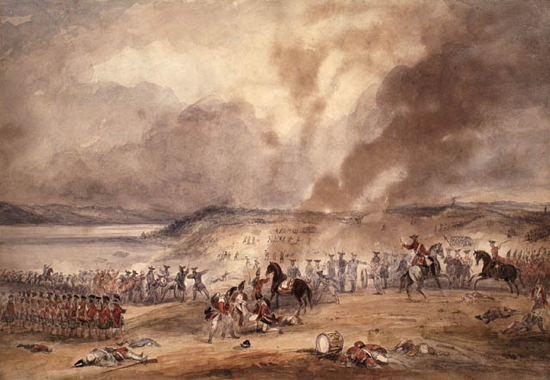
Représentation de la bataille des Québec (aussi décrit comme le bataille de Sainte-Foy), le 28 avril 1760. Representation of the Battle of Quebec (also known as the Battle of Sainte-Foy), April 28, 1760. LAC, Acc. No. 1993-326-1, George B. Campion, 1860
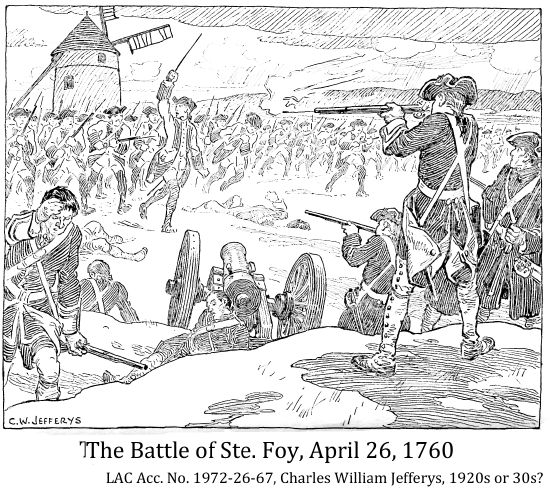
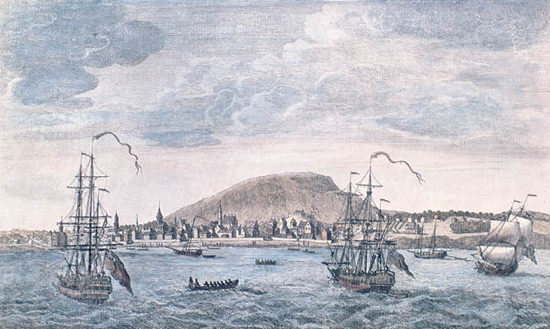
1762 Une vue de l'est de Montréal, au Canada. An East View of Montreal, in Canada. LAC, C-002433, Pierre-Charles Canot 11 November 1762
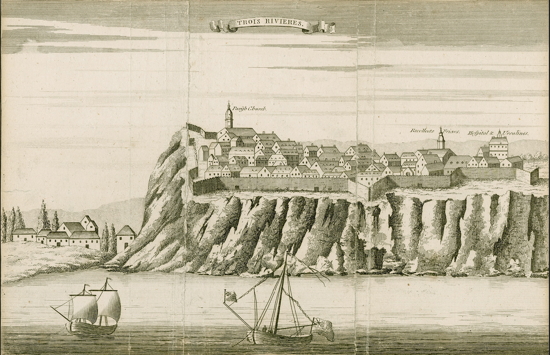
Trois Rivieres, Toronto Reference Library, JRR 1962 Cab II II, 1760
"The capture of Quebec in 1759 has been described as the most fateful, dramatic and important event in the history of the eighteenth century."
Christopher Hibbert
"If I only dared, I would implore you on my knees to rid France for ever from the administration of Canada. By losing Canada, you lose nothing; if you want her restored to you, you restore a perpetual source of war and humiliation – no more."
Voltaire, 1760
"Then there was 1760. We lost our empire, but we kept the stronghold of our agrarian position. Recoiled into our Laurentian soil, we girded our loins for an effort as moving and audacious as the conquest of America: our French survival."
Abbé Groulx
"The wound of 1760 has never closed completely."
Abbé Groulx
"Like the public, I greatly prefer peace to Canada, and I believe France could be happy without Quebec."
Voltaire, 6 September 1762
"Author Lyse Champagne has described the Conquest as the 'Big Bang' of Canadian history, 'hurling fragments of the past into the orbit of the future.'"
Will Ferguson, Maclean's, 30 September 2012
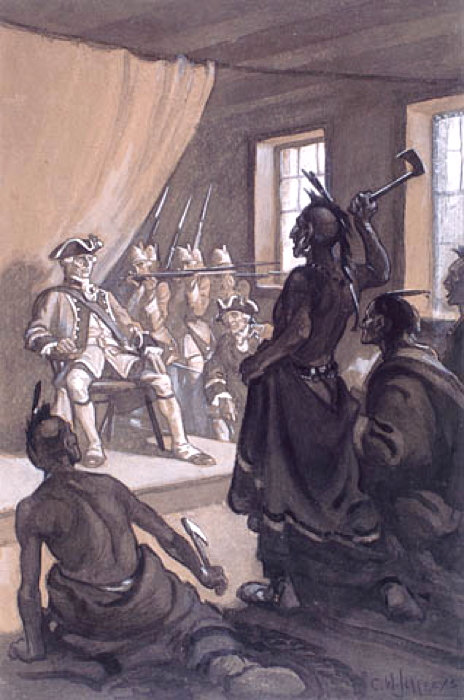
1765 Pontiac Meeting Governor Haldimand. Rencontre entre le chef des Ottawas Pontiac et le Gouverneur Haldimand. LAC, Acc. No. 1972-26-797, Charles William Jefferys 1925
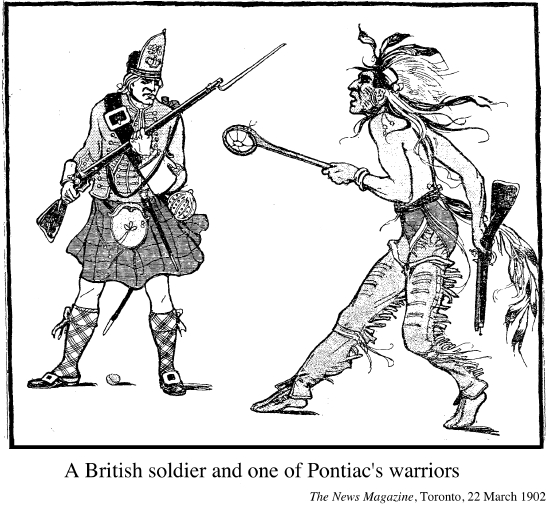

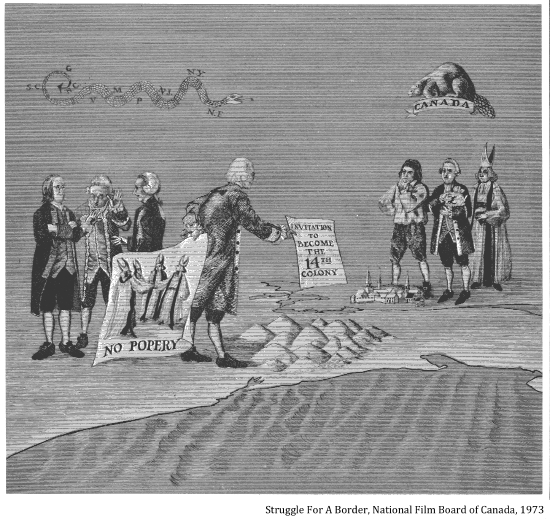
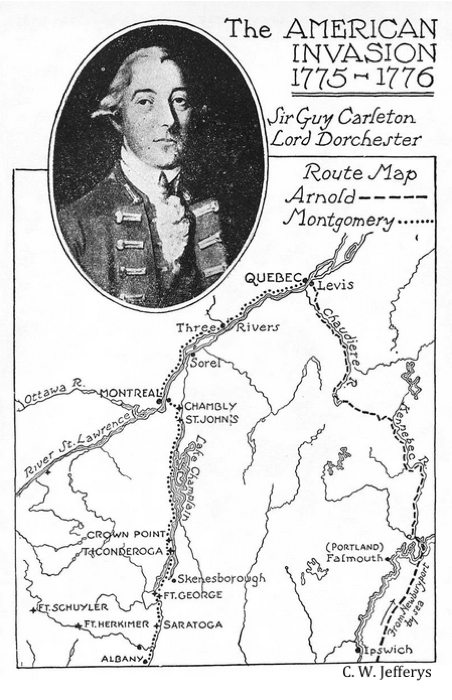
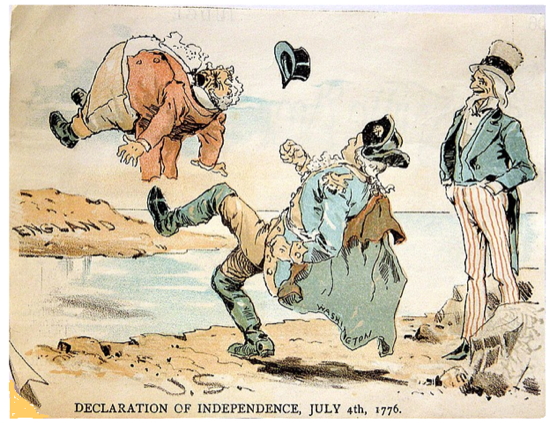
Declaration of Independence, 4 July 1776, Public Domain, via Wikimedia Commons drawn 1890

Treaty of Paris 1783
Print shows five men, an Englishman, a Dutchman, a Native representing America, a Spaniard, and a Frenchman urinating into a pot. The Englishman says, "Say what they will, I call this an honourable P--," the Native says, "I call this a free and Independent
P--," and the Frenchman says, "Jack English we confess your exceeding good nature, tho' we have wrangled you out of America you freely make P-- with us." Five swords, two drums, and the flags of the respective nations rest on the ground before the pot.
Come all who love friendship, and wonder and see,
The belligerent powers, like good neighbours agree,
A little time past Sirs, who would have thought this,
That they’d so soon come to a general P––.
The wife politicians who differ in thought,
Will fret at this friendship, and call it to nought,
And blades that love war will be storming at this,
But storm as they will, it’s a general P–––.
A hundred hard millions in war have spent,
And America lost by all patriots consent,
Yet let us be quiet, not any one hiss,
But rejoice at this hearty and general P–––.
Tis vain for to fret or growl at our lot,
You see they’re determined to fill us a pot,
So now my brave Britons excuse me in this
That I for a Peace am obliged to write Piss.
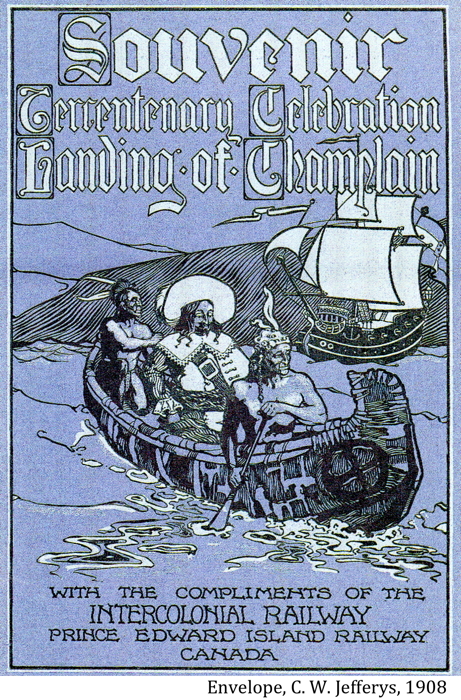
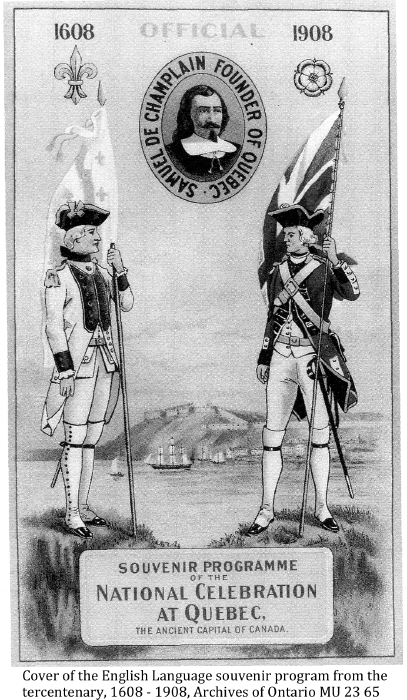
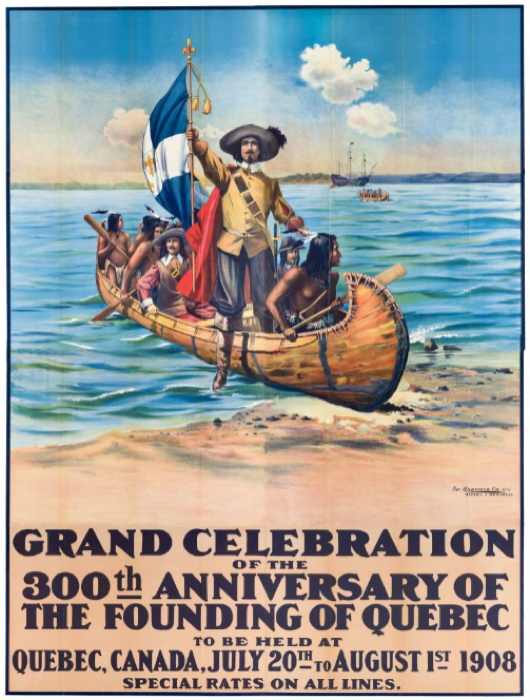
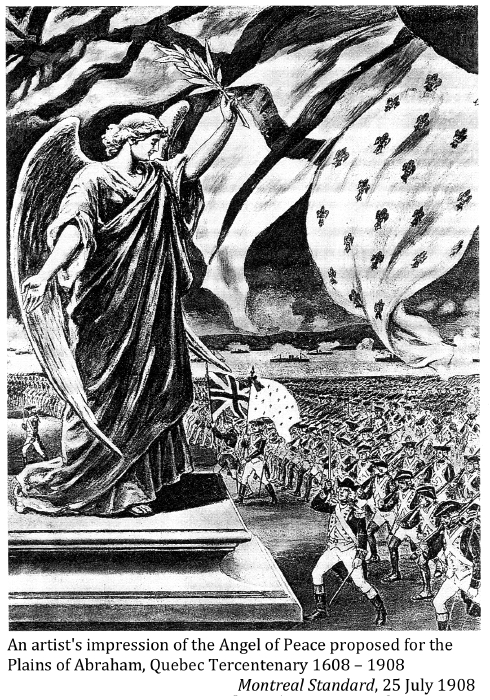
"In days of yore, from Britain's shore,
Wolfe, the dauntless hero came,
And planted firm Britannia's flag
On Canada's fair domain.
Here may it wave, our boast and pride,
And, joined in love together,
The Thistle, Shamrock, Rose entwine
The Maple Leaf forever!"
Alexander Muir, 1867
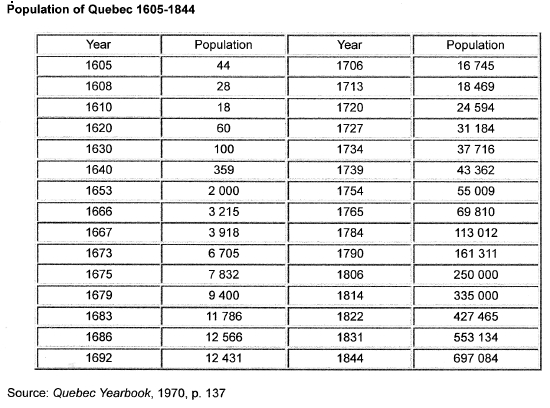
|




































































%20John%20David%20Kelly%20TRL%20948-1%20Cab%20III.jpg)











































































%20John%20David%20Kelly%20artist%20LAC%201967-49-4%20painted%201943%20e011201598.jpg)



































































































































